
CHONDO, VIRUNGA NATIONAL PARK, DEMOCRATIC REPUBLIC OF CONGO, MARCH 2012: A combined team of ICCN Congolese conservation rangers and members of the Congolese army patrol an area known to have a FDLR rebel presence, Chondo, Virunga, 12 March 2012. The FDLR are the hardcore Hutu's who were behind the Rwandan massacre of 1994. Since they fled into the DRC and the park after the Genocide, they have sown mayhem and destruction in Virunga. 140 Rangers have died defending Virunga since 1994, many at the hands of the FDLR rebels. There are regular contacts between the Rangers and FDLR, usually resulting in injuries and deaths on either side. The Rangers, with the help of the FARDC, are winning this battle but at a heavy price. In 2011 eleven Rangers died fighting the FDLR. Virunga remains one of the most dangerous places in the world to practise conservation. (Photo by Brent Stirton/Reportage for GEO magazine.)
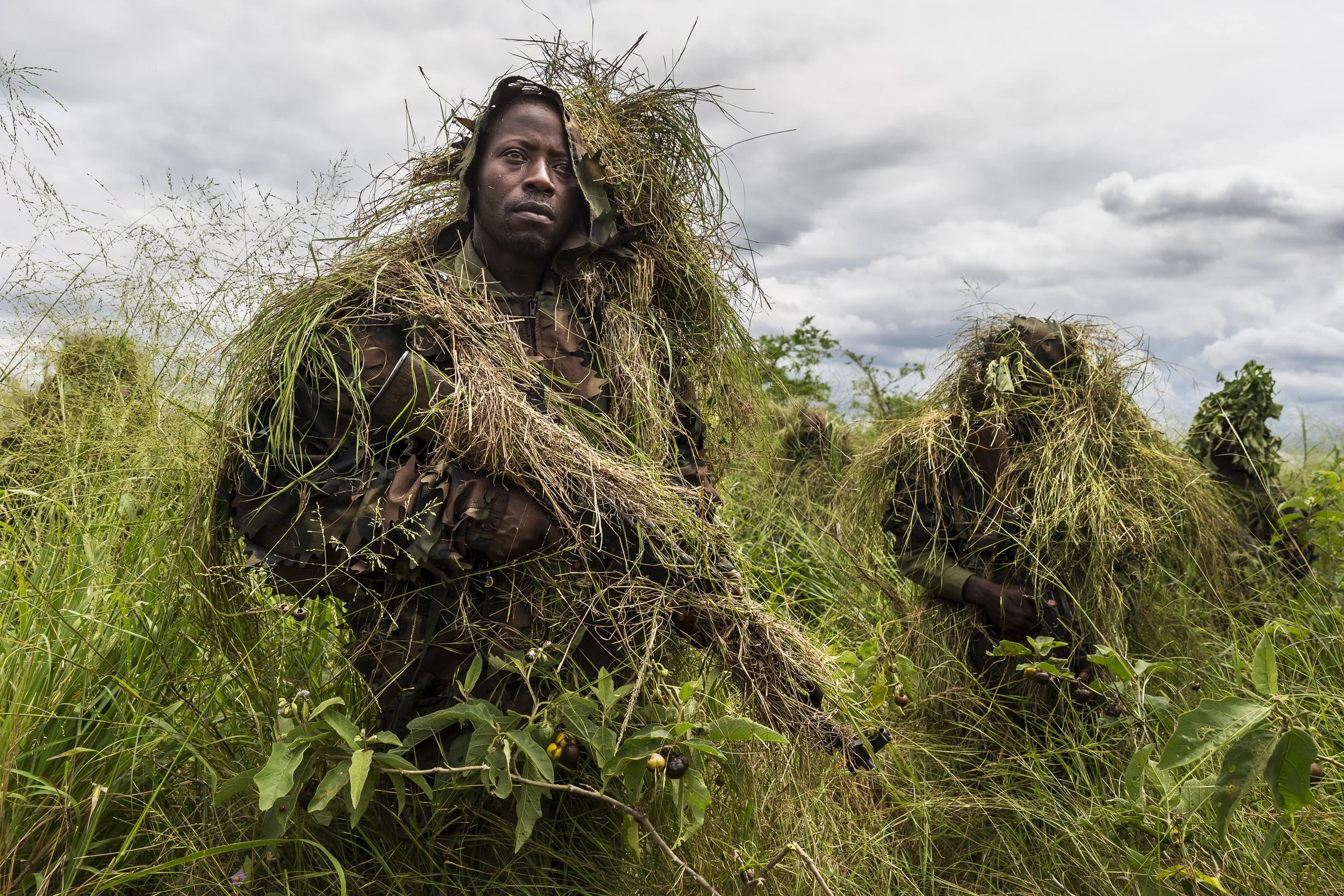
ISHANGO, VIRUNGA NATIONAL PARK, DEMOCRATIC REPUBLIC OF CONGO, 6 MAY 2015: European Union commissioned instructors teach Virunga National Park rangers skills for concealment, bush craft, weapons and survival in their fight against paramilitary groups and poachers in the Park. Groups like the Hutu led FDLR and Ugandan ADF continue to make conservation problematic and dangerous inside Virunga, well known as one of the worlds most dangerous places to practice conservation. This group is a smaller subset of Rangers who will receive specialized training for a quick reaction force. (Photo by Brent Stirton/Reportage by Getty Images for National Geographic Magazine.)

BUKIMA, VIRUNGA NATIONAL PARK, EASTERN CONGO, JULY 2007: Conservation Rangers from an Anti-Poaching unit work with locals to evacuate the bodies of four Mountain Gorrillas killed in mysterious circumstances in the park, Virunga National Park, Eastern Congo, 24 July 2007. A Silver-Back Alpha male, the leader of the group was shot, three females were also killed. Two of the females had babies and the other was pregnant. The two babies were not found and it is thought that they will have died of stress and dehydration. The motivation for the killing is not known but it is suspected that there are political motivations. The local illegal Charcoal industry clashes with conservation efforts in this very poor area and Rangers have been threatened, tortured and killed as a result of this clash of political and economic wills. Over 100 Rangers have been killed in their efforts to protect the Gorrillas of Virunga, one of the world's most endangered species. The Congolese Rangers in this particular group are working with Wildlife Direct, a Conservation organisation. The Rangers receive a salary based on donations to Wildlife Direct and perform one of the most dangerous jobs in the world of wildlife conservation. The DRC has the highest toll of human casualties of any country since the second world war, a figure in the region of 4.6 million dead as a result of war and resultant displacement, disease, starvation and ongoing militia violence. (Photo by Brent Stirton/Getty Images for Newsweek.)
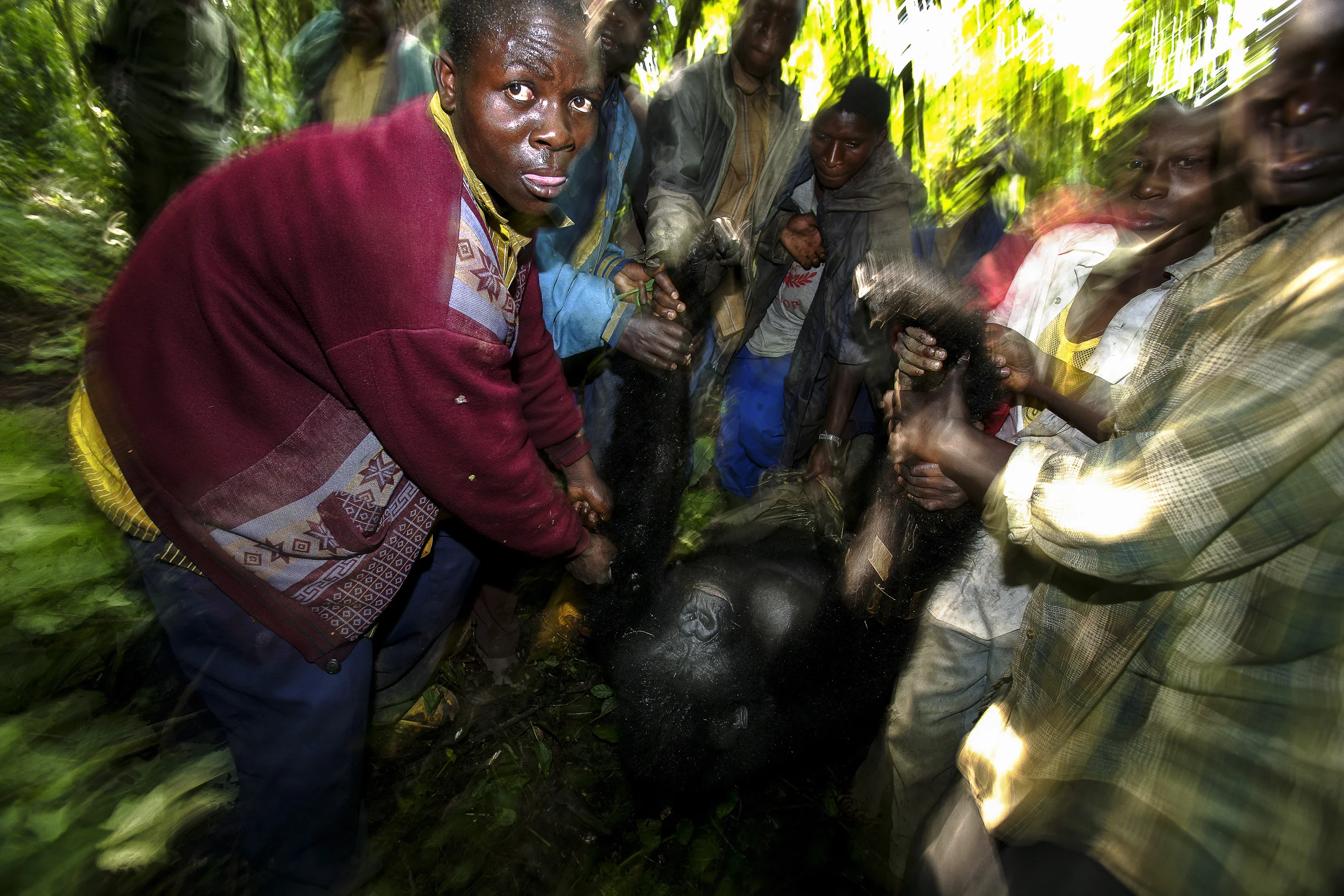
MIKENO, EASTERN DR CONGO, 8 APRIL 2009: Local villagers help to evacuate the body of a female mountain gorilla who has been shot by poachers. It is believed that her baby had been taken by these poachers so they could try to sell it to the highest bidder. Mountain Gorillas are extremely rare, with just over 700 in the world today. They exist in the Virunga ranges of DR Congo, Rwanda and Uganda. The group in DR Congo numbers just over 300 and their region is occupied by the M23 rebel group, formerly known as CNDP. Despite the conflict in the region, the gorillas remain, a fragile, threatened group that also have poachers and human encroachment to fear. The Senkwekwe Center is the only facility for critically endangered orphan mountain gorillas in the world. It is located in Virunga National Park, Democratic Republic of Congo, about 50 kilometers from the border town of Goma. Each gorilla at the center has suffered a traumatic poaching experience, injuries from snares, and/or losing their mothers in brutal killings. These baby gorillas were kept in horrifying conditions, close to death, until their rescue by Congolese Conservation forces. Now they are looked after by a dedicated group of conservation ranger caretakers. The center is located in a large forested enclosure with a night house and veterinarian facilities. The caretakers are with the newest orphan Ihirwe 24/7. They sleep in the same room, often holding the new orphan like fathers would a child. They interact like a family, the gorillas displaying extraordinary behavior towards their caretakers indicative of a loving and trusting relationship. In early 2009, the rangers and warden of Virunga National Park re-gained control of the gorillas sector of Virunga National Park following the takeover by General Nkunda and his CNDP rebel army. At that time awareness was raised about two young orphan mountain gorillas, Ndeze and Ndakasi, and their living conditions in a small compound in the city of Goma, full of poll

LULIMBI, EASTERN DRC, FEBRUARY 2012: ICCN Conservation Rangers deploy young bloodhounds for the first time in Virunga to investigate the corpse of a recently killed sub-adult male elephant in Lulimbi, Eastern DRC, February 29, 2012. The elephant had obviously been killed for its ivory, a trend on the rise across the DRC and one which makes the Rangers job very difficult. The young dogs reacted with horror at the elephant corpse, their noses are estimated to be 3 million times more sensitive than a humans. After initially recoiling, the lead dog Lily, just over a year old, took the scent and followed it for several kilometers in the exact direction of a fishing village on Lake Edward long suspected in poaching cases in Virunga. She was pulled off the trail once Rangers knew where the suspects came from. Undercover intelligence will now be used in the village to seek out the sellers. (Photo by Brent Stirton/Reportage for Geo magazine.)
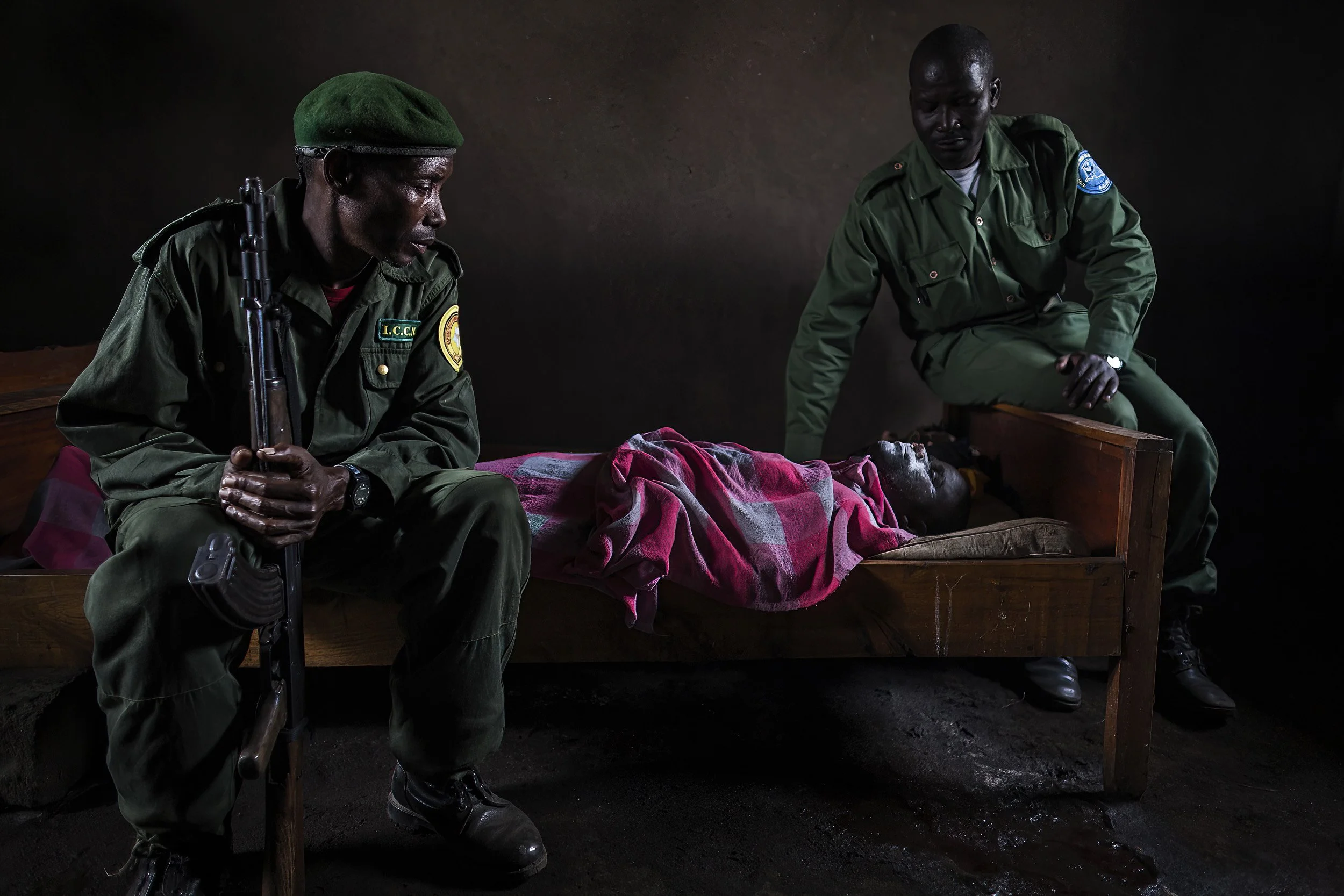
ISHANGO RANGER STATION, NORTHERN SECTOR, VIRUNGA NATIONAL PARK, NORTH KIVU, RUWENZORI, DEMOCRATIC REPUBLIC OF CONGO-27 FEBRUARY 2008: ICCN Ranger Kambale Kalibumba was killed today by a rogue rebel soldier who shot the Ranger 5 times at close range. At the time the Ranger was in the park on the way to the Ishango post with rations for the patrol. More than 140 rangers have died in the last ten years as a result of their work in Virunga National Park. These pictures depict the dead ranger at the local Red Cross clinic in the village and the body being delivered to the Ishango Ranger Station to be driven to Mutsora Ranger station, the headquarters for the Northern Sector region. (Photo by Brent Stirton/Reportage for National Geographic Magazine.)

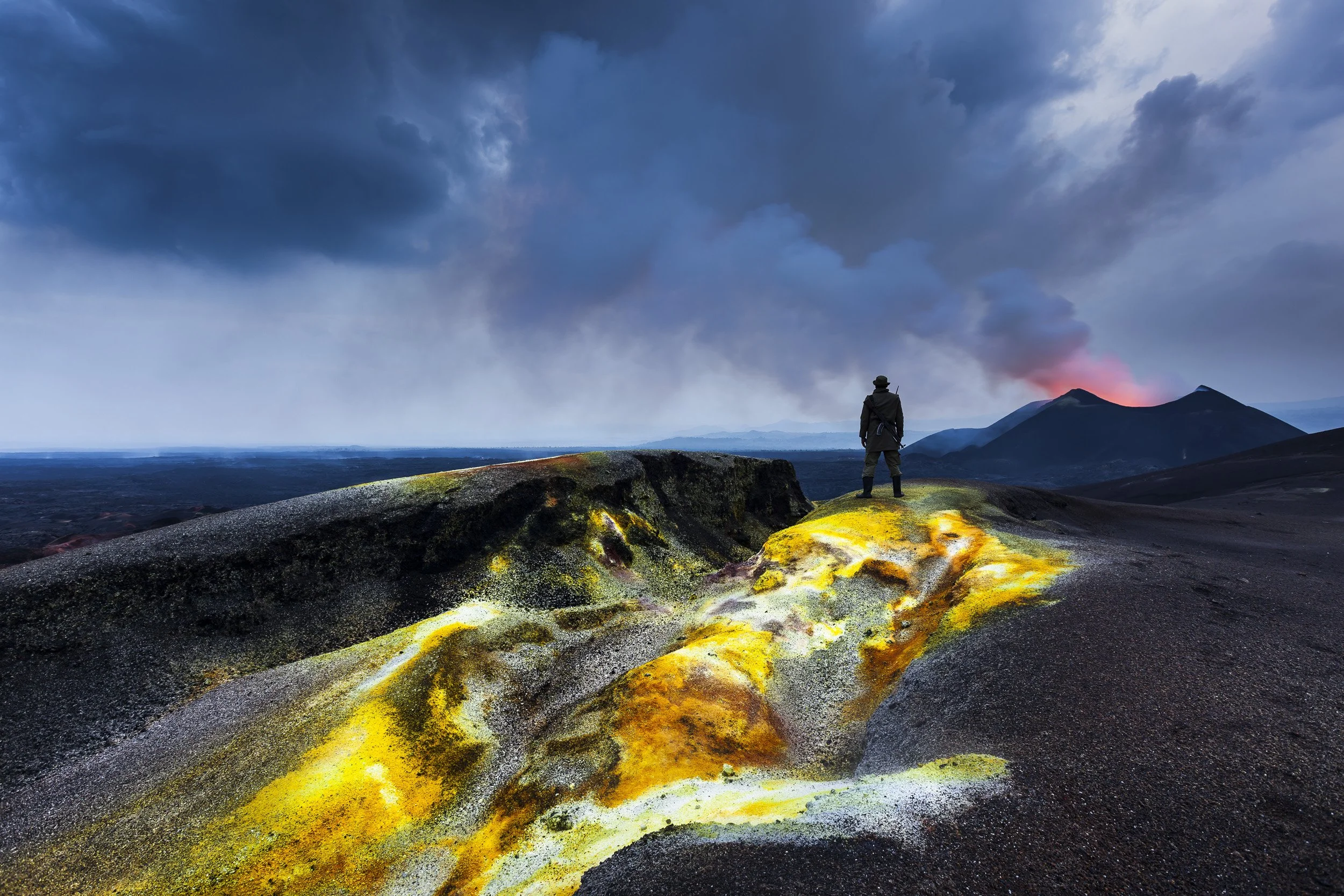
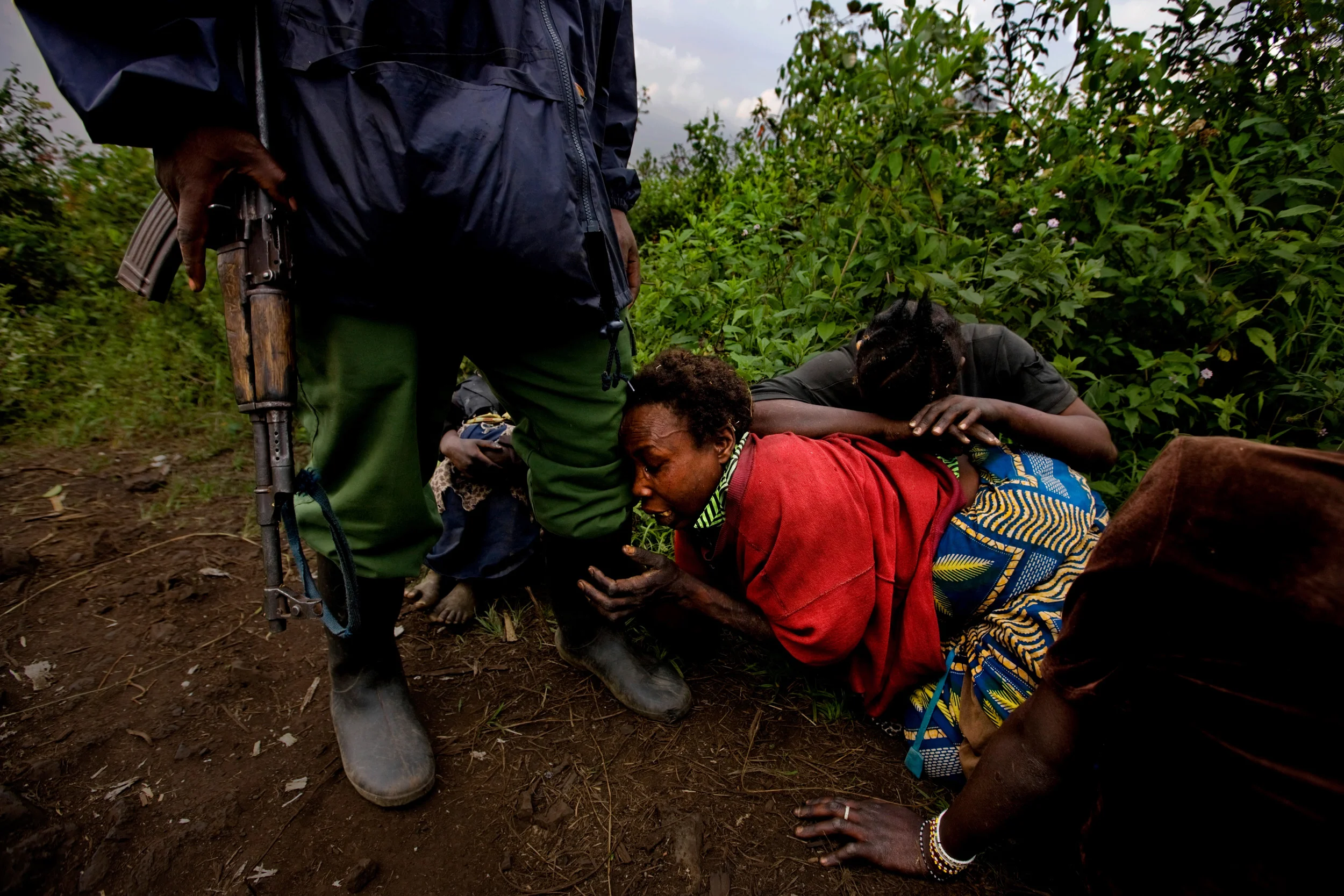
KIBATI, CLOSE TO GOMA, VIRUNGA NATIONAL PARK,NORTH KIVU, DEMOCRATIC REPUBLIC OF CONGO-23 FEBRUARY 2008: ICCN Rangers conduct a raiding patrol into an area of illegal Charcoal production. They arrested a number of mules, poor people from displaced communities who are being used by the real powers behind Charcoal production in the area. These players include members of the Congolese military, the FDLR Interhamwe rebels and big businessmen in Goma. The ICCN Rangers were shot at by FDLR as they were completing their mission. This is an area known to be under their influence. ICCN Advance Force rangers at the Kibati Station are conducting roadblocks and vehicle searches for illegal charcoal in Virunga National Park. They are being assisted by members of the Congolese military police who are looking to stamp out their own military's involment in the illegal charcoal industry. The ICCN Ranger's job is complicated by the large number of Congolese military travelling on many of the vehicles and also by the fact that the Charcoal producers are increasingly turning to military vehicles as their means of transport as the Rangers until today had no rights to search vehicles of the Congolese Army. There is complicity between bad elements of the Congolese military, the rebel FDLR Interhamwe militias in the Charcoal industry, rumoured to be worth around 30 million dollars a year in the Goma region of DRC. Rwanda recently banned the production of charcoal which has led to increased prices and demand. The ranger's job is further complicated by the fact that the area is desperately poor and people have a hard time accepting this ban on one of the very few opportunities they feel they have to actually make some money. (Photo by Brent Stirton. ) For verification phone Rob Muir +243 997251960 in Goma.

CHONDO, VIRUNGA NATIONAL PARK, DEMOCRATIC REPUBLIC OF CONGO, MARCH 2012: ICCN Congolese conservation rangers and members of the Congolese army capture illegal fisherman, Chondo, Virunga, 12 March 2012. Many of these fisherman are involved in this activity due to poverty, others are there to supply the rebel FDLR group with food. The FDLR are the hardcore Hutu's who were behind the Rwandan massacre of 1994. The fish stocks in the lake are just beginning to recover from the war, thousands of hippos were slaughtered to feed militia groups and this devastated fish stocks. This delicate recovery is what the ICCN rangers are trying to protect. This will allow a viable and sustainable fishing industry to be generated at Lake Edward, for the benefit of all. Since the FDLR fled into Virunga after the Genocide, they have sown mayhem and destruction in Virunga. 140 Rangers have died defending Virunga since 1994, many at the hands of the FDLR rebels. There are regular contacts between the Rangers and FDLR, usually resulting in injuries and deaths on either side. The Rangers, with the help of the FARDC, are winning this battle but at a heavy price. In 2011 eleven Rangers died fighting the FDLR. Virunga remains one of the most dangerous places in the world to practise conservation. (Photo by Brent Stirton/Reportage for GEO magazine.)

RUMANGABO, NORTH KIVU, DEMOCRATIC REPUBLIC OF CONGO, 28 NOVEMBER 2015: The funeral of ICCN Ranger Theodore Mbusa Matofali, 27, after a tragic car accident which left him dead from head injuries. Over 150 ICCN rangers have died in the course of their duties in Virunga National Park, most of those deaths have resulted from conflict. The Rangers have a dangerous job, often dealing with rebel movements, paramilitary Mai-Mai groups as well as the Congolese army all in the name of conservation in this contentious region of the DRC. (photo by Brent Stirton/Reportage for National Geographic Magazine.)

RIFIJI, SELOUS, TANZANIA, 4 MARCH 2013: Yusuf Shabani Difika, 41, lost both his arms to a lion attack on a fishing trip on the border of Selous National Park, Tanzania. The lion attacked Yusuf and his arms were shredded beyond recovery as he attempted to fend off the animal. He says the lion bit him multiple times on his arms, exposing his bones and ripping off the flesh. Yusuf was rescued by village friends who drove the lion off with sticks and machettes. Yusuf was rushed to a local clinic and then transported to a hospital where doctors had no choice but to amputate what was left of his arms. Yusuf has two children, aged 5 and 3, he has lost the ability to work and is entirely reliant on his father, his uncle and his cousins as well as the kindness of his village for his survival. He says the hardest thing is that he cannot clean himself or go to the bathroom without assistance. His uncle bathes him on a regular basis and his father and cousins help him to dress, eat and drink. Lion attacks on the rural people who farm close to Selous National Park are not uncommon. There is a degree of hypocrisy to the West's expectation that these people should live with lions as if there is no danger. They do not benefit from the wildlife in Selous and they live in danger as there are no fences to the Park and the range of the lions often extends outside of the park. They are especially in vulnerable during the harvest period. Wild Bush pigs are attracted by young maize and rice crops and so people sleep in their fields in order to protect their crops. Rural people are especially exposed to lion attacks at this time. The lions are attracted to the bushpig presence, the pigs are hard to catch and the human beings are close at hand, often completely vulnerable and easy to subdue.

NORTH WEST PROVINCE, SOUTH AFRICA, OCTOBER 2012: Professional hunters fool around with a dead captive bred lioness after a bow hunt on a game farm close to the South Africa/Botswana border region, October 19, 2012. Two systems for the hunts exist in two different provinces of South Africa. One practice sees the lion released for a minimal 96 hours into a 3000-hectare area before the hunt can begin. The other practice sees the lion released for 3 months into a minimum 3000-hectare area before it can be hunted. The lioness in these images was released 96 hours ahead of the hunt into the area. Recent global research points to the fact that hunting and breeding programs are necessary components for the survival of lions into the future. These practices go some way towards lessening pressure on wild lion populations as well as preserving a strong lion DNA base and a future repository for lions for areas where they have been decimated. The hunting industry is also a strong employer in Africa, with over 1.4 million square kilometers given over to hunting concessions. This is a landmass more than 20% higher than that given over to Wildlife Conservation areas. More than 18000 hunters come to Africa every year and the money high-end dangerous game hunting brings to the continent goes some way to preserving the land mass set aside for hunting.

NORTH WEST PROVINCE, SOUTH AFRICA, OCTOBER 2012: A captive bred lion is skinned after a hunt close to the South Africa/Botswana border, October 19, 2012. Two systems for the hunts exist in two different provinces of South Africa. One practice sees the lion released for a minimal 96 hours into a 3000-hectare area before the hunt can begin. The other practice sees the lion released for 3 months into a minimum 3000-hectare area before it can be hunted. The lioness in these images was released 96 hours ahead of the hunt into the area. Recent global research points to the fact that hunting and breeding programs are necessary components for the survival of lions into the future. These practices go some way towards lessening pressure on wild lion populations as well as preserving a strong lion DNA base and a future repository for lions for areas where they have been decimated. The hunting industry is also a strong employer in Africa, with over 1.4 million square kilometers given over to hunting concessions. This is a landmass more than 20% higher than that given over to Wildlife Conservation areas. More than 18000 hunters come to Africa every year and the money high-end dangerous game hunting brings to the continent goes some way to preserving the land mass set aside for hunting.

NORTH WEST PROVINCE, SOUTH AFRICA, OCTOBER 2012: Over 40 carcasses from lion hunts hang up to dry in a vehicle yard on a farm in the North West Province, South Africa, October 19, 2012. These bones come from lions killed in legal hunts. The dealer requires a local permit for Nature Conservation South Africa as well as a Cites export permit for this trade. There is a large Asian market for these bones, which are crushed and used in Asian medicines and also in Lion Wine. Lion bone has become more popular in Asian culture as a result of the increasing rarity of the Tiger. Tiger parts have long been a part of Asian traditional medicine, but with less than 3000 tigers left in the wild, lion bone is becoming increasingly popular. Conservationists argue that this increasing demand for lion bone will severely impact wild lion populations. Hunters and breeders argue that they can easily meet the demand and that a legal trade means wild lion populations as well as tiger populations will be saved as captive breeding and hunting of those lions can meet the demand. Prices for a lion skeleton vary, from $1200 to $10, 000. South Africa is the lion hunting and breeding capital of the world, with an estimated 500 plus lions hunted every year and the largest breeding programs in the world.
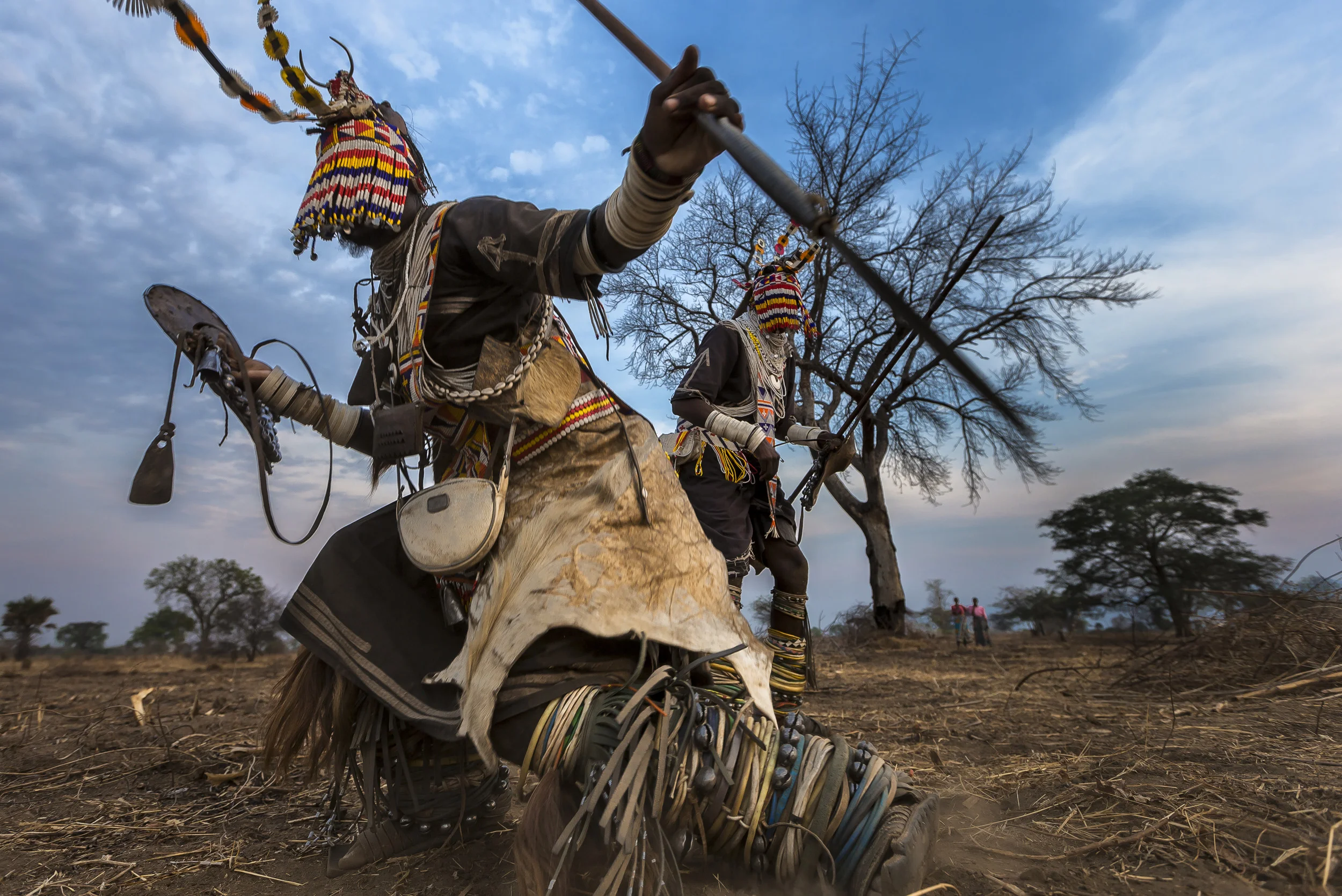
MPIMBWE, WESTERN TANZANIA, OCTOBER 2012: Lion Dancers from the Sakuma tribe perform the story of their lion killing outside a village in rural Mpimbwe, Western Tanzania, October 27, 2012. Lion dancers are men who have killed a lion in defense of their cattle or their village. They are a deeply superstitious people who believe that once they have killed a lion they have to become a lion dancer for 3 to 5 years to avoid going mad. They spend a year or longer preparing with the local witchdoctor and then go from village to village seeing their relatives and dancing while collecting tribute for their bravery. In a time when lion are very scarce in the region, this practice is actively discouraged by conservation organizations and it is slowly dying out. It is illegal in Tanzania. When the dancers appear in the villages, they are often praised and given money, goats and even sometimes a small cow. It is therefore something that some young men aspire to, even going as far as to venture into the local Katavi National Park in pursuit of a lion.
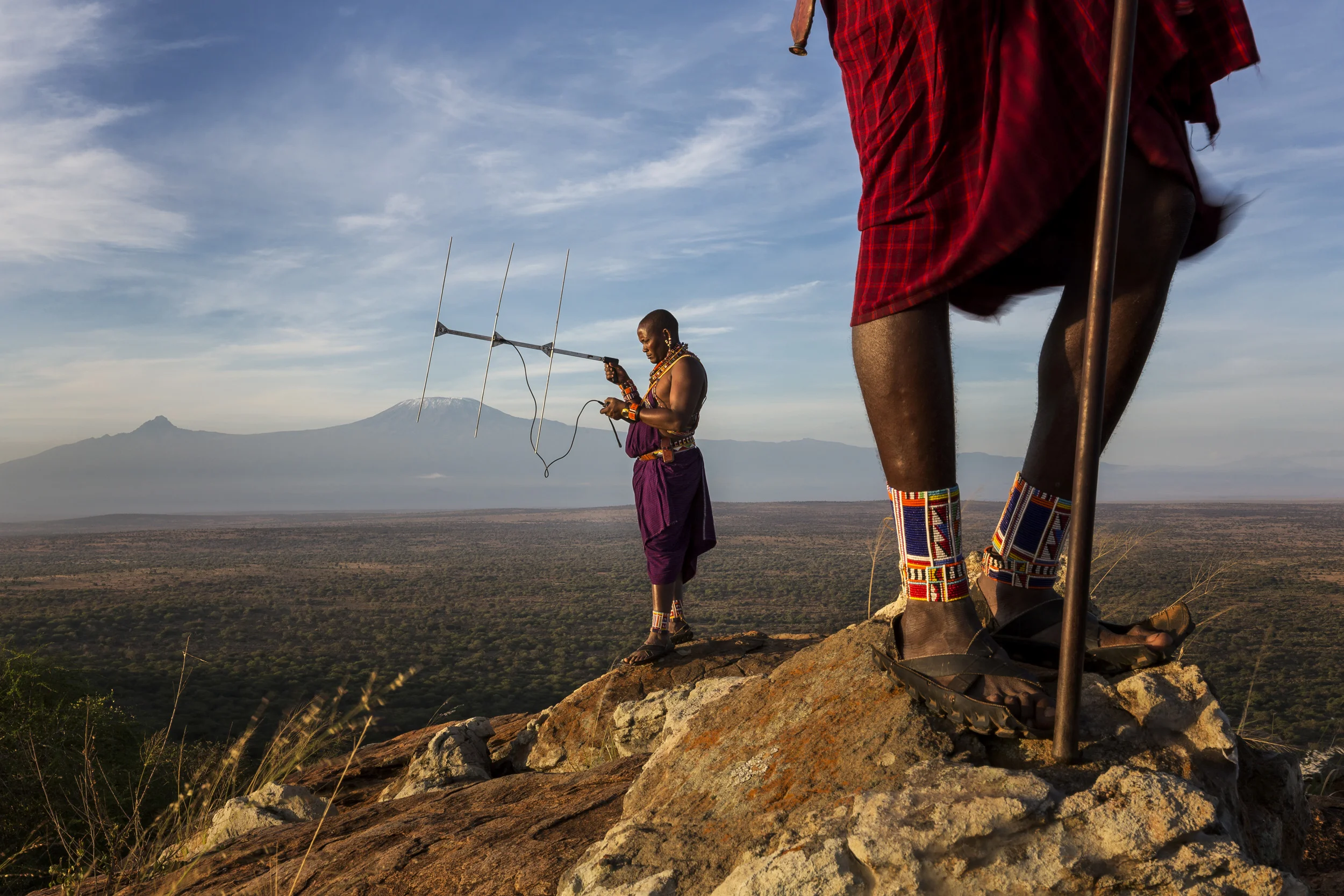
AMBOSELLI ECOSYSTEM, KENYA, 25 FEBRUARY 2013: Images of "Lion Guardians" using telemetry to locate lions in the ecosystem outside of Amboselli National Park, Kenya, 25 February 2013. Lion guardians is a conservation program which recruits leading Maasai men, many of whom are former lion killers, into a system which monitors lions, confers a sense of ownership and pride in them and forms a Maasai vanguard which seeks to prevent other Maasai from hunting lions in retribution for cattle killing. Retaliatory and traditional spearing by Maasai warriors is the greatest threat to the survival of lions in Maasailand. the Lion Guardians program is unique in employing the traditional enemy of lions to conserve rather than kill them. The Guardians monitor spoor, use telemetry devices to track collared lions, and collect dna samples for analysis. They have also named all the lions in their area and recently produced identity cards which further reinforce notions of lion identity within Maasai communities.

PHUNDUNDU WILDLIFE AREA, ZIMBABWE, JUNE 2018: Specially selected women from an all female. conservation ranger force undergo concealment and fire and movement training in the bush to curb poaching. Akashinga (meaning the ‘Brave Ones’ in local dialect) is a community-driven conservation model, empowering disadvantaged women to restore and manage a network of wilderness areas as an alternative to trophy hunting. Many current western-conceived solutions to conserve wilderness areas struggle to gain traction across the African continent. Predominately male forces are hampered by ongoing corruption, nepotism, drunkenness, aggressiveness towards local communities and a sense of entitlement. The I.A.P.F, the International Anti-Poaching Foundation led by former Australian Special Forces soldier Damien Mander, was created as a direct action conservation organisation to be used as a surgical instrument in targeting wildlife crime. In 2017 they decided to innovate, using an all- female team to manage an entire nature reserve in Zimbabwe. The program builds an alternative approach to the militarized paradigm of ‘fortress conservation’ which defends colonial boundaries between nature and humans. While still trained to deal with any situation they may face, the team has a community-driven interpersonal focus, working with rather than against the local population for the long-term benefits of their own communities and nature. Cut off from places of worship and burial, grazing areas, access to water, food, traditional medicine and given limited opportunity for employment or tourism benefits, it’s little wonder many of these communities struggle to see any value in conservation efforts. Women have traditionally played major roles in battle and are now re-emerging as key solutions in law enforcement and conflict resolution. In the Middle-East, counterinsurgency operations that involve penetrating and working with the local population to try and win the hearts and minds ha

PHUNDUNDU WILDLIFE AREA, ZIMBABWE, JUNE 2018: Members of the all female conservation ranger force known as Akashinga undergo tough training in the bush near their base. Akashinga (meaning the ‘Brave Ones’ in local dialect) is a community-driven conservation model, empowering disadvantaged women to restore and manage a network of wilderness areas as an alternative to trophy hunting. Many current western-conceived solutions to conserve wilderness areas struggle to gain traction across the African continent. Predominately male forces are hampered by ongoing corruption, nepotism, drunkenness, aggressiveness towards local communities and a sense of entitlement. The I.A.P.F, the International Anti-Poaching Foundation led by former Australian Special Forces soldier Damien Mander, was created as a direct action conservation organisation to be used as a surgical instrument in targeting wildlife crime. In 2017 they decided to innovate, using an all- female team to manage an entire nature reserve in Zimbabwe. The program builds an alternative approach to the militarized paradigm of ‘fortress conservation’ which defends colonial boundaries between nature and humans. While still trained to deal with any situation they may face, the team has a community-driven interpersonal focus, working with rather than against the local population for the long-term benefits of their own communities and nature. Cut off from places of worship and burial, grazing areas, access to water, food, traditional medicine and given limited opportunity for employment or tourism benefits, it’s little wonder many of these communities struggle to see any value in conservation efforts. Women have traditionally played major roles in battle and are now re-emerging as key solutions in law enforcement and conflict resolution. In the Middle-East, counterinsurgency operations that involve penetrating and working with the local population to try and win the hearts and minds have become fundamentally relian

PHUNDUNDU WILDLIFE AREA, ZIMBABWE, JUNE 2018: Members of the all female conservation ranger force known as Akashinga undergo tough training in the bush near their base. Akashinga (meaning the ‘Brave Ones’ in local dialect) is a community-driven conservation model, empowering disadvantaged women to restore and manage a network of wilderness areas as an alternative to trophy hunting. Many current western-conceived solutions to conserve wilderness areas struggle to gain traction across the African continent. Predominately male forces are hampered by ongoing corruption, nepotism, drunkenness, aggressiveness towards local communities and a sense of entitlement. The I.A.P.F, the International Anti-Poaching Foundation led by former Australian Special Forces soldier Damien Mander, was created as a direct action conservation organisation to be used as a surgical instrument in targeting wildlife crime. In 2017 they decided to innovate, using an all- female team to manage an entire nature reserve in Zimbabwe. The program builds an alternative approach to the militarized paradigm of ‘fortress conservation’ which defends colonial boundaries between nature and humans. While still trained to deal with any situation they may face, the team has a community-driven interpersonal focus, working with rather than against the local population for the long-term benefits of their own communities and nature. Cut off from places of worship and burial, grazing areas, access to water, food, traditional medicine and given limited opportunity for employment or tourism benefits, it’s little wonder many of these communities struggle to see any value in conservation efforts. Women have traditionally played major roles in battle and are now re-emerging as key solutions in law enforcement and conflict resolution. In the Middle-East, counterinsurgency operations that involve penetrating and working with the local population to try and win the hearts and minds have become fundamentally relian

MAKUTI, ZIMBABWE, DECEMBER 2018: Members of the all- female conservation ranger force known as “Akashinga” arrest a notorious wildlife poacher after discovering leopard skins and other animals parts in his home. They are seen taking video testimony for court proceedings, it is likely this man will receive a minimum five years in prison. Intelligence for the operation was gathered through the Akashinga community intelligence networks and M.A.P.P, an anti-poaching group that works hand in hand with these female rangers. Akashinga (meaning the ‘Brave Ones’ in local dialect) is a community-driven conservation model, empowering disadvantaged women to restore and manage a network of wilderness areas as an alternative to trophy hunting in Zimbabwe. Predominately male forces are hampered by ongoing corruption, nepotism, drunkenness, aggressiveness towards local communities and a sense of entitlement. The I.A.P.F, the International Anti-Poaching Foundation led by former Australian Special Forces soldier Damien Mander, was created as a direct action conservation organisation to be used as a surgical instrument in targeting wildlife crime. In 2017 they decided to innovate, using an all- female team to manage an entire nature reserve in Zimbabwe. The program builds an alternative approach to the militarized paradigm of ‘fortress conservation’ which defends colonial boundaries between nature and humans. While still trained to deal with any situation they may face, the team has a community-driven interpersonal focus, working with rather than against the local population for the long-term benefits of their own communities and nature.



TIMBUKTU REGION, MALI, 21 SEPTEMBER 2009: Tuareg Nomads end the Ramadan fast in the desert about 50 kilometers outside of Timbuktu with prayer and dancing, Timbuktu Region, Mali, September 21 2009. (Photo by Brent Stirton/National Geographic.)
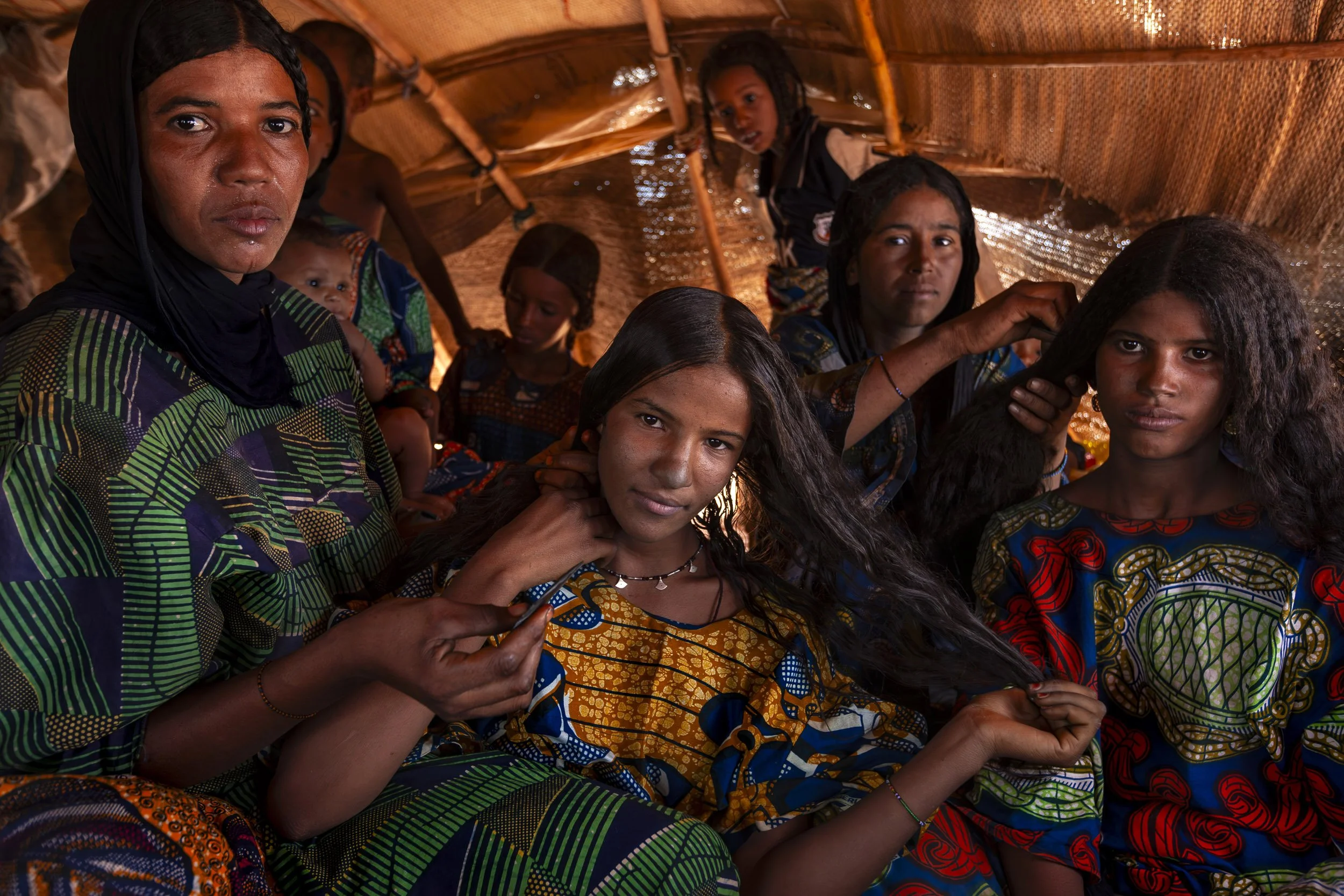
INGAL, NIGER, OCTOBER 2009: Two young Tuareg women have their hair dressed by other Tuareg women inside a traditional nomad tent at a Tuareg Nomad camp, Ingal Region, Niger, 11 October 2009. Tuareg Nomads have two traditional priorities, their animals and access to water. This group has moved to this region at this time to enjoy the remaining good grassland of the rainy season and will soon move again to be close to a good water source. The nomads survive on a diet of millet and camel milk which is occasionally supplemented by goat meat. (Photo by Brent Stirton/National Geographic.)
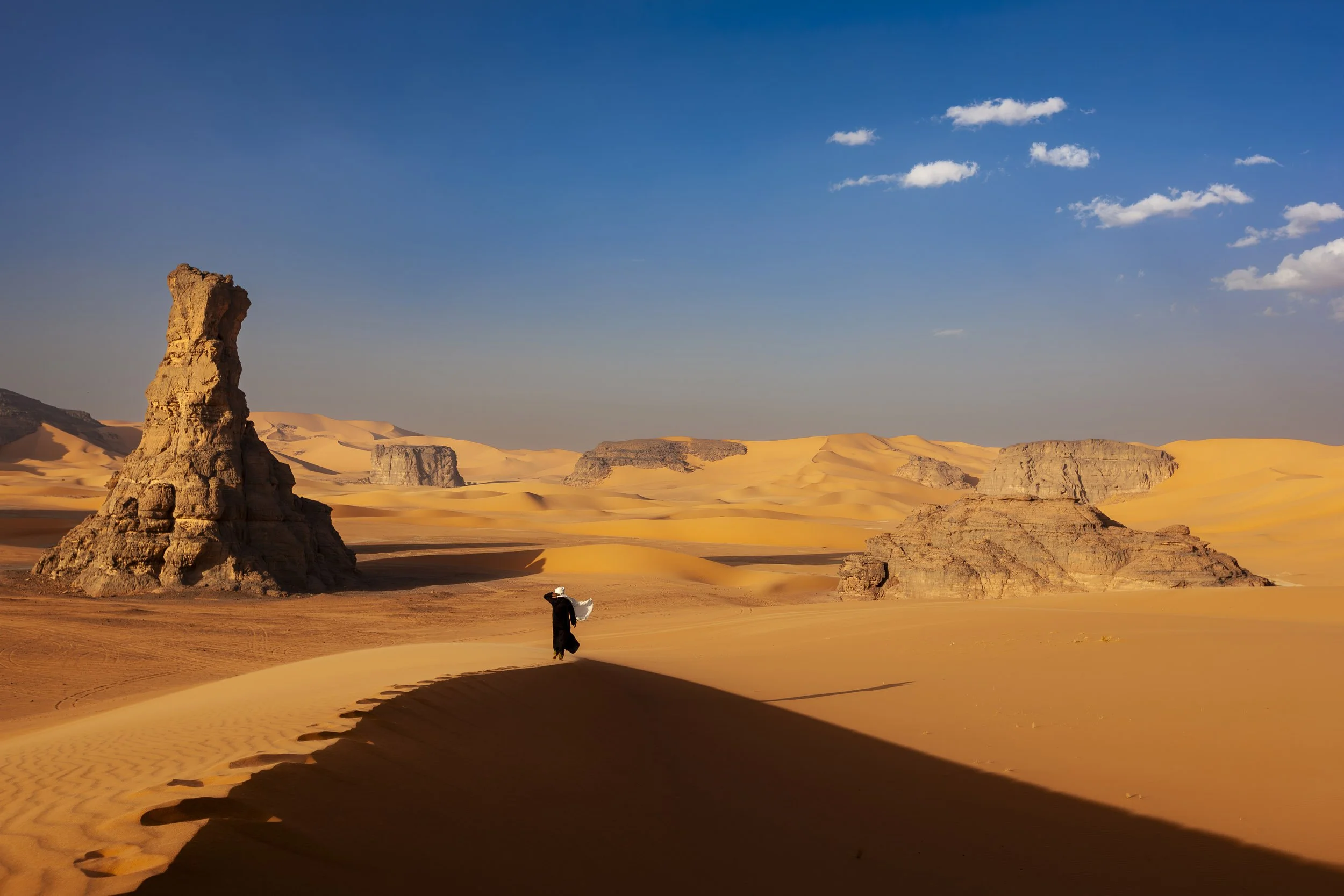
TASSILI 'N AJJER, SOUTHERN ALGERIA, APRIL 2009: Images of famed tourist site and traditional Tuareg land, Tassili 'n Ajjer, in the south of Algeria, 02 May 2009. (photo by Brent Stirton/National Geographic Magazine.)
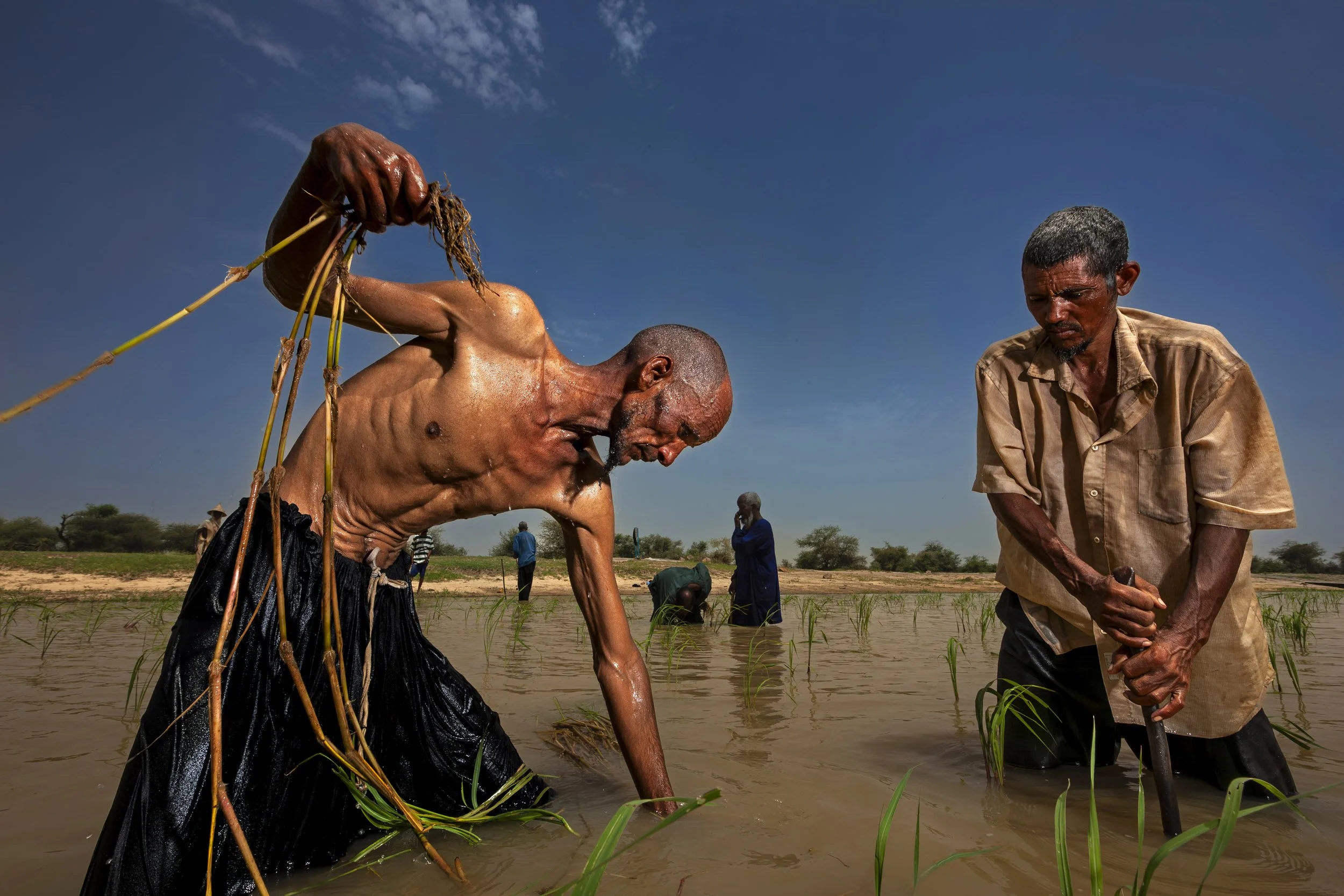
DAG ALLAL, TIMBUKTU, MALI, SEPTEMBER 2009: Tuareg men plant grass in the banks of the Niger River to grow a forage crop for their animals and for sale in the markets in the sedentary Tuareg village of Dag Allal in Mali on 11 September 2009. Unusual amongst Tuareg for their sedentary, non-nomadic existence, these Tuaregs remain in place all year and care for their animals by utilising agricultural techniques. They have received help from the Millenium Village Project which aims to empower local communities through education. They grow rice and forage grass in the nearby Niger river, using a canal and small pump to divert water into ricepaddies. Their leader, El Hadg Agali Ag Mohammoud, 70, explains that reasons of drought, rebellion, identity issues and a lack of union amongst the Tuareg caused this group to choose to remain in one place, "We live here all year, we take care of our animals by growing the grass that they wouldn't normally have in the hot summer months, other Tuareg don't always understand this, they think that this grass grows naturally. We sometimes have to prevent them taking it, we have to explain that we grow it for our animals and it is not free. Sometimes there is a confrontation as a result, this is not the traditional Tuareg way so we have to explain it to them. I think in the future there will be more Tuareg living this way. "(Photo by Brent Stirton/National Geographic.)

NZARA, SOUTH SUDAN, 17 NOVEMBER 2014: Michael Oryem, 29, is a former Lord's Resistance Army fighter who was involved in the poaching of Ivory in Garamba National Park in the Democratic Republic of Congo, a former base of operations for the LRA and a major source of financing for the notorious group. Oryem was abducted by the group when he was 9 and lived with them for over 17 years in the wild. He was made a commander in the group at the age of 12. The LRA is infamous for the killing and abduction of thousands of civilians across multiple countries. He defected and is now a member of the Ugandan Army, UPDF, African Union force hunting the LRA. he is seen with 2 of six pieces of ivory which he hid and then led the Ugandan forces to inside the border region of the Central African Republic. He claims that the LRA killed many elephants in Garamba and he was ordered by Joseph Kony, the groups notorious leader, to bring the ivory to him in Darfur, South Sudan. Ivory is now a real means of financing for the LRA, it is used for both food and weapons supplies and is traded to the Sudanese Army who transports it north to Khartoum. (Photo by Brent Stirton/Reportage by Getty Images for National Geographic Magazine.)
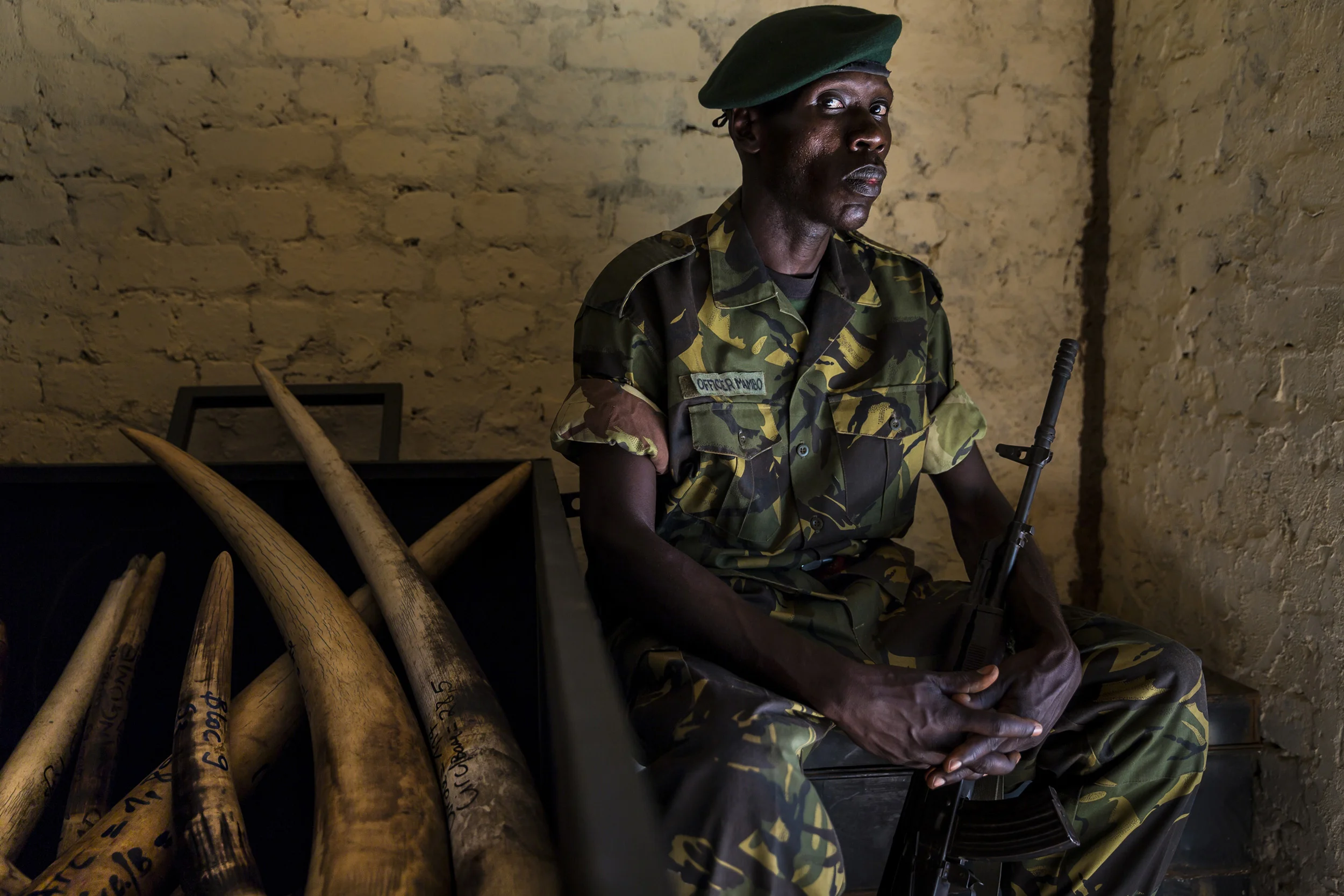
GARAMBA NATIONAL PARK, DEMOCRACTIC REPUBLIC OF CONGO, 12 NOVEMBER 2014: ICCN Ranger officer Mambo inside the ivory storage locker at Garamba National Park in the DR Congo. This ivory is the prize that notorious rebel group the Lord's Resistance Army, LRA, comes looking for in Garamba. Killing elephants for their ivory is an order direct from the LRA's sociopathic leader Joseph Kony, a man wanted by the International Criminal Court for crimes against Humanity. Rangers in Garamba find themselves up against a heavily armed LRA in their battle to save Garamba's elephant. As pressure has increased on Kony, the LRA has turned to Ivory as one means of sustaining themselves in their decades long bush war against the civilians of Uganda, Congo and the South Sudan/CAR region. (Photo by Brent Stirton/Reportage by Getty Images for National Geographic magazine.)

AMBOSELI, KENYA, MAY 2011: Undercover Kenya Wildlife Services Ranger detusk a bull elephant killed by a spear in the Amboseli ecosystem in the shadow of Amboseli, Kenya, May 29, 2011. The elephant was killed by a single spear stroke close to the spine which penetrated deeply enough to cause massive internal bleeding. It is not known whether this was a poaching attempt or whether this was a case of human elephant conflict with the animal in the crops of local Masaai. The animal was detusked and the ivory sent to the KWS HQ in Amboseli National Park. KWS has the mandate to protect wildlife in Kenya but lack the manpower and resources. Organisations like Big Life are the private sector arm of KWS in the 2 million acre Amboseli ecosystem, working alongside them to supply manpower, vehicles, funding, information networks and aircraft to practise effective conservation in the region. (Photo by Brent Stirton/Reportage for National Geographic Magazine.)

BOUBA NDJIDA NATIONAL PARK, NORTH CAMEROON, APRIL 2012: The largest mass killing of elephants in recent history took place at Bouba Ndjida National Park in North Cameroon close to the Chad and Central African Republic Borders from January through March 2012. Eye witnesses have so far located 340 carcasses, the ivory poachers themselves told local villagers they have killed over 650 elephants in their hunt for Ivory over the 500 000 hectare region. There has yet to be a proper aerial and ground survey of the dead elephants and the rainy season will make that difficult. The Poachers, numbering over 100 men, were mounted on horseback, led by 6 light skinned North Sudanese men and armed with RPG's, grenades, Light Machine Guns and AK47's. They were in two main groups, with a number of reconnaisance units of 4 men locating the elephants then bringing in a larger force to kill big groups. Intelligence indicates that many of the hunters came from Chad and were led by these Sudanese men. These facts have emerged from a number of eye witness acccounts, mainly by French professional hunters who saw the horsman in the Park and local hunting concessions. They had the appearence and attitude of Janjaweed fighters from the South Sudan Darfur and Chadian conflicts and were disciplined, unafraid, arrogant and extremely efficient hunters. The elephants were herded together by teams of 4 to 8 riders who then decimated them with AK47 fire, killing all the elephants they could find, including babies with no ivory. Groups as large as 53 have been gunned down together, with sections as large as 14 elephants lying within touching distance of each other. These horseman came into the area over the Chadian border, evidence of early carcasses suggests that they may have been in the park as early as October 2011. The main force began their hunt in earnest from January through to approximately 8 March 2012. It is believed there was collaboration with local poachers in this hunt as well as an as
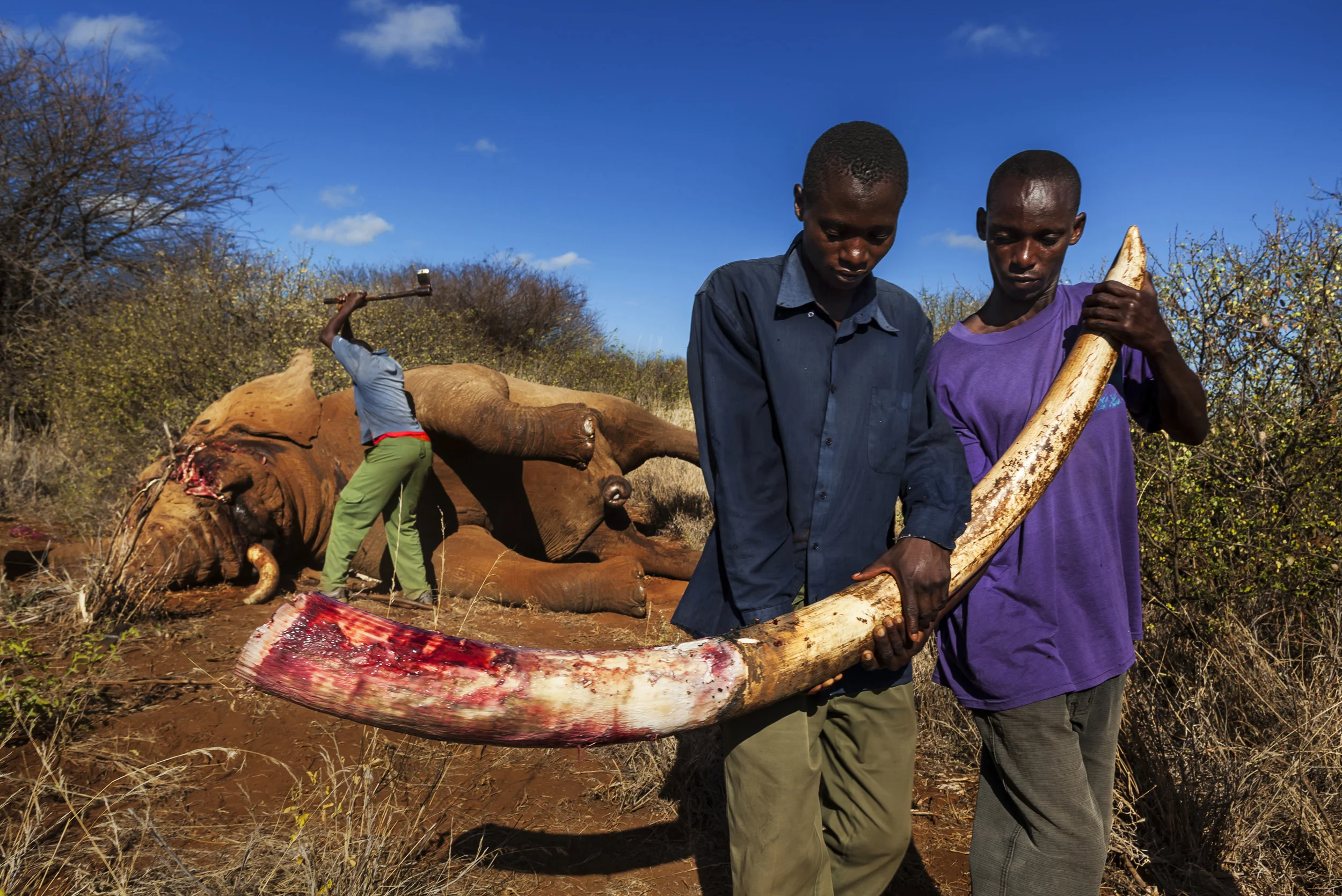
AMBOSELI, KENYA, MAY 2011: Undercover Kenya Wildlife Services Ranger detusk a bull elephant killed by a spear in the Amboseli ecosystem in the shadow of Amboseli, Kenya, May 29, 2011. The elephant was killed by a single spear stroke close to the spine which penetrated deeply enough to cause massive internal bleeding. It is not known whether this was a poaching attempt or whether this was a case of human elephant conflict with the animal in the crops of local Masaai. The animal was detusked and the ivory sent to the KWS HQ in Amboseli National Park. KWS has the mandate to protect wildlife in Kenya but lack the manpower and resources. Organisations like Big Life are the private sector arm of KWS in the 2 million acre Amboseli ecosystem, working alongside them to supply manpower, vehicles, funding, information networks and aircraft to practise effective conservation in the region. (Photo by Brent Stirton/Reportage for National Geographic Magazine.)

AMBOSELI, KENYA, MAY 2011: Undercover Kenya Wildlife Services Ranger detusk a bull elephant killed by a spear in the Amboseli ecosystem in the shadow of Amboseli, Kenya, May 29, 2011. The elephant was killed by a single spear stroke close to the spine which penetrated deeply enough to cause massive internal bleeding. It is not known whether this was a poaching attempt or whether this was a case of human elephant conflict with the animal in the crops of local Masaai. The animal was detusked and the ivory sent to the KWS HQ in Amboseli National Park. KWS has the mandate to protect wildlife in Kenya but lack the manpower and resources. Organisations like Big Life are the private sector arm of KWS in the 2 million acre Amboseli ecosystem, working alongside them to supply manpower, vehicles, funding, information networks and aircraft to practise effective conservation in the region. (Photo by Brent Stirton/Reportage for National Geographic Magazine.)

BRAZZAVILLE, REPUBLIC OF CONGO: Bat hunters return from collecting bats from an island a couple hours away from the capital Brazzaville. The hunters have nets strung high all over the island and harvest the bats every day of a four-month season. In peak season this can be between 100 to 150 bats per day. This is a popular bushmeat and suppliers deliver the bats twice a week to sellers. They are sold for between 500 and 1500 CFDA each, about $2 to $4 USD. They are traditionally made into a thick soup but this is a relatively new delicacy that only evolved in the nineteen seventies. The people who market these bats say that white people lie about Ebola and other diseases and their connection to bats. They say it is a way to force local people to buy western foods from white countries. Accepting the fact that bats are the primary vector animal for zoonotic disease is bad for business. This is despite that fact that a live Ebola virus has been isolated inside fruit bats in Guinea, proving their carrier status. Epidemiologists has examined groups of bats from this same area who test 33% positive for Ebola antibodies. It is also believed that bats play a significant role in the current Covid 19 crisis. When the bat sellers prepare the bats for clients, they are often asked to remove the wing bones and wrap the bats in their own wings. This practice is often done with the seller pulling out the bones with their teeth. This is an instant transmission issue but goes unacknowledged by the men involved in this aspect of the wildmeat trade.
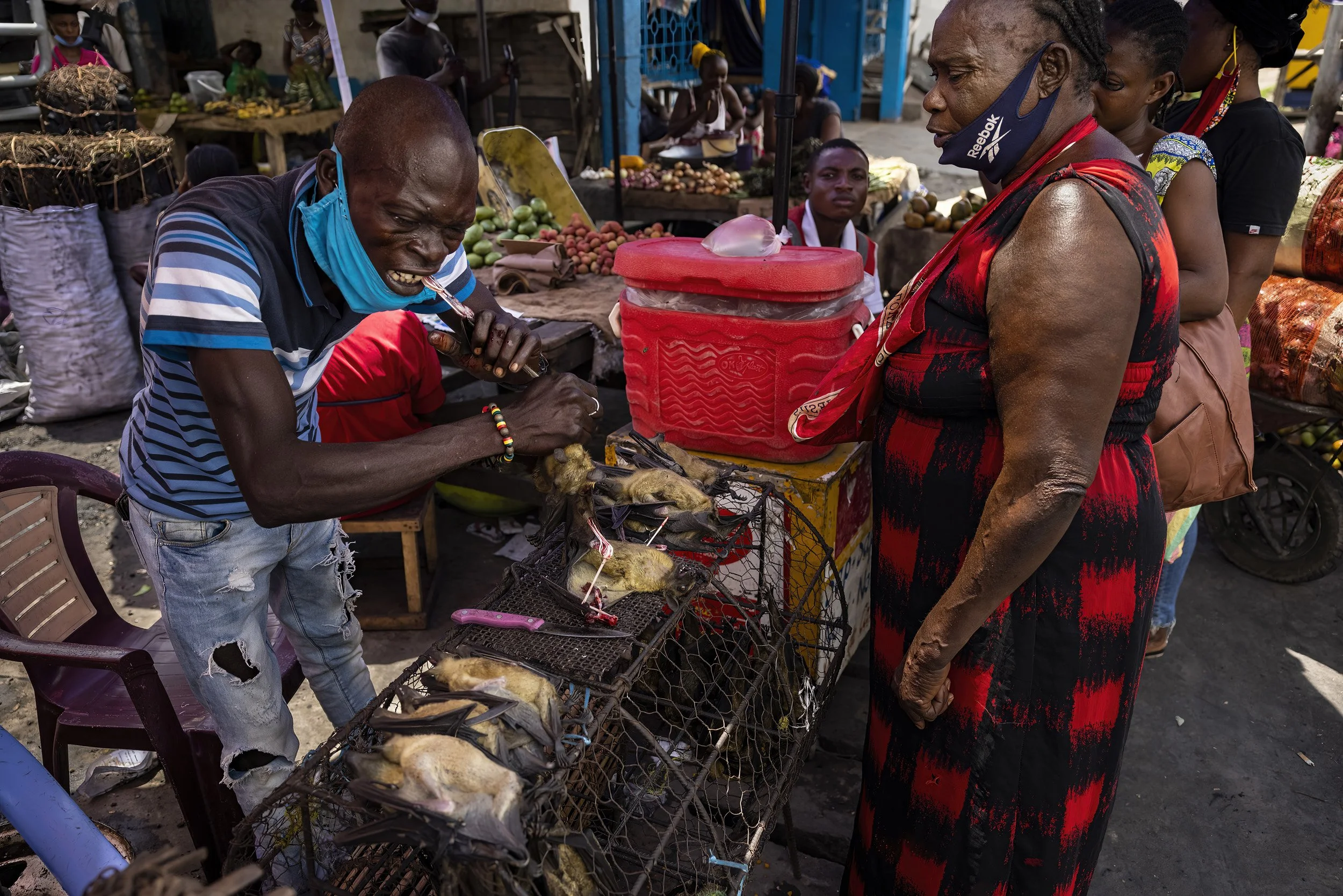
3. BRAZZAVILLE, REPUBLIC OF CONGO: A bat seller at the Total market in Brazzaville uses his teeth to remove the wing bones from a bat he has just killed. The bats are sold live and when the bat sellers prepare the bats for clients, they are often asked to remove the wing bones and wrap the bats in their own wings. This practice is often done with the seller pulling out the wing bones with their teeth. This is an instant transmission risk but that goes unacknowledged by these men. The people who market these bats say that Western people lie about Ebola and other diseases and their connection to Bats. They say it is a way to force local people to buy western foods from white countries. Accepting the fact that bats are the primary vector animal for zoonotic disease is bad for business. This is despite that fact that a live Ebola virus has been isolated inside fruit bats in Guinea, proving their carrier status. Epidemiologists has examined groups of bats from this same capture area who test 33% positive for Ebola antibodies.

KINSHASA, DEMOCRATIC REPUBLIC OF CONGO: A man coming off a recently arrived boat carries an African dwarf crocodile through Maluku port. The overall population of this species in the wild varies from estimates of 25,000 to 100,000 individuals. On the IUCN Red List, the Dwarf crocodile is classified as a Vulnerable species within its habitat. Hundreds of these crocodiles are sold in Kinshasa most days of the week. Boats which have travelled from Equateur and other regions deliver bushmeat and other goods into the busy Maluku port outside of Kinshasa. All kinds of bushmeat is available, including endangered species. Kinshasa’s ports are the first stop for suppliers to restaurants all over Kinshasa and abroad.
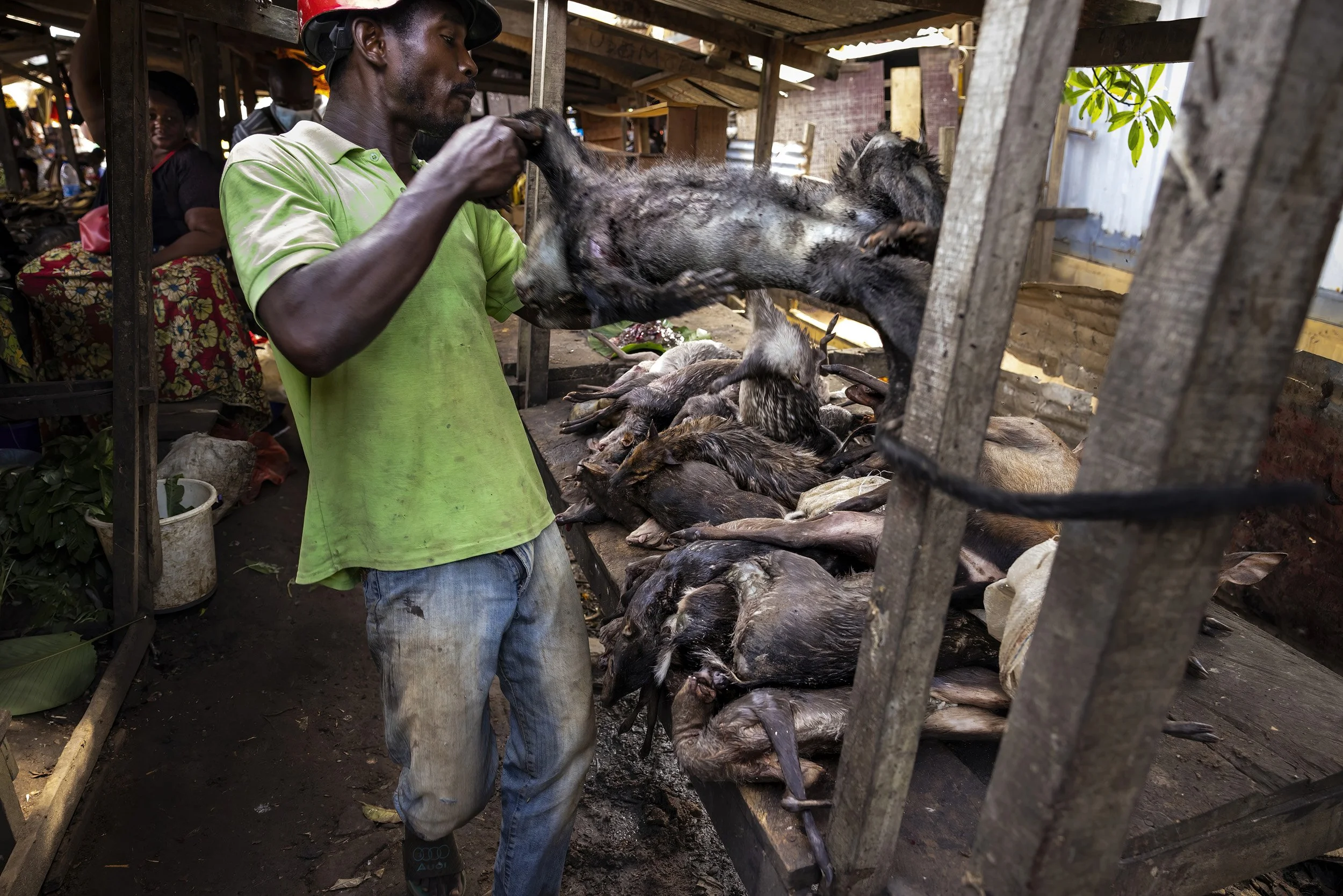
OUESSO, REPUBLIC OF CONGO, 20TH MAY 2021: A driver of a small truck delivers a variety of wildmeat to individual women traders who sell it in one of Ouesso’s markets. This is a daily delivery to just one female trader. The bushmeat usually is all grouped together, so if one animal is carrying a disease, it can easily be passed to the other animals in the pile. The animals travel via car, motorbike and boat to Ouesso, a town notorious for its bushmeat market. The vast majority of the selling is done by women. Men do the hunting and transporting.

KINSHASA, DEMOCRATIC REPUBLIC OF CONGO: A man and his wife unpack sacks containing 84 monkeys that they have just unloaded from a boat in Maluku port. There are two different species in the bag. The couple say they have a shotgun with relatives in the Equateur region and hunt with that. They make the trip every two weeks and say there are literally thousands of hunters all doing the same thing. They pay taxes on arrival but if they do that there is no problem with the authorities. They say they will sell the monkeys within one day in Kinshasa, they are a popular form of bushmeat with consumers. One monkey sells for around $15 in the port, up to $25 in the city. Boats which have travelled from Equateur and other regions deliver bushmeat and other goods into the busy Maluku port outside of Kinshasa. All kinds of bushmeat is available, including endangered species. Kinshasa’s ports are the first stop for suppliers to restaurants all over Kinshasa. The trafficking of wildlife to cities to meet non-essential demand for bushmeat poses a major threat to many Central African species.
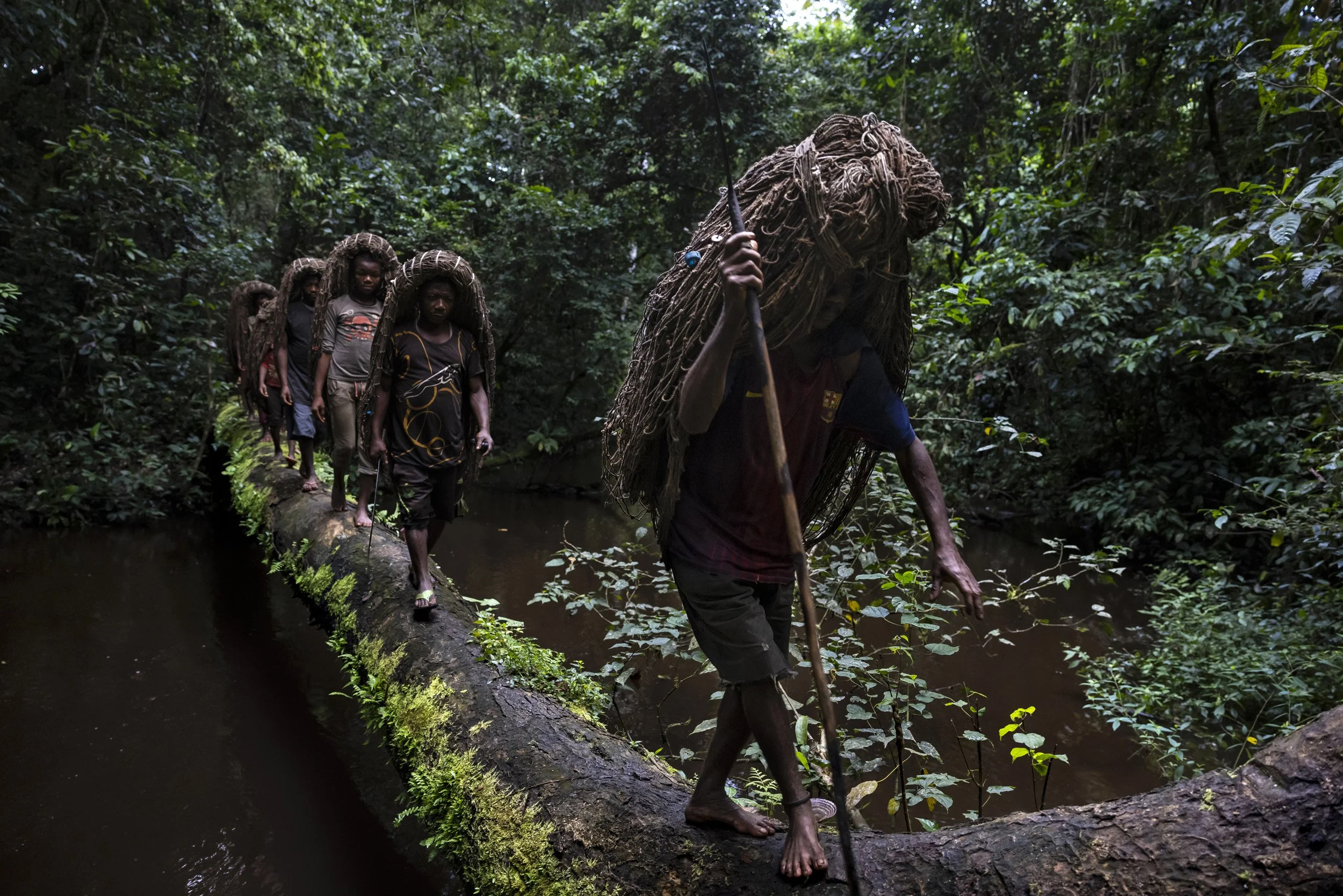
18. EPULU, ITURI, DEMOCRATIC REPUBLIC OF CONGO: An Mbuti Pygmy hunting group is seen on their way to hunt inside the forest in Okapi National Reserve. The Mbuti hunt wild meat in a sustainable manner, using nets they have created from forest vines. The men lay out the nets in a long line through the forest while the women move through shouting and making a noise, driving any animals towards the nets. The Mbuti have a 15 to 20% success rate, similar to a lion. This is what makes this hunting practice sustainable. Larger animals simply break through the net, meaning small duikers and other smaller animals make up most of the capture. There are around 2300 Mbuti in the reserve, mostly living in harmony with the forest. It is when pygmies are co-opted by other parties for their hunting skills that that harmony is broken. Centuries of ill-treatment have reduced pygmies in many areas to indentured servitude and a state of survival. Illegal mining camps in Epulu, some very large and politically connected, use pygmies to hunt bushmeat for the miners, supplying them with shotguns and shells and paying them with part of what they can shoot. The pygmies are also often forced to hunt by the Congolese Army who protect many of the illegal mining areas.
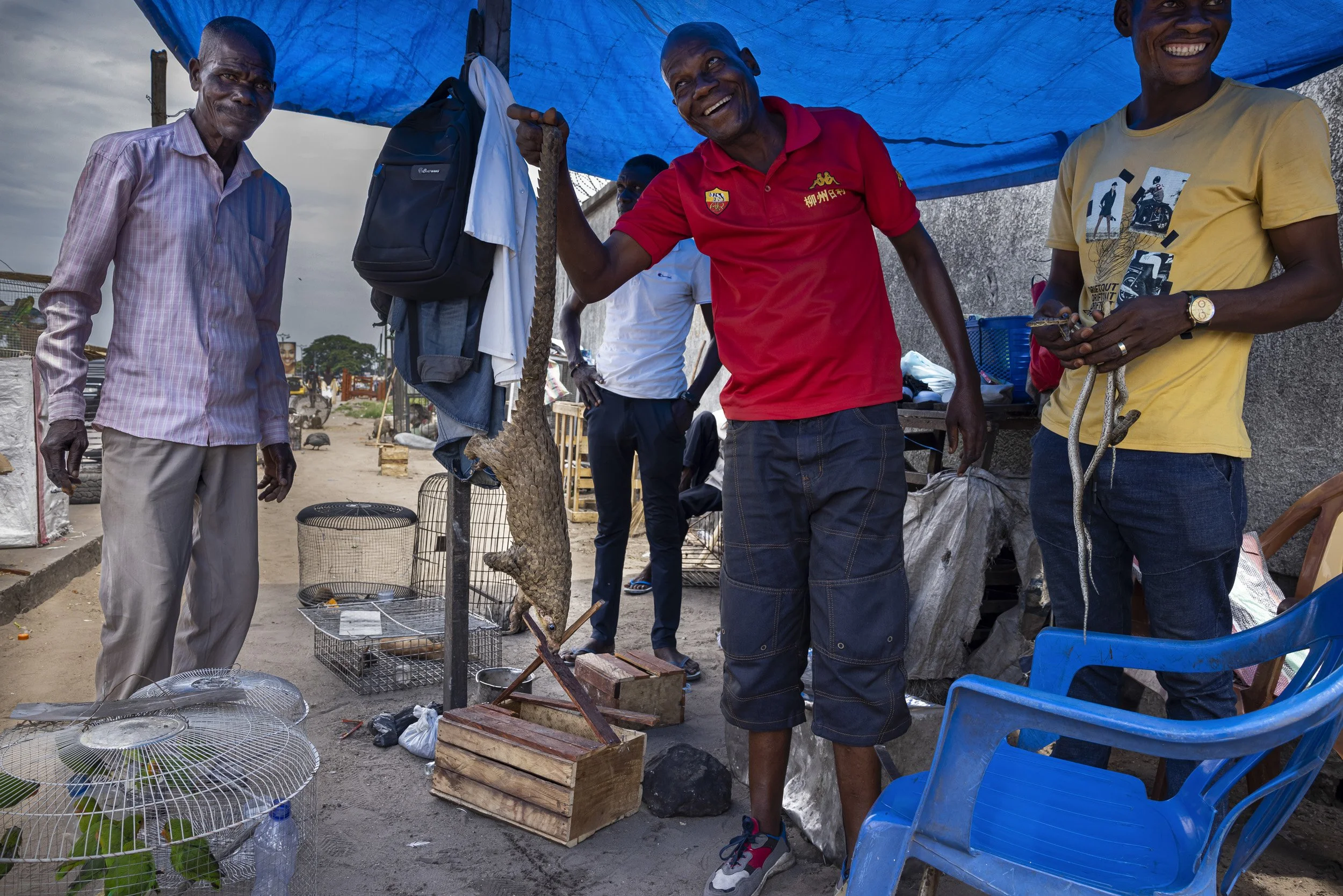
KINSHASA, DEMOCRATIC REPUBLIC OF CONGO: A group of men sell live bushmeat species by the side of the road in Kinshasa. Some of these species are illegal and highly endangered, such as the pangolin. A lack of law endforcement is a major part of the bushmeat crisis. These men say there is no issue with the authorities and state that the wildlife authorties often buy from them as they have the right connections to make a greater profit. They state that there are only restrictions in the areas where the animals are hunted but none in the cities they are trafficked to. These men were selling the pangolin for $60 and say they usually sell those to the Chinese. The trafficking of wildlife to cities to meet non-essential demand for bushmeat poses a major threat to many Central African species. As urban populations grow, the pressures posed on wild populations by consumer demand increase. Kinshasa, Democratic Republic of Congo (DRC), and Brazzaville, Republic of Congo (ROC), are two capital cities separated only by the Congo River. Combined, they form the third largest urban agglomeration in Africa with a total population of 15 million, with Kinshasa predicted to become the fourth largest city in the world by 2050. Alternative animal protein is widely available in these cities but eating bushmeat is of social and cultural significance, therefore it is consumed as a luxury good rather than to fulfil basic food security needs. Urban bushmeat markets pose a threat to wildlife, the food security of rural communities due to resulting defaunation, and a significant zoonotic disease risk if novel pathogens are imported into populous cities. The ngo Wildlife Conservation Society estimates that over 33 million kilograms of bushmeat are brought into Kinshasa every year, making this the epicenter of the world bushmeat trade. .

EQUATEUR PROVINCE, DEMOCRATIC REPUBLIC OF CONGO, 23 APRIL 2021: Blandine Bosaku, 18, is seen inside the isolation ward at Befale general clinic in remote Befale village with her daughter Anisha. Blandine is suffering from Monkeypox, a virus that is often fatal if not treated with antibiotics. Blandine had two children, the eldest recently died from Monkey-Pox. Her surviving daughter Anisha Yaiteni, 6, then became infected and passed the virus onto her. Blandine says her children caught monkeypox from a hunter neighbor who has since passed away. She says that in her village of Liyaela, there is a 70% infection. The lesions on Blandine are clear indicators of Monkeypox, she is pregnant and this can result in the virus being passed on to her baby, who will most likely die as a result. Monkeypox is first passed onto humans when an infected primate or rodent is eaten. Once that human is infected, they are highly contagious and multiple infections at a village level are common. In most cases, the remote rural poor cannot afford the medicine or the travel and expense of going to the nearest rural hospital. That hospital may also not have the necessary antibiotics. Superstition, traditional hunting of bushmeat as a protein source, traditional medicine practices and a failure to social distance all add to the infection rate once Monkeypox comes to a village.

Doctors at a Covid 19 ward in Kinshasa, DR Congo take a break after a morning of new patients flooding into the isolation section of the hospital.

KAUDULLA, SRI LANKA, 7TH JULY 2022: A wild elephant from Kaudulla National Park is seen sneaking through an electrified fence into croplands on the park boundary. Despite the pain for the electric shock, this is a regular occurence. There used to be an unsanctioned, informal garbage dump in this area and that is what initially drew the elephants to break the fence. Over 70% of Sri Lanaka's elephants live outside national parks, bringing elephants and humans into regular and sometimes dangerous contact.

DUBARE ELEPHANT CAMP, KARNATAKA, INDIA, 22ND OCTOBER 2022: A captured and chained elephant attempts to rest by leaning against the tree to which it is chained. Dubare is one of the larger elephant camps in India, a place where captured elephants are brought and kept. Elephant orphans from the wild are brought to these camps as well as elephants from Human/Elephant conflict incidents. Some of the elephants here are trained to be capture elephants, meaning they will deploy as a team to capture rogue elephants who are perceived to be dangerous to humans or destructive to property. These camps also play a lucrative role in tourism, with thousands of visitors streaming in to see the elephants. Dubare has seen 7 new elephant captures in the last 5 years, there are new camps in the area to accommodate the numbers and the rise in tourism. There is some worry amongst elephant activists that the decision to capture is gaining commercial impetus. These elephants are the property of the forest department of Karnataka but private ownership and domestic trade is now back on the table in India, with government support likely to make this legal again soon. Three more elephants were captured in December alone.

GALGAMUWA, SRI LANKA, 30 JUNE 2022: A juvenile elephant lies dead after eating a home-made grenade made from firecrackers combined with metal shrapnel hidden inside a pumpkin or watermelon. The explosion blew off most of this juvenile elephant’s lower jaw and decimated his tongue and teeth. Sri Lanka wildlife department officials estimate that this elephant most likely walked around for two weeks after the explosion in terrible pain, unable to eat or drink before succumbing on the morning of this photograph. There have been three such incidents in this area in the last year that have been recorded. It is a sign of growing village frustration with crop-raiding elephants that such techniques are being employed. Ironically, this area is forestry department land, the poor have been allowed to farm here by vote seeking politicans but not to put up permanent structures. The increasingly shrinking habitat available to Sri Lankan elephant means human elephant conflict is inevitable, especially as more and more crops are grown in what were formerly elephant areas. As a result, there is significant tension between local villagers and the elephants. The elephants exist in a serious of small remaining wild spaces and are often unwelcome visitors to areas where humans are living and cultivating crops.

MYSORE, INDIA, OCTOBER 4, 2022: Two palace elephants touch trunks to comfort and reassure each other during the Mysore Dasara, the only state festival in India where elephants are used. In the days leading up to the festival these elephants injured two people, they are nervous and traumatized by the huge crowds at the festival. Their weaving behaving, constant trunk touching and placing their trunks in each other mouths is soothing behavior to cope with being chained all day and a disturbing massive human presence.

KERALA, INDIA: A large male elephant walks past two nervous women on its way to attend a festival in Kerala, India. Elephants have become increasingly popular at religious festivals in Kerala, for centuries they have been used by the Hindu faithful because of their role in Hinduism and also as a symbol of power. In recent years both Christian and Islamic factions have introduced elephants into their festival. As a result these elephant have become heavily overused during the festival period. They have little rest, are surrounded by a roaring crowd, loud music and concussive fireworks. Elephants that are in mhust have also been used, despite their increased aggression in this period. Accidents and killings have been commonplace, panicked and aggressive elephants have killed a number of spectators. The elephant owners charge large fees for appearances and there are devout, fanatical followings for individual elephants. Despite the danger, people continue to flock to these events.
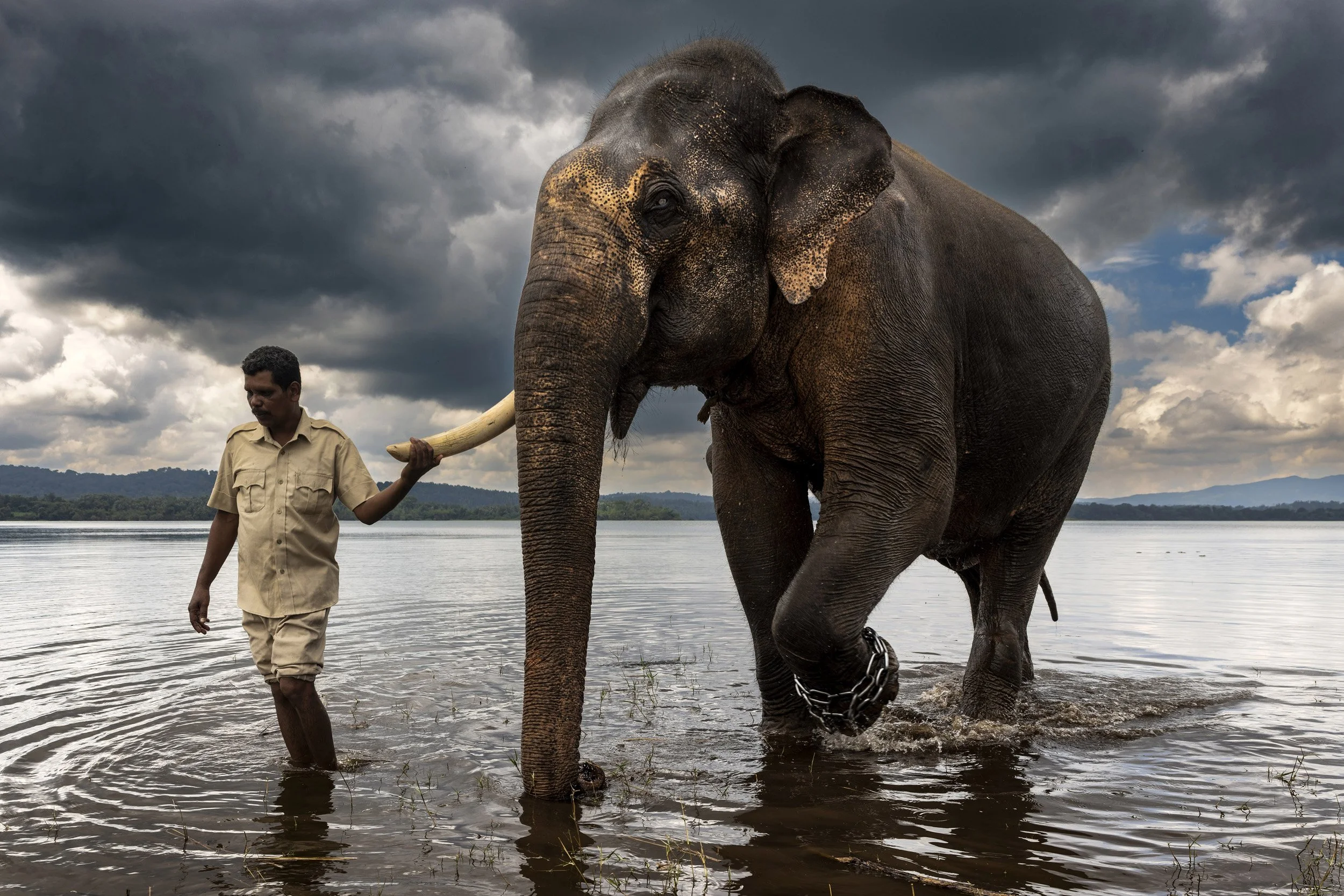
HARANGI ELEPHANT CAMP, KARNATAKA, INDIA, 21st October 2022: Experienced elephant mahout JS Raju guides blind elephant Ekadantha into the water to be bathed. This elephant will often hesitate, lifting his foot until he receives reassurance it is safe to go forward. Ekadantha is over 60 years old and is retired. He was with his previous mahout for over 40 years and locals say they knew each other so well that their relationship was almost unspoken. Good mahouts say that it is not necessary to beat the elephant or hurt it with a hooked stick in order to understand each other. Unfortunately Covid saw many of the older mahouts die and some of their wisdom died with them. Captured elephants in camps are big tourist business and that can mean impatience with the elephants and rough treatment. Elephant researchers are paying more attention to this ancident relationship now in order to glean a greater understanding from the mahouts of elephant behavior.
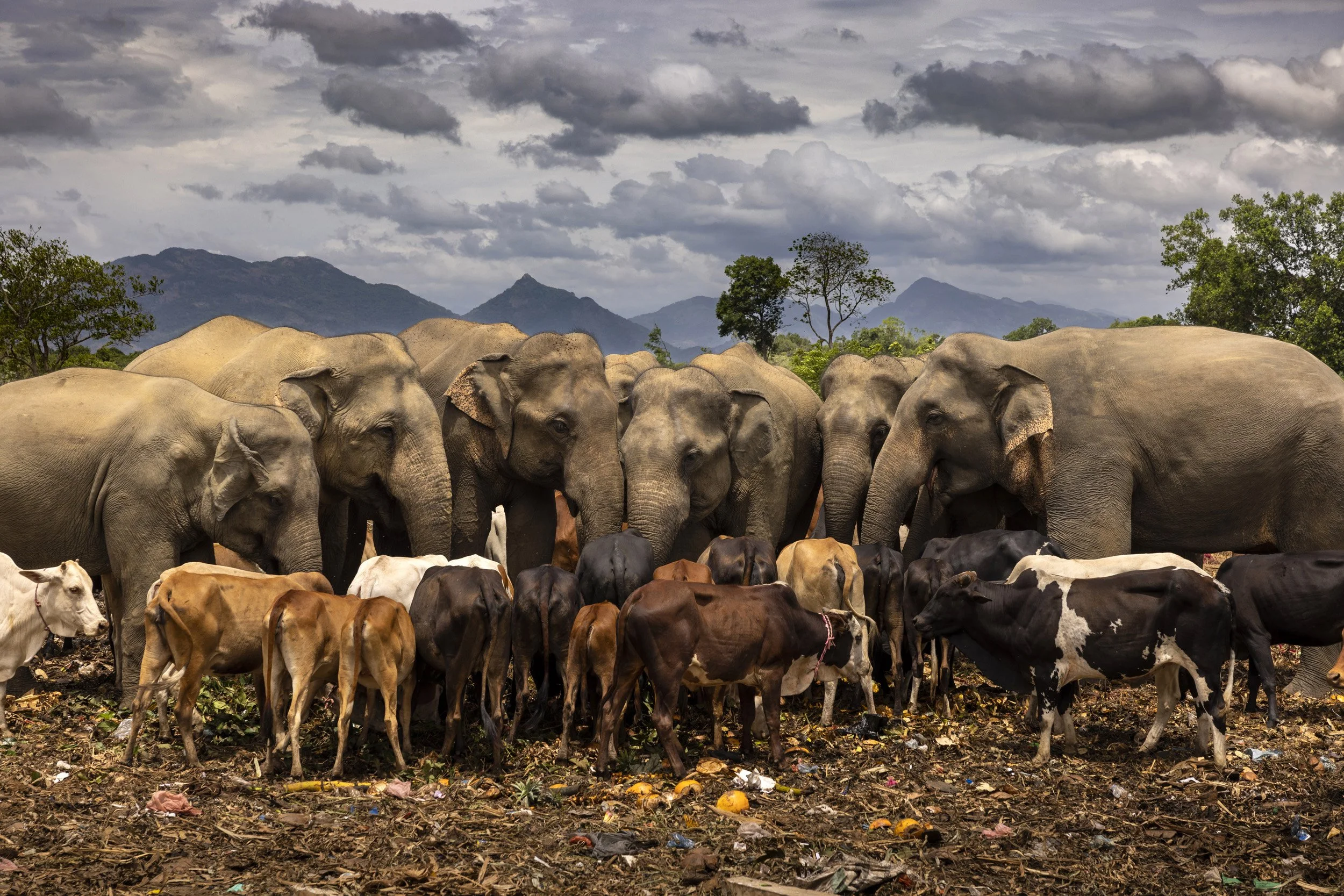
DAMBULLA DUMP SITE, HABARANA, SRI LANKA, 4TH JULY 2022: A bachelor herd of wild elelphants from nearby Minneriya and Kaudulla National Parks are seen in Dambulla dump scavenging for fruit and vegetables that have been thrown away. This dump has existed for over ten years and elephants have been regular visitors. A number of these elephants have become residents in the area, drawn to the sweet fruits they can't get elsewhere. Conservationists argue against this practise, saying that elephants then associate humans with food and that can be dangerous for both humans and elephants. There are also many plastics and other contaminants in this garbage and there are some fears that will bring health issues to these elephants. Ironically, there is a new hotel being built at this dump site as well a a golf buggy circuit for visitor to see the elephants. This is expected to open in 2023.

GALGAMUWA, SRI LANKA, 30 JUNE 2022: A juvenile elephant is seen being moved to burial by an earth mover after eating a home-made grenade made of firecrackers combined with metal ball bearings hidden inside a pumpkin or watermelon. The explosion blew off most of the elephant’s lower jaw and decimated his tongue and teeth. Sri Lanka wildlife department officials estimate that this elephant most likely walked around for two weeks after the explosion in terrible pain, unable to eat or drink before succumbing on the morning of this photograph. There have been three such incidents in this area in the last three years that have been recorded. It is a sign of growing village frustration that such techniques are being employed. Ironically, this area is forestry department land, the poor have been allowed to farm here but not to put up permanent structures. The increasingly smaller habitat available to Sri Lankan elephant means human elephant conflict is inevitable, especially as more and more crops are grown in what were formerly elephant areas. As a result, there is significant tension between local villagers and the elephants. The elephants exist in a serious of small remaining wild spaces and are often unwelcome visitors to areas where humans are living and cultivating crops. Sri Lanka has one of the highest incidents of human elephant conflict as a result.

VALPARAI, TAMIL NADU, INDIA, 15TH OCTOBER 2022: Wild elephants are seen high on the slopes of Valparai tea estate. Valparai is a huge tea-estate area that British colonialists transformed from native forest in 1890 as a response to the Chinese hike in tea prices. There was no concession given to the presence of thousands of elephants except to kill them. Today, wild elephants can sometimes be seen in the tea-estates, eating the grass between the bushes. This has always been an elephant area but they are forced to live in forest corridors between the tea estates and are often chased away to ensure tea worker safety. The human-elephant conflict here is a delicate issue. The tea plantations are a hindrance to the movement of wildlife, particularly elephants who walk large distances to reach water bodies and feeding areas.

TRANSKEI COAST, SOUTH AFRICA-NOVEMBER 2003: Xhosa boys undergoing the circumcision ceremony walk back to their huts at the end of the day. Every Xhosa male must undergo this ceremony which begins with a unanethatised circumcision and then explores a month long oral history of the Xhosa people. PHOTO BY BRENT STIRTON/GETTY IMAGES.



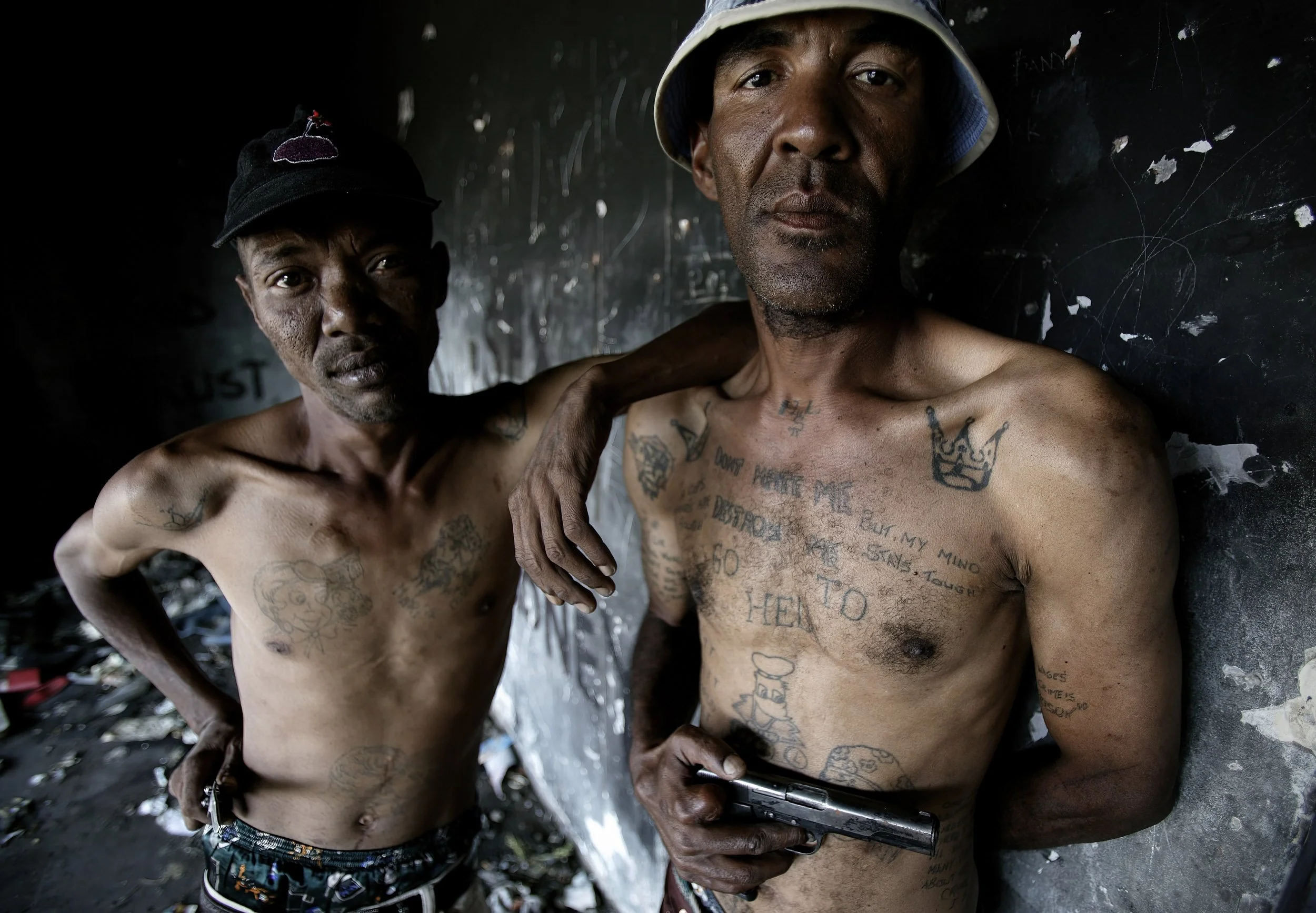
LAVENDER HILL, CAPE FLATS, SOUTH AFRICA: Two senior members of the Americans gang guard an area where there are frequent drug transactions. Both men show tattoos also connecting them to the 26’s, a numbers gang from South African prisons. These tattoos show their status as accomplished thieves. Gangs on the Cape Flats have long been a feature of the coloured community. They are a classic example of the consequences of drug use, the legacy of apartheid and the ongoing social crisis for many coloured people living on the Cape Flats. (Photo by Brent Stirton/Getty Images)

HANOVER PARK, CAPE TOWN, SOUTH AFRICA: Addicts use Meth, Heroin and a local opiod called Mandrax. They are doing this in a drug house run by the Mongrels, one of Cape Town’s oldest and most notorious gangs. Hanover Park is one of the most dangerous gang areas in South Africa and is a hotbed of drug use which has ravaged many parts of the Coloured community. Hanover Park has seen over 16,000 gunshots fired in the last 4 years, according to locals monitoring group Ceasefire. (Photo by Brent Stirton/Getty Images)

HANOVER PARK, CAPE TOWN, SOUTH AFRICA: Tasleem Johnson, 36, is a long-time member of the Mongrels Gang, one of the oldest and most notorious gangs on the Cape Flats. He has been with them since he was a young teenager, with family links to the Mongrels. He has tried to step back from active gang life but still lives in the same street as the HQ of the Mongrels, making it very difficult. He currently lives with his pregnant wife and 5 children in one bedroom in one of the most dangerous gang areas in South Africa. Hanover Park has seen over 16, 000 gunshots fired in the last 4 years. Tasleem works as a volunteer “interuptor” for “Ceasefire” an organization that seeks to reconcile gang conflict on the Cape Flats. Seen here with his twin daughters and his wife, Tasleem’s hand was cut last night when he tried to calm a gangster who was “freaking out.” Gang culture is a strong feature of life for many coloured people. In South Africa the term ‘coloured’ is used without offence and refers to people who have multiple heritages. Coloured was a legally defined racial classification during apartheid referring to anyone not white or not a member of one of the aboriginal groups of Africa on a cultural basis, which effectively largely meant those people of colour not speaking any indigenous languages. The Cape Coloured community is predominantly descended from numerous interracial sexual unions, primarily between Western European men and Khoisan or mixed-race women in the Cape Colony from the 17th century onwards and then from Malay workers who came to the Cape. There are close to 5 million coloured people in South Africa, with the majority language being Afrikaans. Most of these people are poud to call themselves coloured and do not see this as a derogatory term. (Photo by Brent Stirton/Getty Images)

MITCHELL'S PLAIN, CAPE TOWN, SOUTH AFRICA: Members of the Dirty Bastards gang sell drugs in a park in a part of Mitchell's Plain known for gang activity and drugs. Gangs on the Cape Flats have long been a feature of the coloured community. They are a classic example of the consequences of drug use, the legacy of apartheid and the ongoing social crisis for many coloured people living on the Cape Flats. (Photo by Brent Stirton/Getty Images)

CAPE TOWN, SOUTH AFRICA, MARCH 22, 2022: Chief Autshumao, a prominent leader of the Khoisan Legislative Council and on the Goringhaicona Khoi Khoi Indigenous Traditional Council, is against the building of a new Amazon headquarters in Cape Town as it is on land sacred to the Khoi people. He is seen arguing with another Khoi group that wants the Amazon building project and the jobs it may provide. The $300 million development had fueled a nasty feud within Indigenous, or First Nations, communities over whether building on what many consider sacred land would desecrate their history and culture, or uplift it, since the developer had promised to include an Indigenous heritage center. A judge temporarily halted construction of Amazon’s first Africa headquarters, in Cape Town, saying the developer didn’t properly consult Indigenous people about building on sacred ground. Judge Patricia Goliath of the Western Cape High Court said the consultation process for the project, a $300 million development on a former golf course, was biased because it omitted many Indigenous groups. She ordered work to be stopped and said its owner must talk again with Indigenous people. Work has since resumed on the Amazon campus and it is now near completion. Cape Town officials last year celebrated Amazon’s decision to choose Cape Town as “a base of operations on the African continent.” They said the development would create 19,000 jobs, almost 500,000 square feet of residential and commercial space, and bolster the region as a technology hub. According to the modern Khoi, most South Africans have been conditioned either by historic colonialist indoctrination or by contemporary Black African nationalist propaganda that this land either belongs exclusively to European imperialists or to the Bantu immigrants. Both claims are factually incorrect and are a gross historical travesty. In contrast to every black, white or brown South African, the Khoisan alone are indigenous to this land.

PLATFONTEIN, SOUTH AFRICA: Wentzel Katjarra is a former special forces soldier for 31 Battalion, the bushman battalion of the South African Defence Force during the Angolan war. He lives in poverty in Platfontein, the Khoi San Khwe settlement for former bushmen members of the elite bushman brigades of the South African Defence Force under Apartheid. He tries to keep alive his original bushman skills and teaches local boys some of these. The men from these units were recruited first by the Portugese and then joined to SADF because of their exceptional bush craft skills and served with distinction amongst the tip of the spear units of the South African Defence force during the Angolan wars. When democracy came to South Africa, they were seen as fighting for the wrong side and the ANC disbanded their battalions and placed them in very poor conditions in a settlement outside of Kimberley in the middle of South Africa. There are very few jobs and rampant alcoholism. They feel they are “pariahs in the land of their birth” and are calling for the urgent implementation of the Traditional and Khoi-San Leadership Act. The residents of Platfontein say that if the act is implemented, the budget allocated to the House of Traditional Leaders will assist them in creating jobs and deliver them from poverty. Many who live here feel the ANC has failed them and that they need representatives who will preserve their traditions and advocate for their language to be made one of the official 11, before it dies out completely. The act, which was signed into law in November, proposes to recognize all legitimate Khoi-San communities. No commencement date has been announced. The people in this settlement are part of the original bushman nomadic groups that trekked inland from the Cape coast ending up in the border region of Angola to escape persecution from the different race groups that attempted to exterminate them. (Photo by Brent Stirton/Getty Images.)

HANGBERG, HOUTBAY, CAPE TOWN, SOUTH AFRICA: Chief Regan James, of the Katzkorana Royal house of Khoi, is seen in his community in Hangberg, Hout Bay. Chief Regan is representative of a large South African population group previously designated as “coloured.” This group are now looking further back in their lineage and identifying as Khoi people. When the Dutch arrived in the Cape in 1652, they wrote of over 15,000 people living at the foot of Table Mountain, Chief Regan and his followers believe those people are their direct ancestors. They see themselves as amongst the first nations people of South Africa and think of land rights though that lens. Chief Regan is part of the Hangberg community that has occupied land high on the mountainside of Houtbay, above the area where “coloured” fisherman were traditionally housed by the Apartheid government. They occupied the land after years of waiting for RDP housing from the SA government, housing that for most has never been given. (Photo by Brent Stirton/Getty Images.)
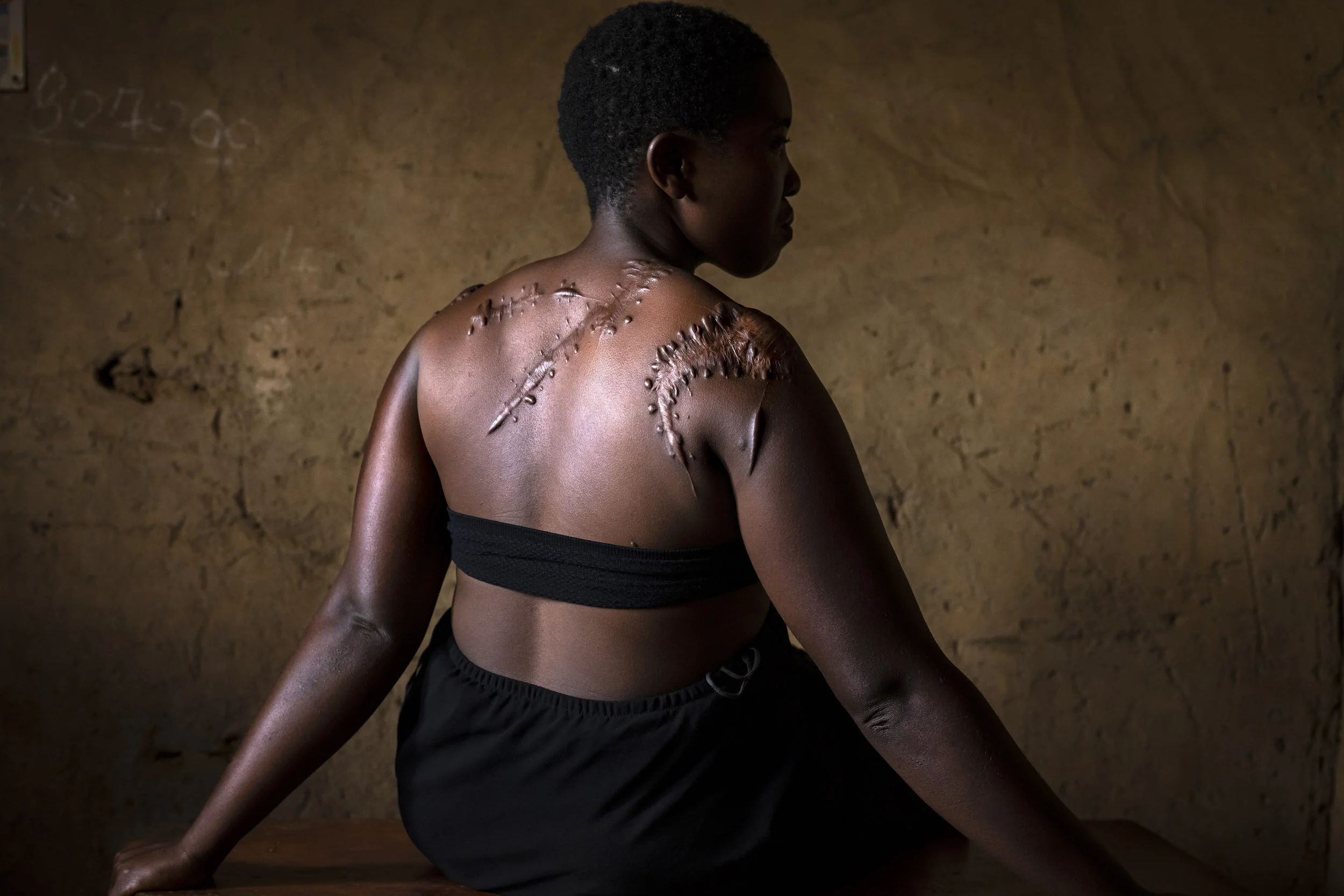
MBAOU, BENI, DEMOCRATIC REPUBLIC OF CONGO, 6 APRIL 2021: Georgette Ndovya Kavugho, 32, was attacked by members of the A.D.F Islamist group in her home on the 16th of November 2019. They struck her with machetes, leaving deep cuts in the flesh of her arms and back, eventually leaving her for dead as they continued to ransack her village. 13 people died that night, and many others were abducted. “At around 1am I heard a woman’s voice shout, “break down that door,” said Georgette, “it was because one of my young children cried out in fear that they knew we were there. When asked why the ADF did this to her, Georgette says she has no idea. She lost the use of her right arm in the attack and shortly after, her husband left her, saying she was useless. He left her with 8 children to care for. She is trying to save money for a sewing machine with pedals so she can make a living for them. For Georgette and her children, one of the worst things is that ADF has stepped up their attacks against civilians recently and they remain as vulnerable as ever. The ADF is an Islamic terror group based out of Eastern DR Congo that, in recent years, has developed a relationship with the Islamic State after pledging allegiance to ISIS leadership. They are known locally as ISIS in Congo. The ADF are one part of ISCAP, the ISIS province for Central Africa, Mozambique is the other. ADF have killed over 5000 Congolese civilians in recent years, abducted and displaced thousands and killed over 2500 Congolese army soldiers. (photo by Brent Stirton/Getty Images)

GOMA, DEMOCRATIC REPUBLIC OF CONGO, 22 JANUARY 2015: Benadete Kahindo, 32, seen with her eldest daughter Gift and 3 of her seven children. Benadete's husband was ICCN ranger Hassan Sebuyori, 34. In 2012 Hassan was targeted, killed and beheaded by FDLR, a notorious Hutu led rebel group operating inside Virunga National Park since the time of the Rwandan genocide in 1994. Benadete was forced to flee from her home after continued FDLR threats and a year later her eldest daughter Gift was raped at age 14 by the M23 rebels, a group who claimed to be opposed to FDLR. Gift gave birth to a child after the rape. Benadete's husband Hassan had been effective in stopping FDLR's bushmeat trade inside Virunga. They were angry with him for this and ambushed the ICCN vehicle in which he was travelling. FDLR dragged a wounded Hassan away with them and his headless body was discovered not far from the ambush location. His head was not recovered and his body was left as a warning to the other rangers. Benadete and her children survive on funds from the Virunga Widows fund, something dependant on donations and not guaranteed for the future. (Photo by Brent Stirton/Reportage for National Geographic Magazine.)
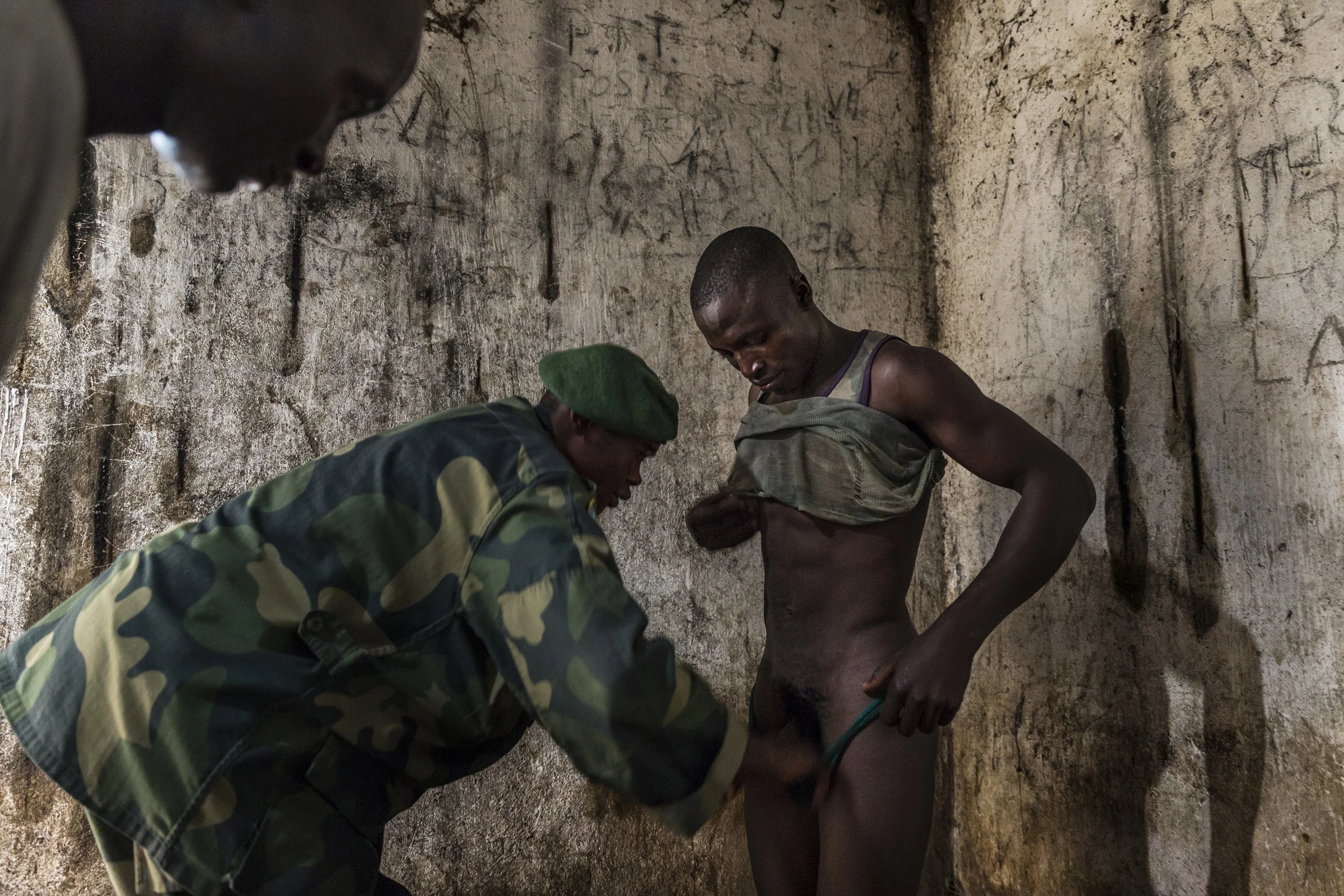
VICHUMBI, LAKE EDWARD, DR CONGO, 27 JULY 2013: Mai Mai thugs who tried to rob 5 fisherman had the tables turned on them when the fisherman knocked their single AK47 into the water and subdued them, Vuchimbi, Lake Edward, DR Congo, 27 July 2013. The thieves were handed over to a combined ICCN (Congolese Conservation force) and FARDC (Congolese Army force) troop and searched and arrested. The villagers depend on the lake for water, washing, the staple food of fishing, the transport of people and goods. Plans by Socco oil company to drill for oil in Lake Edward currently imperil all of those things. (Photo by Brent Stirton/Reportage by Getty Images.)
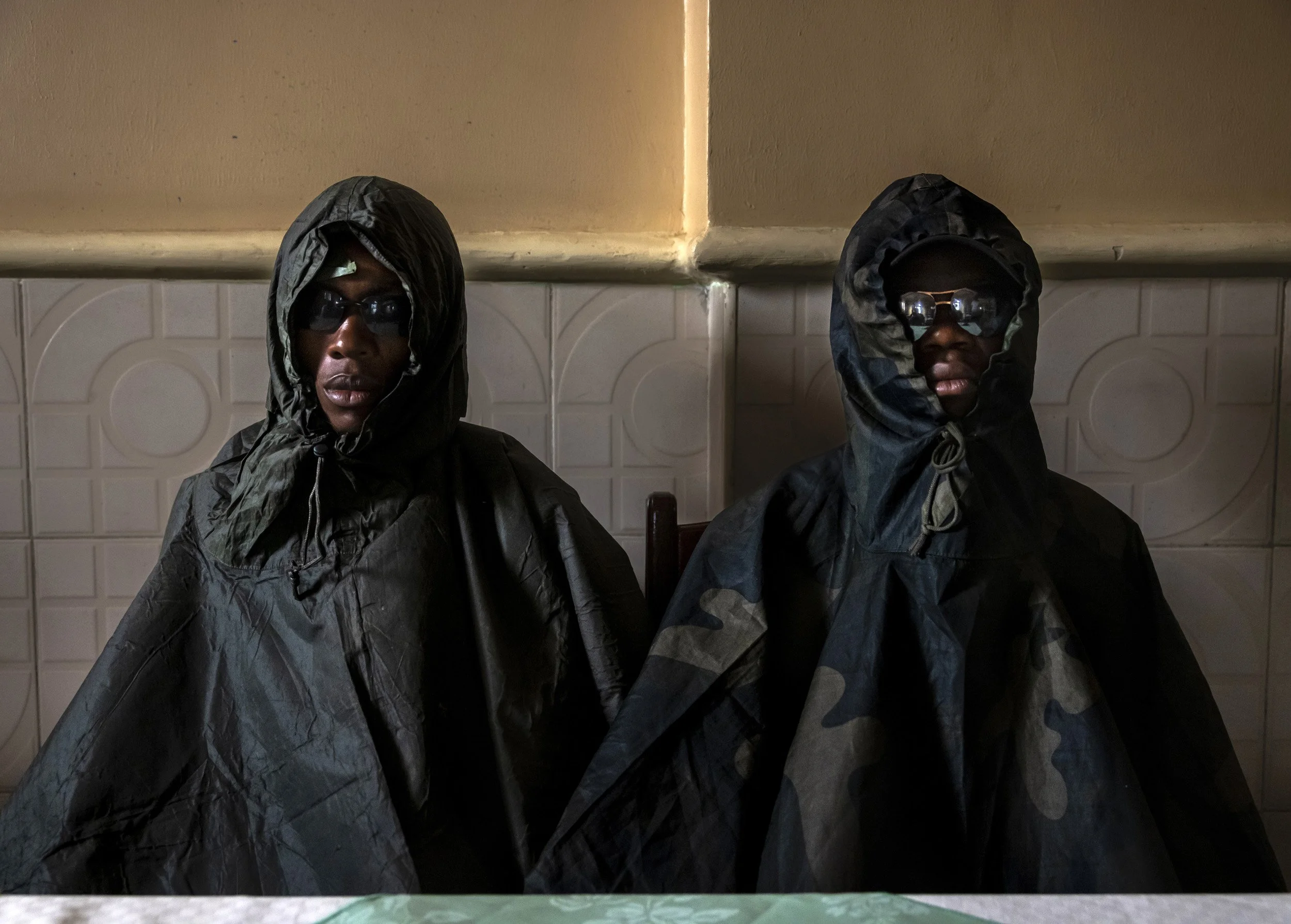
KASINDI, DEMOCRATIC REPUBLIC OF CONGO, 4 APRIL 2021: Two recently detained ADF fighters who are seen in disguise to protect their identity while they collaborate with the Congolese Army FARDC. The man on the left is Kasereka Mwinid Omar, 19, who was converted to Islam in Beni prison and radicalized. He joined ADF when he was released and become the aid to the ADF leader Musa Baluku. He cooked for Baluku and helped to move money to ADF volunteers outside of DR Congo. He was privy to many of Balukus conversations on his sattelite phone and says that Baluku spoke mainly in Arabic and claimed to be speaking to people in Somalia, Mozambique and Afghanistan. Kasereka claims that he was taught military tactics by a Somali man who came to his camp in the forest. Another Somali man taught IED skills to more senior recruits. Kasereka says many foreign fighters came to the camps, including Nigerians, Mozambicans and Somalis. They often brought “sacks of money USD.” These fighters were treated as elites and given wives if they wanted them. Musa Baluku is said to be number 2 in ISCAP, the province so called by the Islamic State which includes both DR Congo and Mozambique. The man on the right is Palu Regan, 22, a muslim who joined ADF 3 years prior. Both men have participated on attack on the Congolese army and Mai Mai groups as well as attacks on civilians. The ADF attacks on civilians are charaterized by extreme violence and beheadings. Musa Baluku justifies this in the name of the true Islam. (Photo by Brent Stirton/Getty Images.)
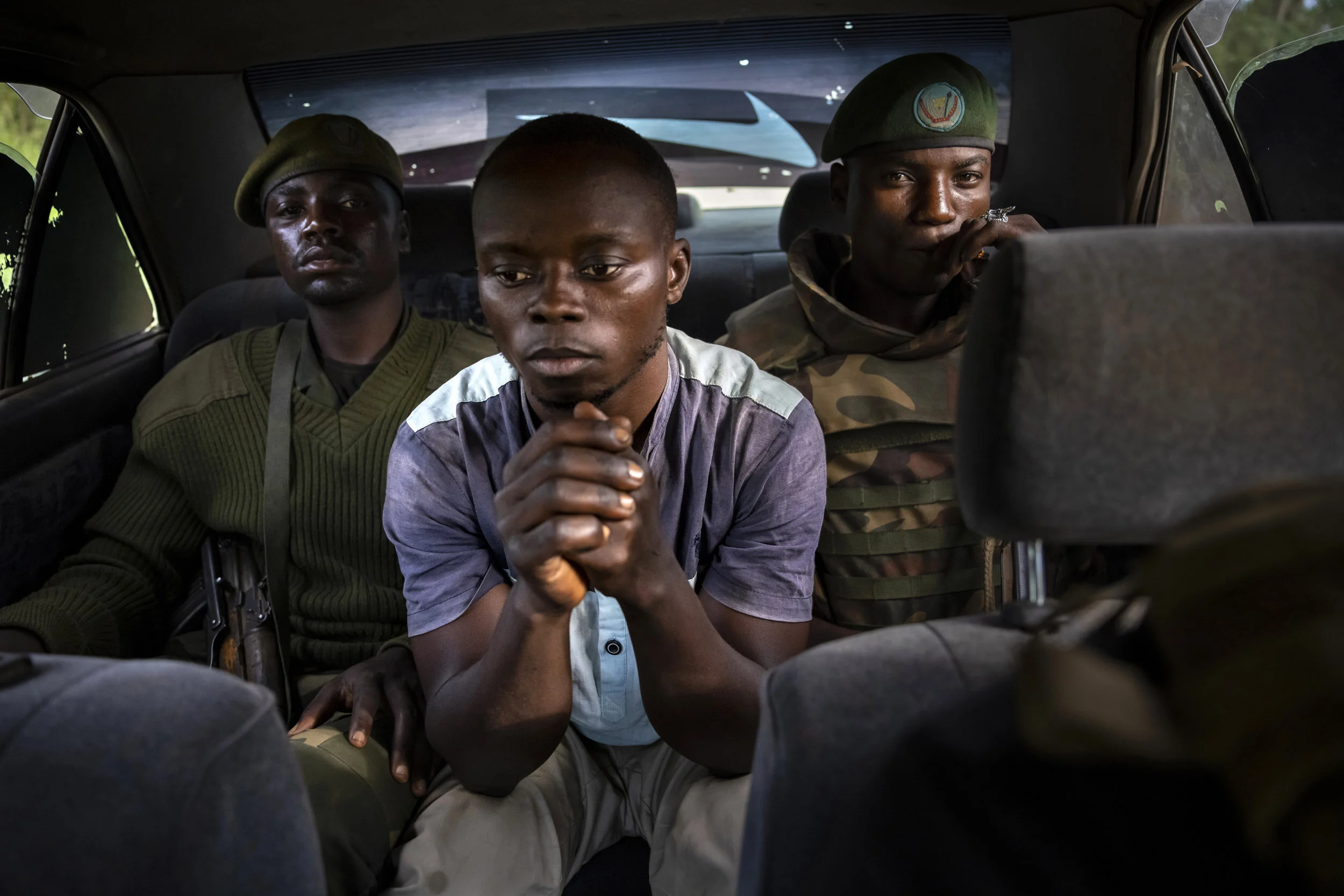
KASINDI, DEMOCRATIC REPUBLIC OF CONGO, 4 APRIL 2021: A Congolese man who is a suspected collaborator with Islamic terror group, the ADF, is seen under arrest in a vehicle on his way to interrogation by the Congolese army. He was named by two recently captured ADF fighters as a collaborator with the ADF. The ADF is an islamic terror group that in recent years have developed a relationship with the Islamic state and are one part of the so called province of ISCAP, Mozambique’s “Al-Sunnah Wal Jamaa” is the other. The ADF have killed over 5000 Congolese civilians, abducted and displaced thousands and killed over 2500 Congolese army soldiers. (Photo by Brent Stirton/Getty Images.)
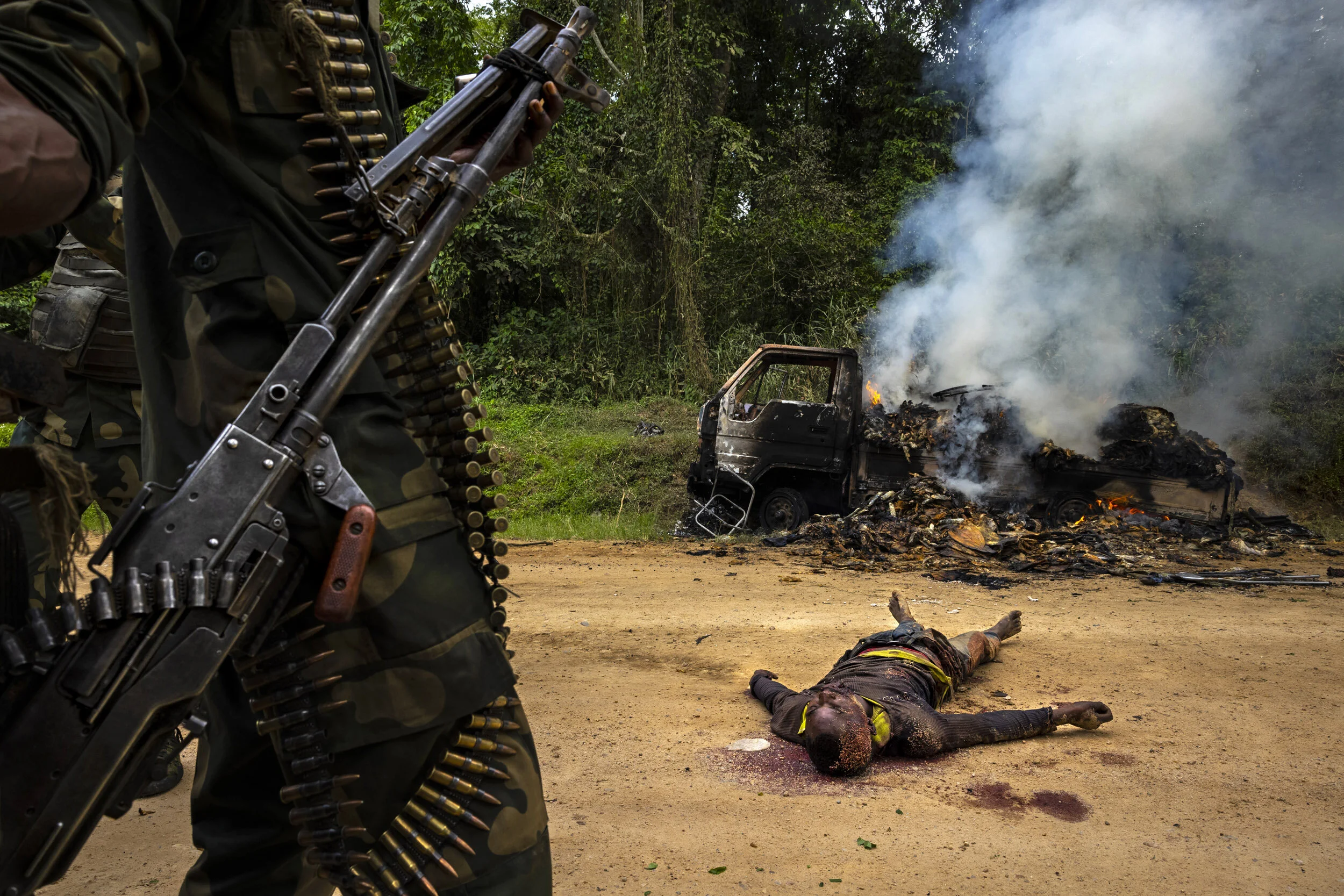
KILYA, RWENZORI SECTOR, DEMOCRATIC REPUBLIC OF CONGO, 9 APRIL 2021: Congolese Army soldiers and UN forces inspect an ambush site where an hour previously A.D.F fundamentalist rebels attacked two vehicles on the road between Beni and the Ugandan border town of Kasindi. A.D.F killed three civilians in the vehicles, assassinating them with shots to the head outside of their vehicles, there was also evidence of cuts from machetes. The Malawian contingent of the UN’s MONUSCO force arrived on scene as the ambush was ending and the vehicles were being set on fire. They engaged a large force of A.D.F fighters, killing one of them. That fighter was stripped of his uniform by other ADF fighters during the firefight, they then fled into the jungle. The purpose of the A.D.F’s attacks is to spread terror amongst the civilian population. There have been multiple attacks across the province by A.D.F, all characterized by brutality and on occasion, beheadings. The A.D.F is an Islamic terror group based out of Eastern DR Congo that, in recent years, has developed a relationship with the Islamic State after pledging allegiance to ISIS leadership. They are known locally as ISIS in Congo. The A.D.F are one part of ISCAP, the ISIS province for Central Africa, Mozambique is the other part. A.D.F have killed over 5000 Congolese civilians in recent years, abducted and displaced thousands and killed over 2500 Congolese army soldiers. (photo by Brent Stirton/Getty Images)


GARAMBA NATIONAL PARK, DEMOCRATIC REPUBLIC OF CONGO, APRIL 18TH 2019: A Garamba conservation ranger stands outside an ivory seizure room with tusks visible on the wall next to him. these tusks are consfiscated from clashes between the parks ranger force and poachers that range from armed locals to heavily armed militias like the Lords Resistance Army and militarized Sudanese poachers. Garamba is a Park in North East DRC bordering South Sudan. It is one of Africa’s oldest and most complex parks, with a difficult history. It has for many years been an elephant poaching epicenter, with heavily armed Sudanese poachers and Lord’s Resistance Army militia’s both decimating elephant populations as well as targeting the local population. African Parks signed an MOU with the ICCN, Congo’s conservation authority, in 2005. Since then, a number of rangers have continued to die in the course of their duties but slowly the park has gained traction against local poachers and foreign armed groups. From 2016 law enforcement strategy has been completely overhauled, the rangers were better equipped and technology has become a vital component in the fight. Poaching of elephants was down 50% in 2017 and in the 2018 it was down further. Over 1200 elephants remain and over 40 of those have collars for monitoring purposes. Garamba is also home to some of the last remaining Kordofan giraffe population and there is an action plan for that population. In a region of almost no economic opportunity, Garamba employs almost 500 full time staff and almost 2000 short term contract workers. There is a large amount of illegal mining around Garamba and the park is actively involved in speaking with those miners about alternative livelihoods and how the park may help with that. The Ranger force is around 300 and they provide security to tens of thousands of people who live around the park as well as vulnerable refugee groups escaping conflict in the region. (PHOTO BY BRENT STIRTON/GETTY IMAGES F

GARAMBA NATIONAL PARK, DEMOCRATIC REPUBLIC OF CONGO, APRIL 21 2019: Young Congolese conservation ranger Izako Vungunyesi is casevacked by helicopter after an incident with poachers inside the park. He was shot through the wrist and the AK 47 round also grazed his bicep. Two suspected south Sudanese elephants poachers were killed by his ranger group but not before they threw a grenade at the rangers, 4 poachers fled the scene and are being pursued by the Garamba authorities. Garamba has a very sophisticated GIS intelligence system which allows for some predictability in poacher movement. Two years previously 9 elephant were killed in this location. Today the rangers prevented a larger herd of 30-40 elephants from fired upon by these poachers, which would have led to a certain massacre. Garamba is a Park in North East DRC bordering South Sudan. It is one of Africa’s oldest and most complex parks, with a difficult history. It has for many years been an elephant poaching epicenter, with heavily armed Sudanese poachers and Lord’s Resistance Army militia’s both decimating elephant populations as well as targeting the local population. African Parks signed an MOU with the ICCN, Congo’s conservation authority, in 2005. Since then, a number of rangers have continued to die in the course of their duties but slowly the park has gained traction against local poachers and foreign armed groups. From 2016 law enforcement strategy has been completely overhauled, the rangers were better equipped and technology has become a vital component in the fight. Poaching of elephants was down 50% in 2017 and in the 2018 it was down further. Over 1200 elephants remain and over 40 of those have collars for monitoring purposes. Garamba is also home to some of the last remaining Kordofan giraffe population and there is an action plan for that population. In a region of almost no economic opportunity, Garamba employs almost 500 full time staff and almost 2000 short term contract workers. T


GARAMBA NATIONAL PARK, DEMOCRATIC REPUBLIC OF CONGO, APRIL 18TH 2019: ICCN conservation ranger Dog handlers receiving training on tracking and detection from Invictus K9 group. Garamba is a Park in North East DRC bordering South Sudan. It is one of Africa’s oldest and most complex parks, with a difficult history. It has for many years been an elephant poaching epicenter, with heavily armed Sudanese poachers and Lord’s Resistance Army militia’s both decimating elephant populations as well as targeting the local population. African Parks signed an MOU with the ICCN, Congo’s conservation authority, in 2005. Since then, a number of rangers have continued to die in the course of their duties but slowly the park has gained traction against local poachers and foreign armed groups. From 2016 law enforcement strategy has been completely overhauled, the rangers were better equipped and technology has become a vital component in the fight. Poaching of elephants was down 50% in 2017 and in the 2018 it was down further. Over 1200 elephants remain and over 40 of those have collars for monitoring purposes. Garamba is also home to some of the last remaining Kordofan giraffe population and there is an action plan for that population. In a region of almost no economic opportunity, Garamba employs almost 500 full time staff and almost 2000 short term contract workers. There is a large amount of illegal mining around Garamba and the park is actively involved in speaking with those miners about alternative livelihoods and how the park may help with that. The Ranger force is around 300 and they provide security to tens of thousands of people who live around the park as well as vulnerable refugee groups escaping conflict in the region. (PHOTO BY BRENT STIRTON/GETTY IMAGES FOR NATIONAL GEOGRAPHIC MAGAZINE)

GARAMBA NATIONAL PARK, DEMOCRATIC REPUBLIC OF CONGO, APRIL 21 2019: Easter church services for the familes of Rangers and Staff inside Garamba National Park. Garamba is a Park in North East DRC bordering South Sudan. It is one of Africa’s oldest and most complex parks, with a difficult history. It has for many years been an elephant poaching epicenter, with heavily armed Sudanese poachers and Lord’s Resistance Army militia’s both decimating elephant populations as well as targeting the local population. African Parks signed an MOU with the ICCN, Congo’s conservation authority, in 2005. Since then, a number of rangers have continued to die in the course of their duties but slowly the park has gained traction against local poachers and foreign armed groups. From 2016 law enforcement strategy has been completely overhauled, the rangers were better equipped and technology has become a vital component in the fight. Poaching of elephants was down 50% in 2017 and in the 2018 it was down further. Over 1200 elephants remain and over 40 of those have collars for monitoring purposes. Garamba is also home to some of the last remaining Kordofan giraffe population and there is an action plan for that population. In a region of almost no economic opportunity, Garamba employs almost 500 full time staff and almost 2000 short term contract workers. There is a large amount of illegal mining around Garamba and the park is actively involved in speaking with those miners about alternative livelihoods and how the park may help with that. The Ranger force is around 300 and they provide security to tens of thousands of people who live around the park as well as vulnerable refugee groups escaping conflict in the region. (PHOTO BY BRENT STIRTON/GETTY IMAGES FOR NATIONAL GEOGRAPHIC MAGAZINE)

Three days of election coverage in Georgia for the 2021 US Senate election. First image - Democrat supporters who travelled from Texas to help people to vote at the end of a rally led by Kamala Harris

Suspicious security at a Trump rally for Perdue and Loeffler, Dalton, Georgia

WASHINGTON D.C., USA - JANUARY 6: Trump supporters clash with police and security forces as people try to storm the US Capitol in Washington D.C on January 6, 2021. Demonstrators breeched security and entered the Capitol as Congress debated the 2020 presidential election Electoral Vote Certification. (photo by Brent Stirton/Getty Images)



WASHINGTON D.C., USA - JANUARY 6: Trump supporters clash with police and security forces as people try to storm the US Capitol in Washington D.C on January 6, 2021. Demonstrators breeched security and entered the Capitol as Congress debated the 2020 presidential election Electoral Vote Certification. (photo by Brent Stirton/Getty Images)

WASHINGTON D.C., USA - JANUARY 6: Trump supporters clash with police and security forces as people try to storm the US Capitol in Washington D.C on January 6, 2021. Demonstrators breeched security and entered the Capitol as Congress debated the 2020 presidential election Electoral Vote Certification. (photo by Brent Stirton/Getty Images)

WASHINGTON D.C., USA - JANUARY 6: Trump supporters clash with police and security forces as people try to storm the US Capitol in Washington D.C on January 6, 2021. - Demonstrators breeched security and entered the Capitol as Congress debated the 2020 presidential election Electoral Vote Certification. (photo by Brent Stirton/Getty Images)

WASHINGTON D.C., USA - JANUARY 6: Trump supporters clash with police and security forces as people try to storm the US Capitol in Washington D.C on January 6, 2021. - Demonstrators breeched security and entered the Capitol as Congress debated the 2020 presidential election Electoral Vote Certification. (photo by Brent Stirton/Getty Images)

WASHINGTON D.C., USA - JANUARY 6: Supporters of US President Donald Trump protest inside the US Capitol on January 6, 2021, in Washington, DC. - Demonstrators breeched security and entered the Capitol as Congress debated the 2020 presidential election Electoral Vote Certification. (Photo by Brent Stirton/Getty Images)

WASHINGTON D.C., USA - JANUARY 6: A protester dressed as George Washington debates with a Capital Policemena before being pushed out. Supporters of US President Donald Trump protested inside the US Capitol on January 6, 2021, in Washington, DC. - Demonstrators breeched security and entered the Capitol as Congress debated the 2020 presidential election Electoral Vote Certification. (Photo by Brent Stirton/Getty Images)
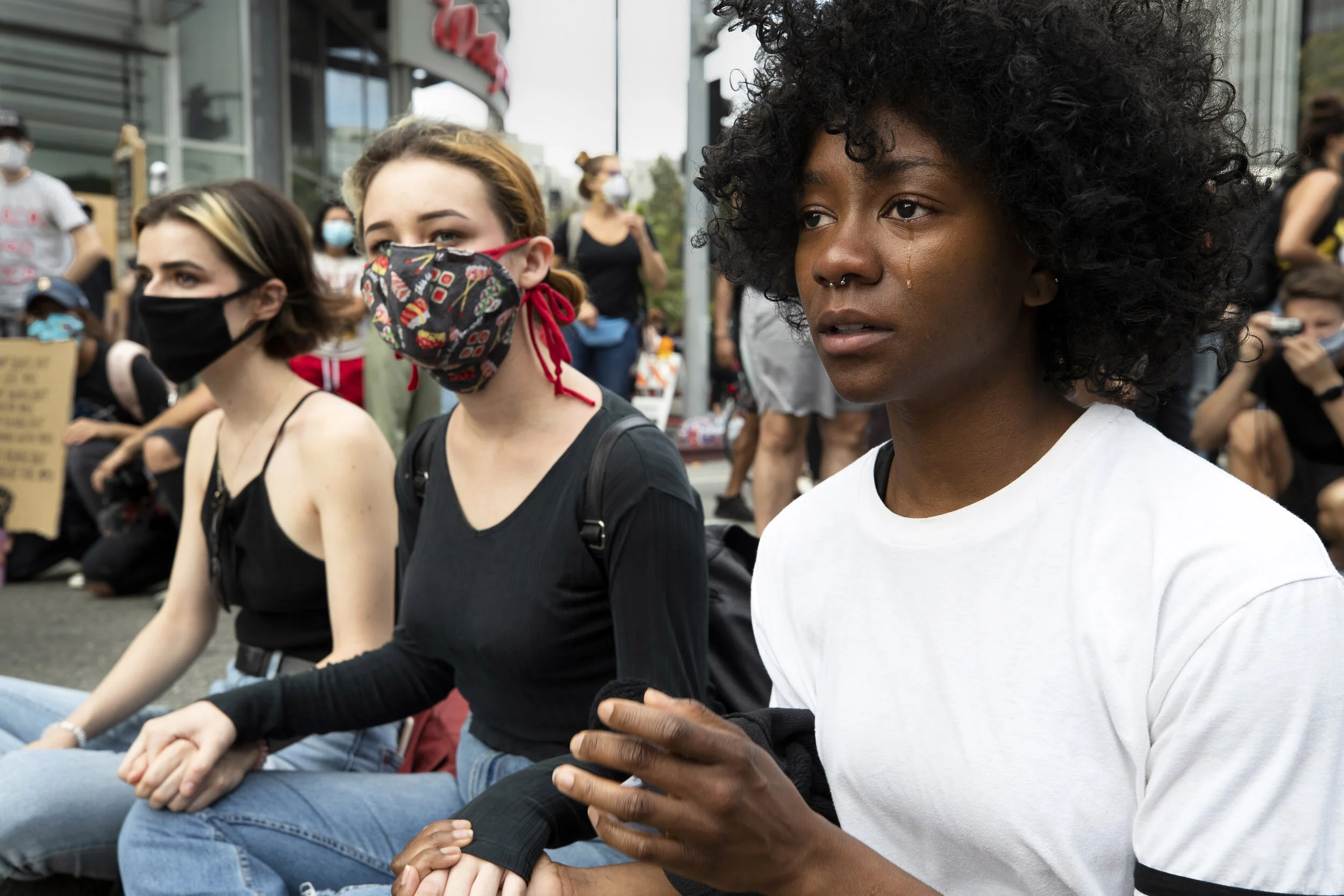
Los Angeles George Floyd riots day 7
I was in Africa for most of the BLM protests, these are few images from one day of protest that I was able to attend.LOS ANGELES, CALIFORNIA - A young African-American woman cries for "everybody's pain," as thousands of demonstrators marched peacefully in Los Angles today in response to George Floyd’s death. Floyd asphixiated to death while being held down by Minneapolis police officer Derek Chauvine, he and three other policemen at the scene have been fired and taken into custody. Chauvin is seen kneeling on Floyd's neck as he pleaded to breathe. Floyd was pronounced dead when paramedics arrived. A video of the incident quickly went viral, prompting riots across many American cities. Today was day seven in Los Angeles and the march was characterized by more love than hatred amongst the protestors who, in the vast majority of cases acted respectfully and with dignity towards the National Guard and Police. (Photo by Brent Stirton/Getty Images)

Los Angeles George Floyd riots day 7
LOS ANGELES, CALIFORNIA - Thousands of demonstrators marched peacefully in Los Angles today in response to George Floyd’s death. Floyd asphixiated to death while being held down by Minneapolis police officer Derek Chauvine, he and three other policemen at the scene have been fired and taken into custody. Chauvin is seen kneeling on Floyd's neck as he pleaded to breathe. Floyd was pronounced dead when paramedics arrived. A video of the incident quickly went viral, prompting riots across many American cities. Today was day seven in Los Angeles and the march was characterized by more love than hatred amongst the protestors who, in the vast majority of cases acted respectfully and with dignity towards the National Guard and Police. (Photo by Brent Stirton/Getty Images)

TIMBUKTU, SEPTEMBER 2009: The Imam of the Djingareiber Mosque, Timbuktu's oldest and most important Islamic place of worship, seen during Ramadan, September 6, 2009. Timbuktu is a historical Malian city, a long established centre of learning for Africa, Islam is at the heart of that learning as is medicine, science, law and technology. (Photo by Brent Stirton/National Geographic.)

TIMBUKTU, MALI, JANUARY 2010: Late Afternoon scenes at a funeral in the streets of Timbuktu, MALI, 5 JANUARY 2010. Funerals in Timbuktu are conducted separately, with the woman mourning inside the house of the deceased and the men outside on the street involved in prayers and remembrance in the Islamic tradition. (PHOTO BY BRENT STIRTON/NATIONAL GEOGRAPHIC.)

TIMBUKTU, SEPTEMBER 2009: Scenes from the port of Timbuktu at the apex of the Niger River, Timbuktu is a historical Malian city, a long established centre of learning for Africa on 12 September 2009. (Photo by Brent Stirton/National Geographic.)

TIMBUKTU, SEPTEMBER 2009: Images of temporary camps and houses on the outskirts of Timbuktu in the middle of a sandstorm, Mali, September 15, 2009. Timbuktu is a historical Malian city, a long established centre of learning for Africa. It has traditionally consisted of a mix of Tuareg and Songhay people. (Photo by Brent Stirton/National Geographic.)

TIMBUKTU, SEPTEMBER 2009: Children play in the rain in a welcome respite from the desert heat in a street scene in Timbuktu, a historical Malian city, a long established centre of learning for Africa, , September 11, 2009. (Photo by Brent Stirton/National Geographic.)
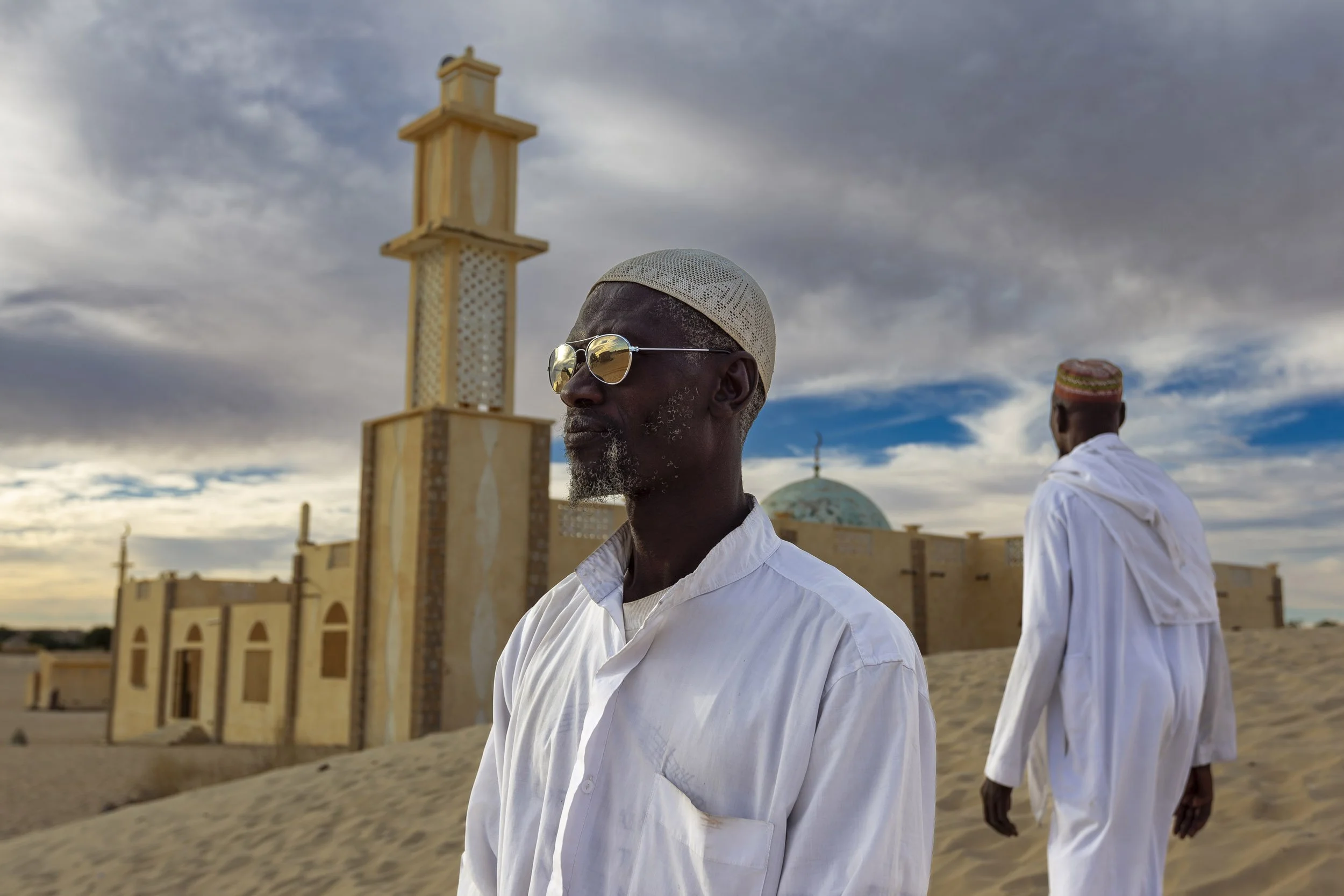
TIMBUKTU, MALI, JANUARY 2010: A Mosque and two muslims on the outskirts of Timbuktu, the mythical Northern Mali city, 23 January 2010. (Photo by Brent Stirton/Reportage by Getty images.)
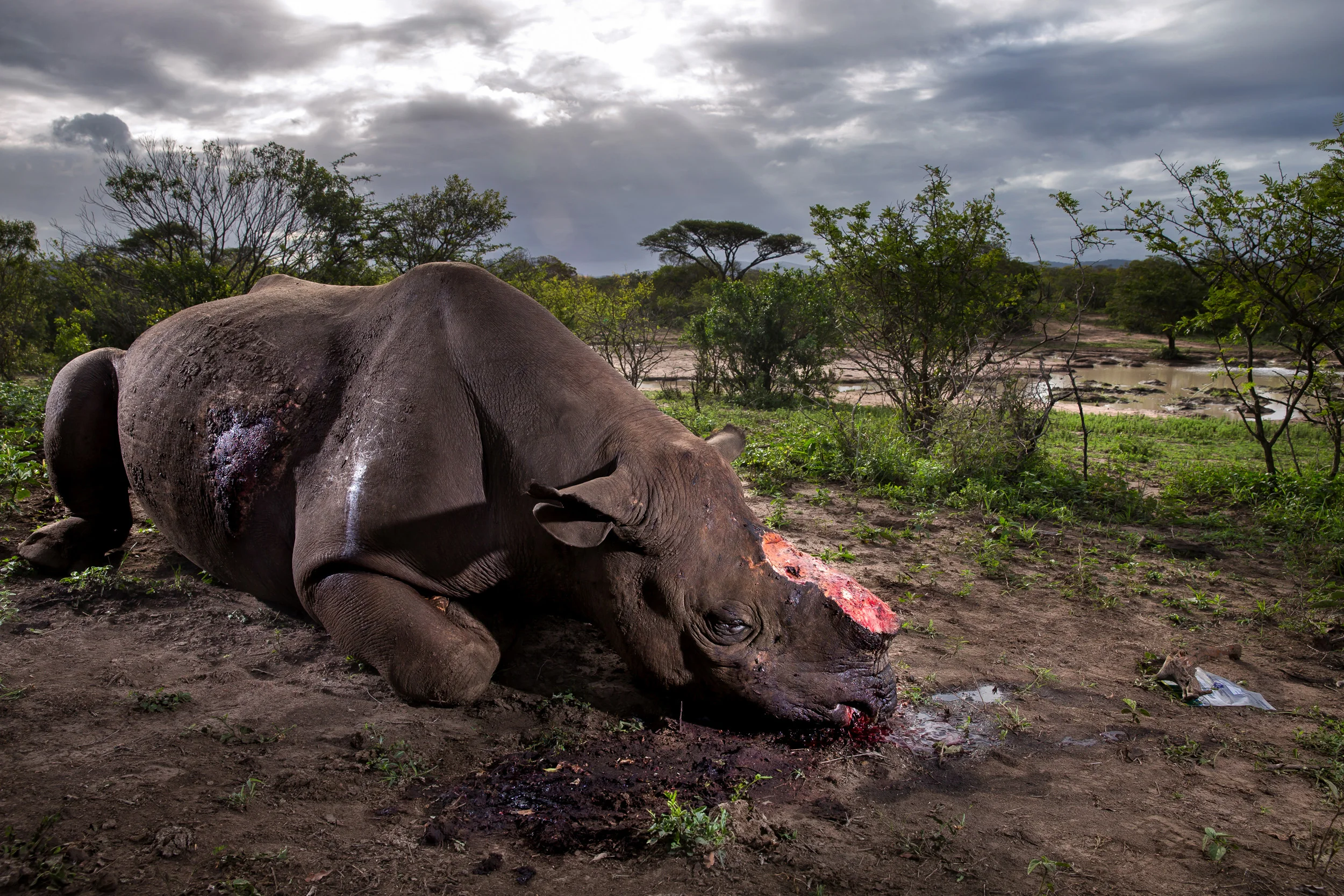
Rhino Wars This photo essay attempts to look at the environmental crisis caused by Asia’s appetite for Rhino horn. The horn is part of an ancient Asian medical system and today is seen as a curative for everything from Cancer to Kidney stones. Essentially keratin, a mild alkaline substance identical to fingernails, the horn is ground down in grinding bowls and mixed with water. This is then ingested by the sick and the wealthy of Vietnam and China, the imbiber hoping for miracle cures, when in fact science shows us it has a placebo effect at best. The use of horn dates back over 2000 years but the recent economic rise of countries like China and Vietnam and the subsequent wealth of the new upper class has had disastrous effects on the world’s remaining rhino population. Rhino horn is now worth more than gold and the poaching crisis is a perfect storm of that value playing out in the most corrupt wildlife systems with some of the poorest poachers as well as rhino ranchers who see millions of dollars in pushing to legalize the trade. South Africa is the main repository of the world’s remaining rhino, figure less than 20,000 animals. South Africa is on track to lose over 1600 animals this year, a figure that has risen every year since 2006 when less than 20 animals were killed for their horns. This essay examines the crisis along the Mozambique/South African border where daily incursions by armed poachers has resulted in a war which plays out inside Kruger National Park, the largest reserve for rhino in the world. We see the poachers with silenced weapons, the middle men arrested in sting operations by Mozambican authorities and the few rhino who dare to venture into Mozambique, protected by a tiny NGO who is the only effective organization in country. The average life expectancy for a Kruger rhino in Mozambique is 24 hours, a country where they were recently declared extinct. The essay goes on to show widows who have lost husbands and sons in this fight, range

LIMPOPO, SOUTH AFRICA, 2 APRIL 2016: “Shoelaces on steroids.” That's how Saving the Survivors PR Spokesperson Suzanne Boswell Rudham described Tuesday's groundbreaking procedure using human abdominal surgery technology to stretch the wounded edges the gaping wound created by horn poachers who removed most of the face of the world's most famous rhino, “Hope.” The Saving the Survivors team member joined a team of top wildlife vets on a Limpopo plot of land, where they stitched the elastymers, imported from Canada, on to Hope's battered face. They are hoping that it will to pull the edges of the wound together and finally heal the massive wound, which happened when poachers hacked off almost all of her face last May. But the world-famous animal with the indomitable spirit has clung to life - and has become an ambassador for the conservation of her ever-threatened species, Johan Marais, a wildlife vet and founder of Saving the Survivors, told a small group of onlookers gathered around him and his team. In a procedure that lasted just over an hour, they inserted pulley systems in Hope’s skin to "crank the laces" to close the massive cavity on her face. In Hope's latest procedure - she has already had five major surgeries and other smaller ones - they used an abdominal re-approximation anchor system, imported from Canada by local distributors Surgitech. "Basically it's developed for people who've had stomach surgery where they can't close the wound," Rudham explained. "Whereas before they used it to stitch it and staple it, now this system... actually pulls in the tissue without destroying any cells." In the past year, 60% of Hope's face has healed, but she's not out of the woods yet, explains Marais. Hope’s gaping wound is constantly attacked by flies and maggots. "We're hoping to make that cavity a lot smaller and then we'll put a wound matrix over that with collagen for the cells to start growing together," adds Rudham. After the procedure, the bandaged rhi

Baoloc, Vietnam, 6 October 2011: A wealthy Vietnamese woman sits and grinds Rhino horn for her personal consumption in a roadside café in Baoloc, Vietnam. The dealer who sold her the horn sits next to her. Rhino Horn is an illegal substance in Vietnam yet both the woman and her dealer have no fear of the police, grinding the horn in a café in full view of the street. The dealer states that he pays $1500 a month to the right people and they can carry on with impunity. The woman says that it has cured her Kidney Stones and now she takes it daily for her general health. Rhino horn is generally used as a fever reducing agent and for the removal of toxins across Vietnam, the biggest market for horn today. Rhino horn has even been held up as a cure for Cancer by a senior Minister in the Vietnamese government. Rhino horn is now worth more than gold on the international market. 100 grams of Rhino horn in Vietnam sells for $2500 to locals and over $8500 to foreign buyers, these were the prices consistently offered to our investigative team in meetings with 5 separate dealers across the country in October 2011. The demand for Rhino horn is now fueled by a newly wealthy Asian middle and upper class that can afford the substance which was previously only for the wealthy. The price is further affected by the controlling influence of organized crime. The horn is used overwhelmingly as an anti-fever, anti-toxins medication, with thousands of years of cultural belief behind the practice. This is despite the fact that Rhino horn is now an illegal substance around the world. South Africa alone has lost more than 400 Rhino to illegal poaching incidents in 2011, to say nothing of those lost to legal hunting. There are less than 16000 rhino left in the world and at this compounded rate of killing, the Rhino is racing to extinction.

TUGELA PRIVATE GAME RESERVE, COLENSO, NATAL, SOUTH AFRICA, NOVEMBER 2010: Images of a female rhino who 4 months ago survived a brutal dehorning by poachers who used a chainsaw to remove her horns and a large section of bone in this area of her skull, Natal, South Africa, November 9, 2010. The poachers surveyed the area by helicopter, mapped out the movements of the Rhino and the Guards and then darted the animal and hacked of the horn with a chainsaw. In an act of callous brutality they left the animal alive when they left with the horns. This Rhino was consequently found the next day wandering around in unimaginable pain. She also had a young 4 week old calf who was seperated in the incident and subsequently died of starvation and dehydration. The female adult miraculously survived the dehorning and with some vetrinary supervision has gone on to join up with a male bull who accompanies her and helps her to survive. (Photo by Brent Stirton/Reportage for WWF.)
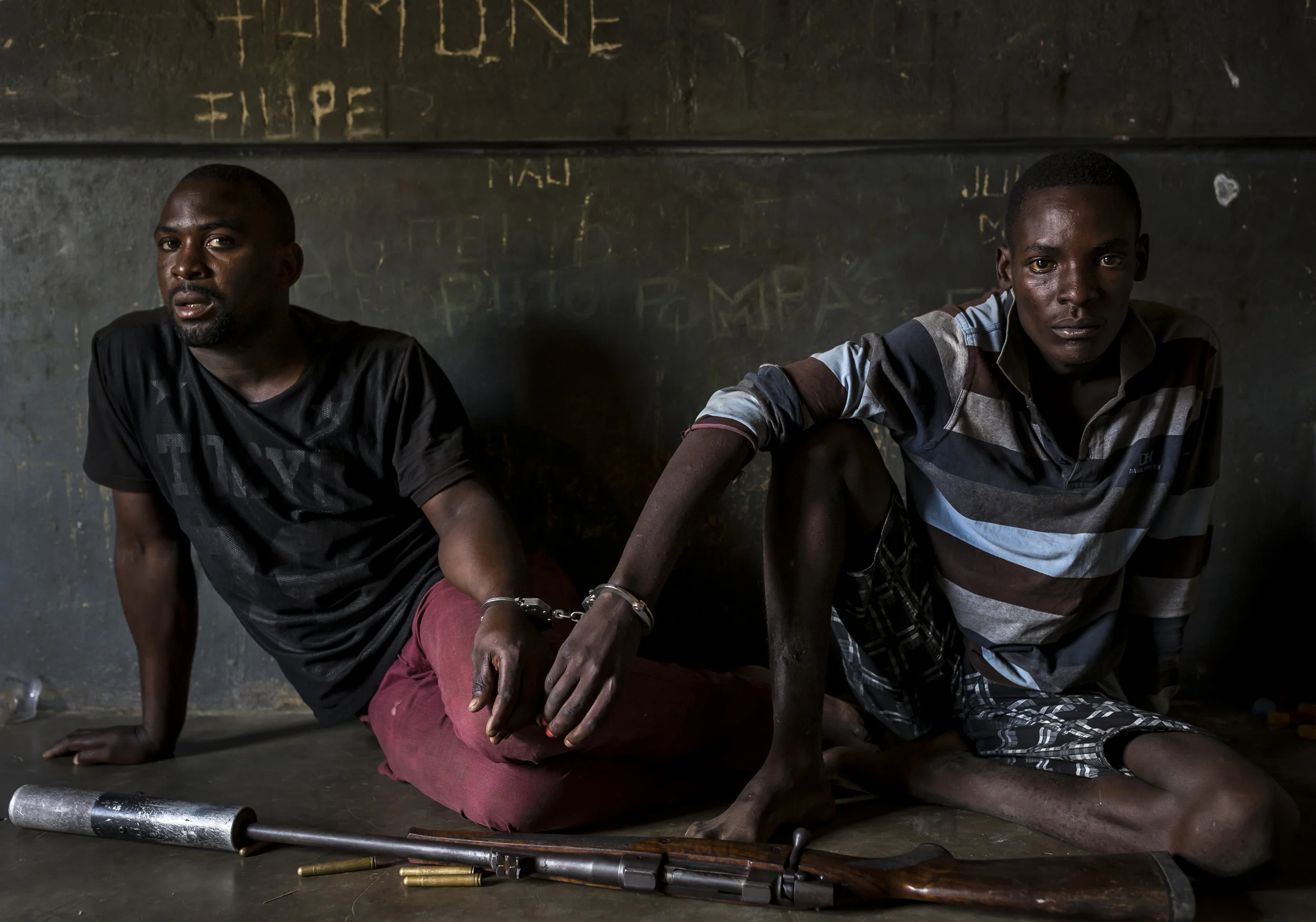
MOAMBA, MOZAMBIQUE, 19 APRIL 2016: Two rhino poachers, one 19, the other 28 years old, apprehended by an anti-poaching team in Mozambique close to Kruger National Park border. They are seen waiting to be processed in the local jail. After a three day chase they were caught in a roadblock and the rifle seized shortly thereafter. This was due to a co-ordinated effort between Kruger National Park in South Africa where the poachers intended to shoot rhino for their horn; and Sabi Game Park, a conservancy on the Mozabique side. The poachers were tracked and identified by their unique shoe pattern. They tried to say they had been on their way to buy cattle but had no money on their persons and the alleged cattle owner said he did not know anything about selling his cattle. A Czech CZ .458 hunting rifle was seized, complete with a professionally built silencer. Both men admitted their guilt and will be charged under new Mozambican law which states that possesion on the weapon and bullets indicates intent to poach rhino, this carries a maximum sentence of 12 years and/or $80,000.00. Their Toyota Hilux vehicle was also confiscated. The younger of the two poachers, 19, later led police to the homes of suspected weapons and transport suppliers, higher ups in the rhino poaching syndicates known as level 2's and 3's. Those men had fled by the time the police arrived but significant information was discovered in the form of identity documents, both real and forged, as well as banking account information. (Photo by Brent Stirton/National Geographic Magazine.)

VICTORIA FALLS, ZIMBABWE, APRIL 2011: Images of newly formed IAPF, The International Anti-Poaching Foundation, leading a Pro-bono training workshop for Rhino protection for Rangers who have come from all over Zimbabwe, April 5, 2011. Led by Australian Damien Mander, 31, a former Special Operations soldier in the Australian military, the IAPF is teaching anti-poaching techniques which include tracking, self-defence, observation positions, weapons training and patroling techniques including tracking, ambush and arrest techniques. The work is largely pro-bono and is supported by donations. Mander has used his own money to start the organization. Rangers in Zimbabwe have little access to automatic weapons and good training and are struggling to contain rampant Rhino horn poaching across the country. Zimbabwe has significant Black Rhino numbers, of which there are now less than 3500 left in the world today.
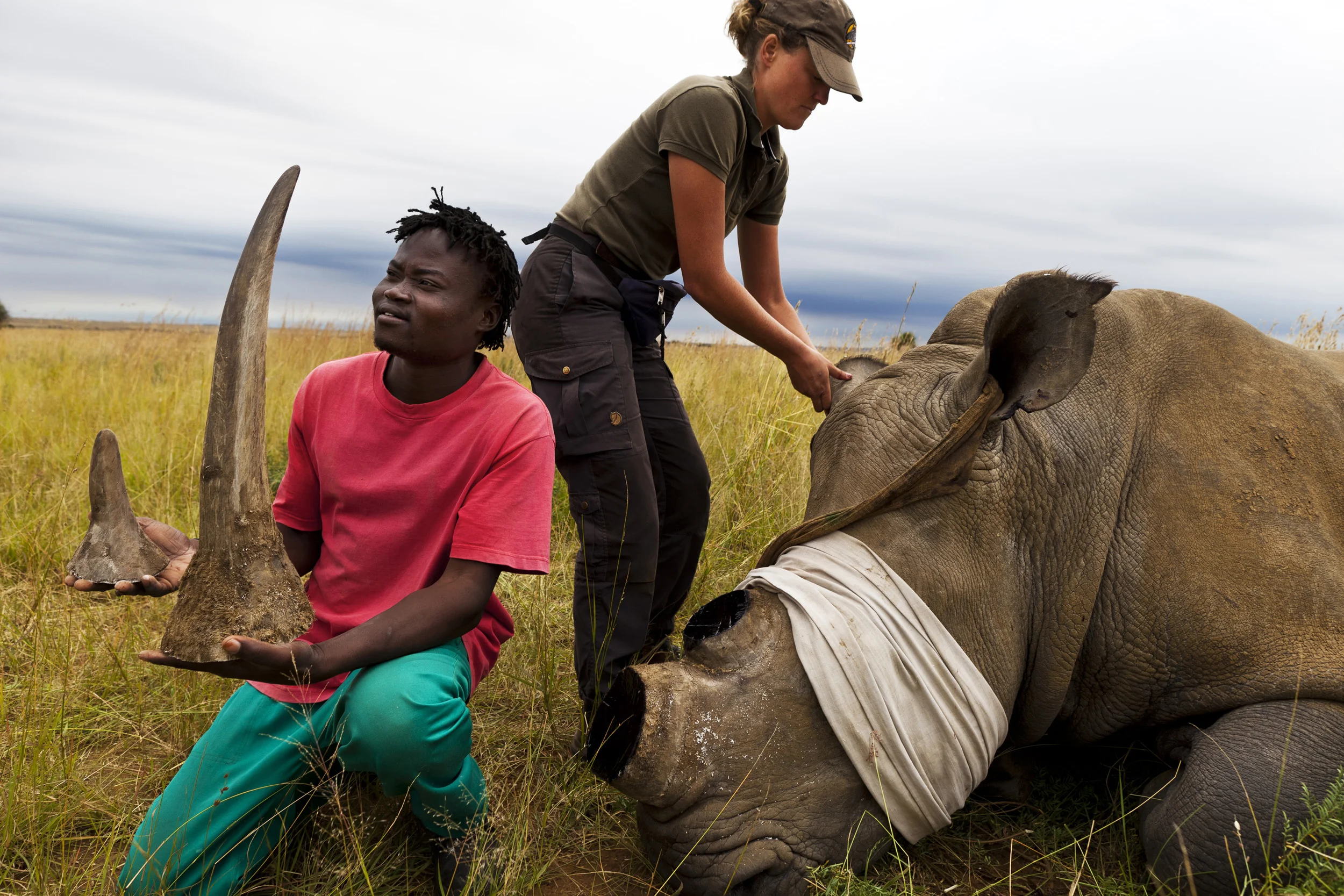
KLERKSDORP, SOUTH AFRICA, MARCH 2011: A White Rhino cow is de-horned as a precautionary anti-poaching measure on a game farm outside of Klerksdorp, South Africa, March 25 2011. The Vet's assistant is seen holding the horns for an identity picture while the Vet does a final check on the animal. Rhino Poaching has reached epedemic proportions in South Africa, with 334 killed in 2010 and over 400 killed in 2011. Many game farmers are increasingly turning to de-horning their animals as a protective measure against poaching. A 2 year study in Zimbabwe on the effects of de-horning has revealed no negative repercussions to the animal, and has seen less animals killed through fighting and horn damage. A large horn grows back after 5 years to its full size without trauma to the animal and thus can be seen as a renewable, sustainable resource for the Asian markets if legalized. At this time the only legal means to obtain a horn in South Africa is through a permitted hunt with a member of the conservation authority present. This means that the animal has to die before the horn is available. Statistics on poaching prove that the lack of access to legal horn has seen poaching become common practise and the price of Rhino horn has reached an all time high, surpassing that of gold. The counter argument to de-horning for profit is that it will lead to an interference in the natural world and an abuse of the resource in terms of animal treatment. Most Vets across South Africa have adopted de-horning as a neccesary anti-poaching technique to save the animals from being killed for their horn. On average a de-horning takes an experienced vet no more than 25 minutes to do from start to finish and the animal goes straight back to feeding with no visible sign of trauma afterwards. A standard 8 cms of stump is left behind, ensuring no actual tissue is ever damaged on the Rhino. The horns once taken are fitted with micro-chips, individually permitted and in most cases stored in bank vaults

SABIE GAME PARK, MOZAMBIQUE, 9 APRIL 2016: A combined force of Sabie Game Park Rangers, Garda Frontier soldiers and Fauna Bravia soldiers arrest and detain Moses Chauque, a level 2 rhino poacher who arranges weapons and transport for rhino poachers. There are multiple arrest warrants for Chauque, both in Mozambique and South Africa. This arrest was put together with intelligence gathered by IAPF, the International Anti-Poaching Foundation, the only effective Anti-poaching group on the ground in Mozambique. Moses Chauque was identified in statements from two seperate groups of poachers who were arrested in Mozambique with CZ hunting rifles and rhino horn. Both groups made sworn statements the Chauque contracted them for rhino poaching in nearby Kruger National Park. There are also further warrants in South Africa for his alleged involvement in two murder cases. When Chauque was delivered into Police custody in Mouamba, Mozambique, the police apparently cheered that he had finally been caught. The case against him in Mozambique will now revolve around weapons charges and the statements against him made by the two groups of arrested rhino poachers. (Photo by Brent Stirton/Getty Images Reportage for National Geographic Magazine.)

OL PEJETA CONSERVANCY, KENYA, JULY 2011: A four man anti-poaching team permanently guards a Northern White Rhino on Ol Pejeta Conservancy in Kenya, 13 July 2011. The Ol Pejeta Conservancy is an important “not-for-profit” wildlife conservancy in the Laikipia District of Kenya and the largest sanctuary for black rhinos in East Africa. It is also the home of 4 of the world's remaining 8 Northern White Rhino, the worlds most endangered animal. There has been an increase in poaching incidents on Ol Pejeta recently, in line with a massive worldwide increase in rhino poaching linked to the rise in the Asian middle class. Anti-poaching teams provide close protection to the rhino, with 24 hour observation over all rhino on Ol Pejeta and 24 hour armed guard protection over the 4 Northern White Rhino who are kept in their own Boma area. The team have developed extraordinary relationships with these Rhino, leaning on them, scratching them and displaying tremendous affection towards these most endangered of animals. Each of the men in these teams feels a genuine vocation towards the protection of these animals, something the rhino seem to sense, and this emerges on a daily basis as the men walk with the rhino through their day.


KRYVYI RIG, UKRAINE, AUGUST 2011: Maria, a drug addict and sex worker, entertains a client in a room she rents in a house from an old lady, Kryvyi Rig, Ukraine, 28 August 2011. Maria uses drugs on a daily basis and sees many men every week but remains HIV negative. She claims she need the money to support herself, her habit and her 9 year old daughter. (Photo by Brent Stirton/Reportage for Getty Images.)
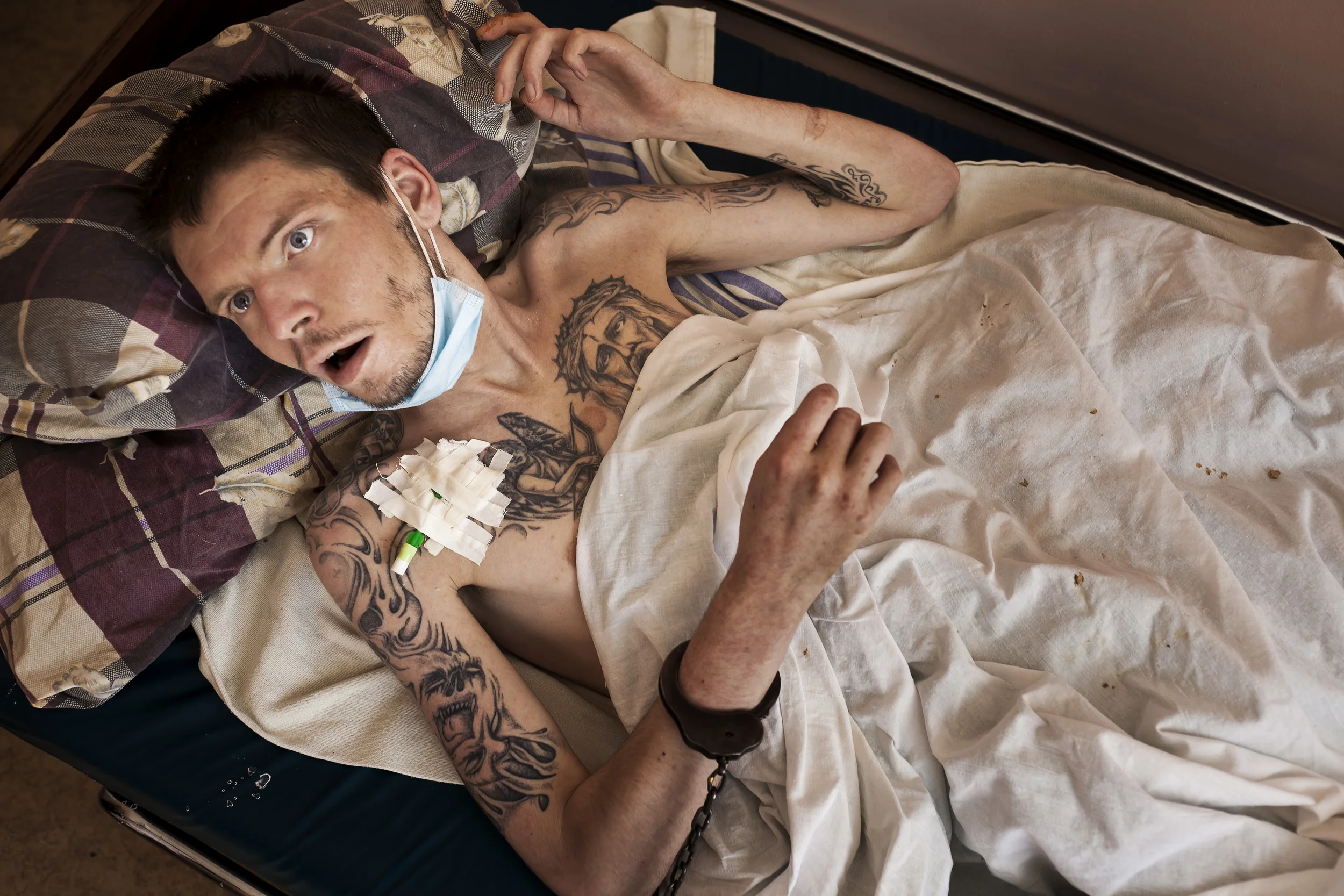
KIEV, UKRAINE, AUGUST 2011: A prisoner n the last stages of full-blown Aids who has been rushed to the Kiev Aids Center from prison receives compassionate care from a doctor while chained to the bed, The Kiev Aids Center in Kiev, Ukraine, 25 August 2011. This facility is one of two in Ukriane and deals with many drug addicts and other difficult Aids infected people. There are strict rules and conditions in the wards which staff claim are neccesary to protect them from aggressive, manic patients. (Photo by Brent Stirton/Reportage by Getty Images.)
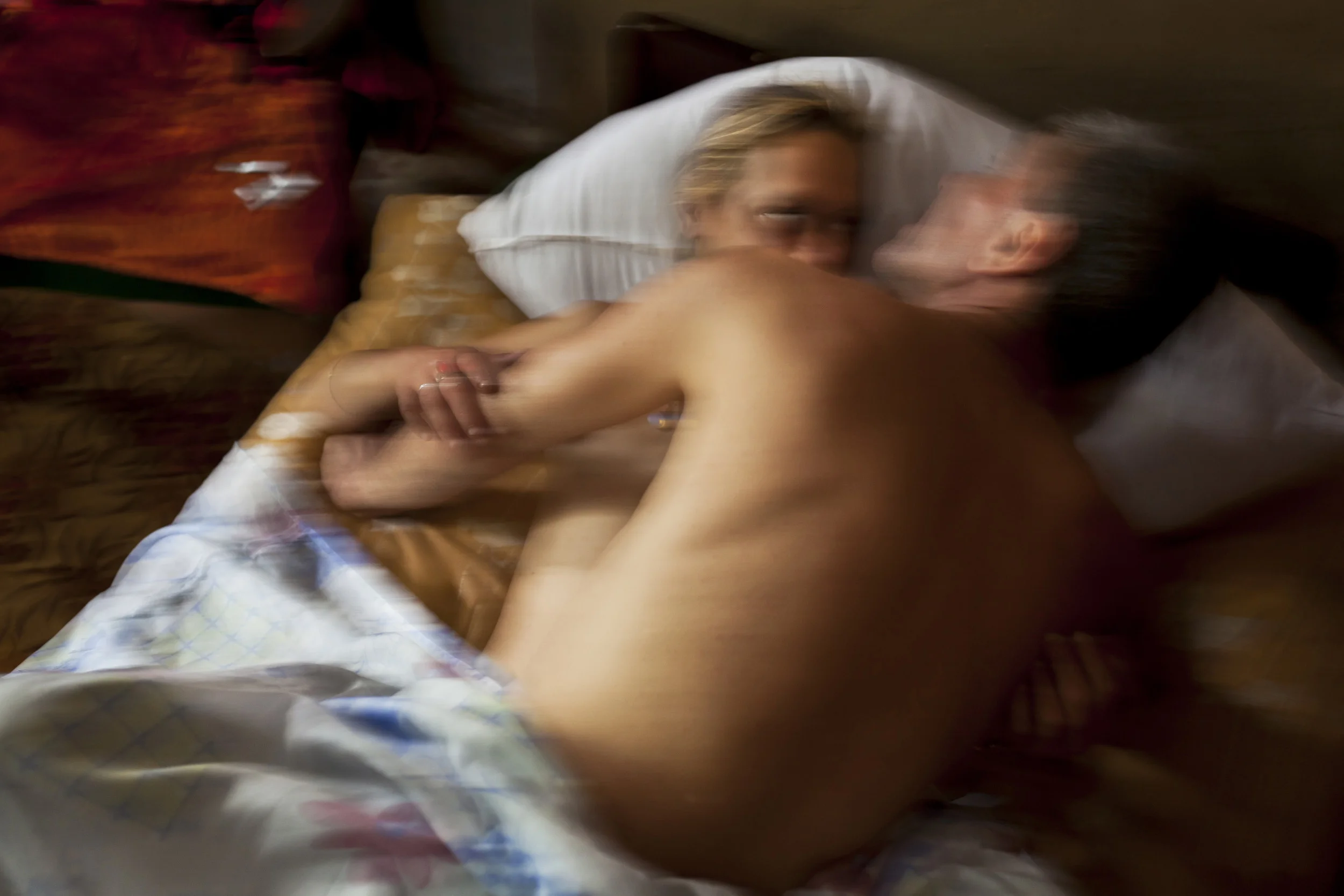
KRYVYI RIG, UKRAINE, AUGUST 2011: Maria, a drug addict and sex worker, entertains a client in a room she rents in a house from an old lady, Kryvyi Rig, Ukraine, 28 August 2011. Maria uses drugs on a daily basis and sees many men every week but remains HIV negative. She claims she need the money to support herself, her habit and her 9 year old daughter. (Photo by Brent Stirton/Reportage for Getty Images.)

POLTAVA, UKRAINE, AUGUST 2011: Scenes inside Poltava Tuberculosis clinic, a facility with insufficent resources which is the only facility for Tuberculosis patients in Poltava, Ukraine, 26 August 2011. (Photo by Brent Stirton/Reportage by Getty Images.)

KHARKOV, UKRAINE, AUGUST 2011: An HIV+ addict who has lost his lower jawbone to the corrosive effects of "Krokodil," a deadly new Ephedrine based Amphetamine drug photographed in a small apartment in a housing project in Kharkov, Ukraine, 28 August 2011. This drug originated in Russia and has quickly moved to Ukraine. It has a corrosive effect on the human body, eating away at the flesh of needle entry points and corroding bones in the body. Mass unemployment and perceived government apathy mean that many young people turn to drugs to escape the fatalism of their lives. As a result many are infected with HIV through needle use and unprotected sex. Ukraine is the most Aids infected nation in Europe.

POLTAVA, UKRAINE - AUGUST 12 2005: Tanya, 29, a sex-worker and drug user who is HIV+. She has an eleven year old son and lives with 5 other sex workers in a small apartment in a poor neighbourhood. She used to weigh 100 kilograms but has wasted away to nothing. She has severe septicemia on her legs and a rampant addiction. Tanya tells that sometimes in the past wealthy men would seek her out for sex as part of a bizarre "Russian roulette with Aids" scenario, where they would have unprotected sex and dice with the odds of contracting HIV. Tanya died one month after this photograph was taken. Ukraine has the highest HIV rates in Europe today.

KRYVYI RIG, UKRAINE, AUGUST 2011: Addicts undergo sleep therapy during the drug detox program at Psycho Neurological Dispensary, Kryvyi Rig, Ukraine, 31 August 2011. This program has good success in getting patients back to a pysiological level where they can receive counselling for their addictions. (photo by Brent Stirton/Reportage by Getty Images.)

KIEV, UKRAINE, SEPTEMBER 2011: Scenes from the Tuberculosis Hospital in Kiev, Ukraine, 7 September 2011. Staff work under difficult conditions, with many patients who are drug addicts and criminals. There are also severe shortages in terms of funding for new equipment and security for the staff. Staff in the hospital have been attacked by patients, police are afraid of the disease these patients carry and have not acted to protect the nurses and doctors who risk their lives daily in the care of these patients. (Photo by Brent Stirton/Reportage by Getty Images.)

MBOKI, CENTRAL AFRICAN REPUBLIC, 25 NOVEMBER 2014: Soldiers on patrol from the African Union Ugandan Armed forces, UPDF, base at Mboki, Central African Republic. The Ugandan contingent based here are focused on the aprehension of the Lord's Resistance Army, LRA, the notorious rebel group led by Joseph Kony which has terrorized citizens of Uganda, C.A.R, South Sudan and the Democratic Republic of Congo for the last 4 decades. Soldiers are seen crossing a river, a technique they have perfected with ropes despite the fact that many of the men cannot swim. Captain (Photo by Brent Stirton/Reportage by Getty Images for National Geographic Magazine.)

ZAKOUMA NATIONAL PARK, CHAD: Rangers from a horse patrol group exhibit their riding skills as they return to base at Zakouma National Park, Chad. The horse patrols are the old guard of Zakouma's rangers and have seen a good deal of conflict in their time in the park. Zakouma lost nearly 75% of its elephants in the decade before 2011 due to raids by Janajaweed and Sudanese poachers, many of them from the Sudanese military. The president of Chad, Idris Deby, is a big supporter of the elephant of Zakouma and of its elephants. The herds here until recently used to be as large as 1000 animals all moving together, severe poaching over the last decade saw that number decimated and now only around 20% of the number remains. Since 2011 however there has been control over poaching and there has not been a single elephant poached in the last 2 years. The credit for that lies with these rangers and the new management of the park.

GULU, UGANDA, 21 NOVEMBER 2014: Margret Acino, 32, was attacked by members of the Lord’s Resistance Army when she was 23 and 9 months pregnant. Her lips, ears and nose were cut off and her breasts were hacked by a group of LRA men. Margret and a small group of villagers had gone to the fields for crops when they found themselves surrounded by the infamous rebels. They were taken quickly to an area outside of Gulu where the men accused them of informing on the LRA to the Ugandan Army. Two men and a child were then immediately killed with the hoes they had been carrying for farming. The commander of the rebels accused them again, confronting Margaret and accusing her of being the wife of a soldier. Her husband was in fact a simple farmer. The LRA commander then killed another women in front of her. He said this must be the truth or how could she be so confident in talking with them. He then said he would teach her not to inform ever again. He ordered his men, mostly young teenagers, to produce a razor blade. They hesitated and the commander then threatened his own men, one of them produced a razor blade and they were ordered to cut off Margret’s lips, ears and nose, a practice that was becoming an LRA trademark at the time. When the men were finished, Margret was released and told to run. She passed out from loss of blood shortly thereafter and when she revived she found a man with a bicycle who took her to an IDP. She was in surgery for 2 days, her baby was born via an emergency caesarian and Margret then lapsed into a coma for 5 days. She has had 7 surgeries since to try to repair her ravaged face. The LRA commander who ordered this brutality subsequently defected and was given amnesty. Margaret saw him at a World Vision camp and became hysterical, telling people he was the one behind her tragedy. He was moved from the camp but not prosecuted. Margret has subsequently forgiven him, saying that it is easier to live with things this way. Her husband was less suppo

LOME', TOGO, 29 JANUARY 2014: Containers with 4 tons of illegal ivory confiscated in January 2014 by the Togolese customs office from its new deep water port, Lome,' Togo. This ivory has been directly linked through DNA evidence to the elephant massacre that occured in Dzanga Bai, Central African Republic in 2013. That massacre was perpetrated by Seleka rebels who climbed the observation towers at the famous forest elephant gathering place in Dzanga Bai and gunned down the elephants with automatic weapons. The Seleka rebels would have used the proceeds from this ivory sale for some of the violence which has plagued C.A.R over much of 2013 and 2014. Togo has been viewed as a new opportunity by ivory smugglers with its new deep water port. Customs officers with new Container scanning technology have made the efforts of these smugglers more difficult. (Photo by Brent Stirton/Reportage by Getty Images for National Geographic Magazine.)

RWINDI, VIRUNGA NATIONAL PARK, DRC, MARCH 2012: A combined ICCN conservation Ranger force and FARDC Congolese Army soldiers patrol both the road and inland in the Virunga National Park at Rwindi, DRC, March 8 2012. This reconnaisance patrol was conducted because of an FDLR rebel hijacking which occured on the road 2 days earlier but protecting the civilians who travel on the road through the park is now the mandate of the Rangers, a job which saw 9 Rangers killed last year. The Ranger camp has been attacked by in recent times by both FDLR, the Rwandan Hutu Genocidaires living illegally in Virunga as well as CNDP, a rebel break away faction of the Congolese army. Rwindi remains a harcore flashpoint for contacts between FDLR and Rangers on patrol in the Park. 9 Rangers were killed in Rwindi in 2011. (Photo by Brent Stirton/Reportge for GEO magazine.)

CHONDO, VIRUNGA NATIONAL PARK, DEMOCRATIC REPUBLIC OF CONGO, MARCH 2012: ICCN Congolese conservation rangers and members of the Congolese army capture illegal fisherman, Chondo, Virunga, 12 March 2012. Many of these fisherman are involved in this activity due to poverty, others are there to supply the rebel FDLR group with food. The FDLR are the hardcore Hutu's who were behind the Rwandan massacre of 1994. The fish stocks in the lake are just beginning to recover from the war, thousands of hippos were slaughtered to feed militia groups and this devastated fish stocks. This delicate recovery is what the ICCN rangers are trying to protect. This will allow a viable and sustainable fishing industry to be generated at Lake Edward, for the benefit of all. Since the FDLR fled into Virunga after the Genocide, they have sown mayhem and destruction in Virunga. 140 Rangers have died defending Virunga since 1994, many at the hands of the FDLR rebels. There are regular contacts between the Rangers and FDLR, usually resulting in injuries and deaths on either side. The Rangers, with the help of the FARDC, are winning this battle but at a heavy price. In 2011 eleven Rangers died fighting the FDLR. Virunga remains one of the most dangerous places in the world to practise conservation. (Photo by Brent Stirton/Reportage for GEO magazine.)

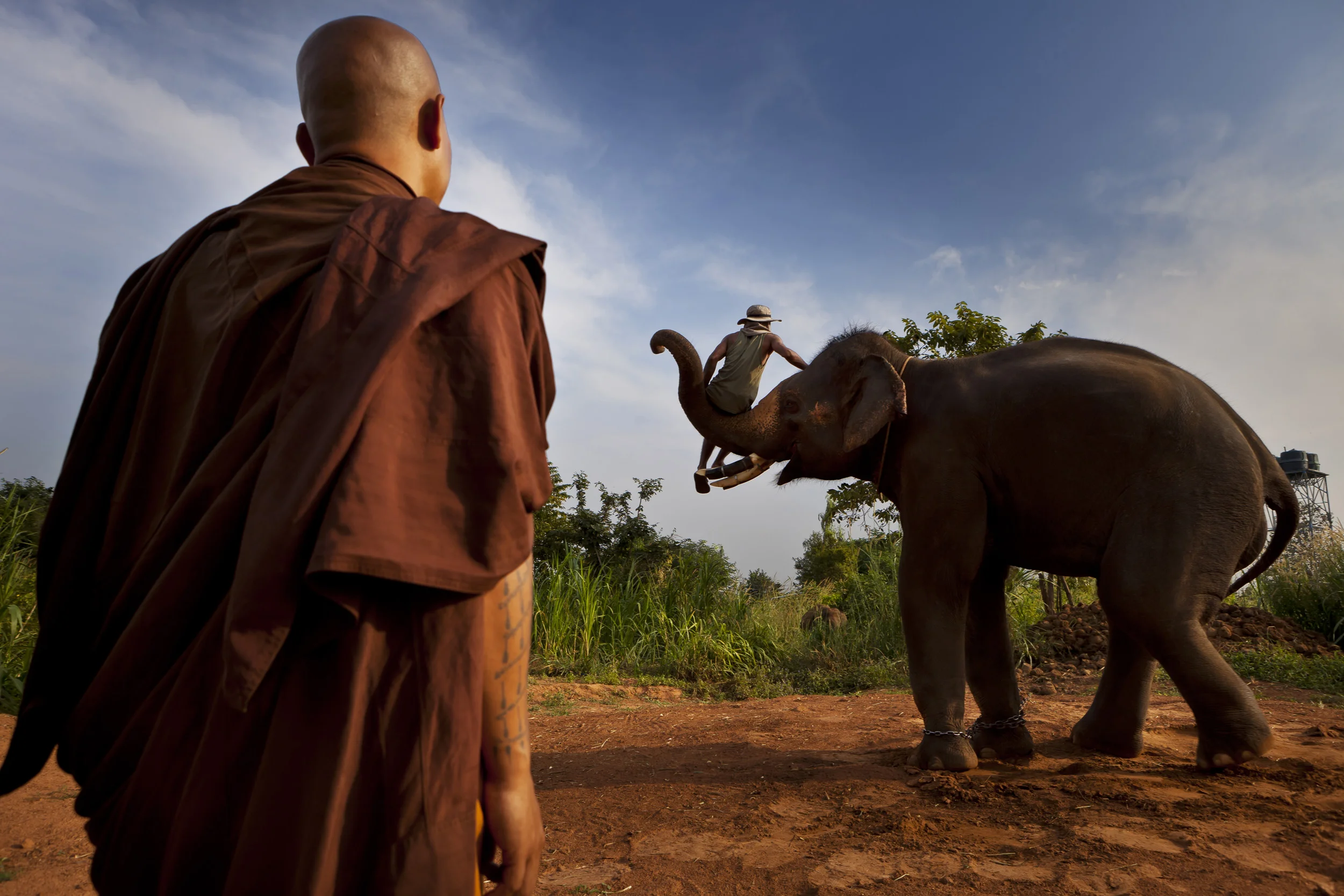
SURIN, THAILAND, NOVEMBER 2011: Luang Poo Bru Ba Dhammamunee, head abbot of Wat Suan Paa Phutthasatharn Supraditme thee Temple, photographed in Surin Elephant Village in Surin, Thailand, November 9th, 2011. The monk buys his Ivory carvings of Bhudist icons for resale purposes to his followers. He commented openly on the presence in Thailand of illegally imported African ivory and advised on how to get it into Thailand past customs authorities. He also spoke of how senior memember of the Thai parliment are behind the illegal industry. He spoke enthusiastically of business opportunities if we could get him illegal African ivory, despite his public relations campaign as a carer of elephant in Thailand. The Thai legal system has many loopholes as a result of the domestic ivory situation and Thailand is suspected of being a major transit country for illegal African ivory as a result. The sale of religious ivory icons is a big part of the domestic trade while illegal ivory and elephant goods from both Thailand and Africa regularly make their way to China. (Photo by Brent Stirton/Reportage for National Geographic Magazine.)

VALENZULEA, PHILIPPINES, JANUARY 2012: Master sculptor Marcial Bernales carves an Ivory head and hand set for a Catholic religious icon in his worshop in Valenzulea, close to Manila, Philippines, 25 January 2012. Bernales has been carving Ivory for 45 years and has made hundreds of pieces, all of which are of a religious nature in the Catholic faith in the Philippines. Many of these pieces are made with Ivory. His work is in the collections of many devotees and his ivory pieces are in great demand amongst the wealthy collectors of the Philippines. His workshop and workload are co-run by his wife Nene, who also runs his shop in Manila. She is a long running expert in the garments that clothe these religious icons. Their brisk trade is evidence of the demand for Ivory, they claims to use only pre-ban ivory but that is questionable given the attraction of price for ivory at 20000 pesos ($500) a kilo for raw ivory and far more for carved Benales masterpieces. It also illustrates the loophole in Ivory legislation whereby it is very difficult to tell pre-ban and post ban ivory apart. Once it is in the Philippines there are no records or statistics through which to verify claims, despite the fact that this is a centre for world ivory carving. (photo by Brent Stirton/Reportage for National Geographic Magazine.)

MALOLOS, PHILIPPINES, JANUARY 2012: Dez Battista, an expert on religious icons in the Philippines, prepares his " Nuestra Senora Reina del Ciela," (Our Lady of Heaven," for a religious procession in the streets of Malolos, the birthplace of the Santo Nino phenomenon in the Philippines, January 28 2012. The Icon has head and hands made of solid Ivory, these pieces were comissioned by Mr Battista 15 years ago. This is post Ban Ivory and it is unknown whether this work is made from illegal ivory, of which there is a great deal in the Philippines, mostly used for the carving of religious iconography. The procession will feature 200 similar icons, many of which are made of Ivory. (Photo by Brent Stirton/Reportage by National Geographic.)

BEIJING, CHINA, NOVEMBER 2011: Scenes from China National Arts and Crafts Corporation - Ivory Carving factory, Beijing, China, November 17. Started in 2009 after China's big African Ivory purchase, this is supposedly the world's largest Ivory carving facility, employing more than 20 carvers and carving an alleged 750 kg of raw ivory annually. The director of the factory stated that the factory was started as a State initiative against the demise of the Ivory carving industry. State owned, it is a clear indication of the Chinese government's investment into the future of the Ivory carving trade. This factory also carves a ton of Mammoth Ivory every year. (Photo by Brent Stirton/Reportage for National Geographic Magazine.)

MANYANI, TSAVO, KENYA, JULY 2011: The burning of 5 tons of trafficked Ivory recovered from a seizure in Singapore in 2002, Manyani, Tsavo, Kenya, 20 July 2011. The ivory burnt here was originally from Malawi and Zambia, 5 tons of the original 6.4 tons were burnt and the remainder will supposedly be sent back to the 2 countries of origin, Malawi and Zambia. It was burnt in Kenya under the auspices of the LATF, the Lusaka Task Force, a group of affiliated countries who are supposed to form a common front against wildlife crime in Africa. The ivory burning is regarded with some cynicism from conservation quarters, no Kenyan ivory was added to the pyre, despite stocks in excess of 65 tons and their appropriation of the PR value of this event. The Kenyans response is to say that the disposal of public assets is a parlimentary affair, with due process of the law. The minimum time it would take for this is 3 months, more than enough time for Kenya to have participated if it so chose. Wildlife crime in Kenya still remains a perceived minor crime, with a maximum fine of only $430 for the killing of an elephant for its tusks. In conservation circles this illustrates a lack of comittment on the part of the KWS to truly stamp out the illegal ivory trade within Kenya. The overwhelming perception is that KWS appropriated this event, with minimum participation from the other LATF countries, and no credit was given to the Environmental Impact Agency despite the fact that it was their intelligence operation which resulted in the seizure in the first place. KWS also attempted to charge all foreign media a fee of $700 to attend the burn, despite them being invited guests to the burning and an indispensable source of publicity for Kenya's supposed anti-ivory trade stance. (Photo by Brent Stirton/Reportage for National Geographic.)

DUBAI, UAE, SEPTEMBER 20, 2017: Sheikh Butti Maktoum Bin Juma, a senior member of the Dubai Royal family, trains his falcons in the desert outside Dubai. The Sheikh begins before dawn during the season, using multiple techniques to train the falcons to peak condition for hunting. He is preparing them for a falcon hunt in Uzbekistan where he will hunt alongside other members of the Royal family in a tradition that goes back millennia in the Arab world. His son’s Maktoum and Rashid are talented falconers who share his passion for the hunt; they accompany the Sheikh in his training sessions. Training consists of multiple techniques where lures are used in multiple manifestations. Hand lures, lures on ropes, lures towed behind radio -controlled airplanes. Live prey is also used to accustom the birds to killing and build a blood lust. These are typically released and the falcons must hunt them out of the sky. Quails, ducks and finally, the prey of choice, Houbara Bustards, are used to train the falcons. All of these prey species are bred in the region and in the international hunting areas specifically for this purpose. In the UAE, where a huge amount of progress has occurred at an accelerated rate over the last 60 years, falconry is seen as a link back to the past and to the ancient culture of the Bedouin. Falcons were used for centuries for hunting food and the Arabs have a long association with falcons. Nowadays it is the sport of choice across the Arab world. Twenty years ago, most of the birds used were from wild capture, a fact that meant falcons were taken from the wild and subjected to long and dangerous journeys from as far away as Siberia and Mongolia. Many did not survive and those that did often arrived sick and in poor condition. Most of those falcons also came from colder climates and did not survive the heat of the desert region. These days, the vast majority of falcons used in the UAE are captive bred birds. Sheikh Butti is the first UAE falconer and li
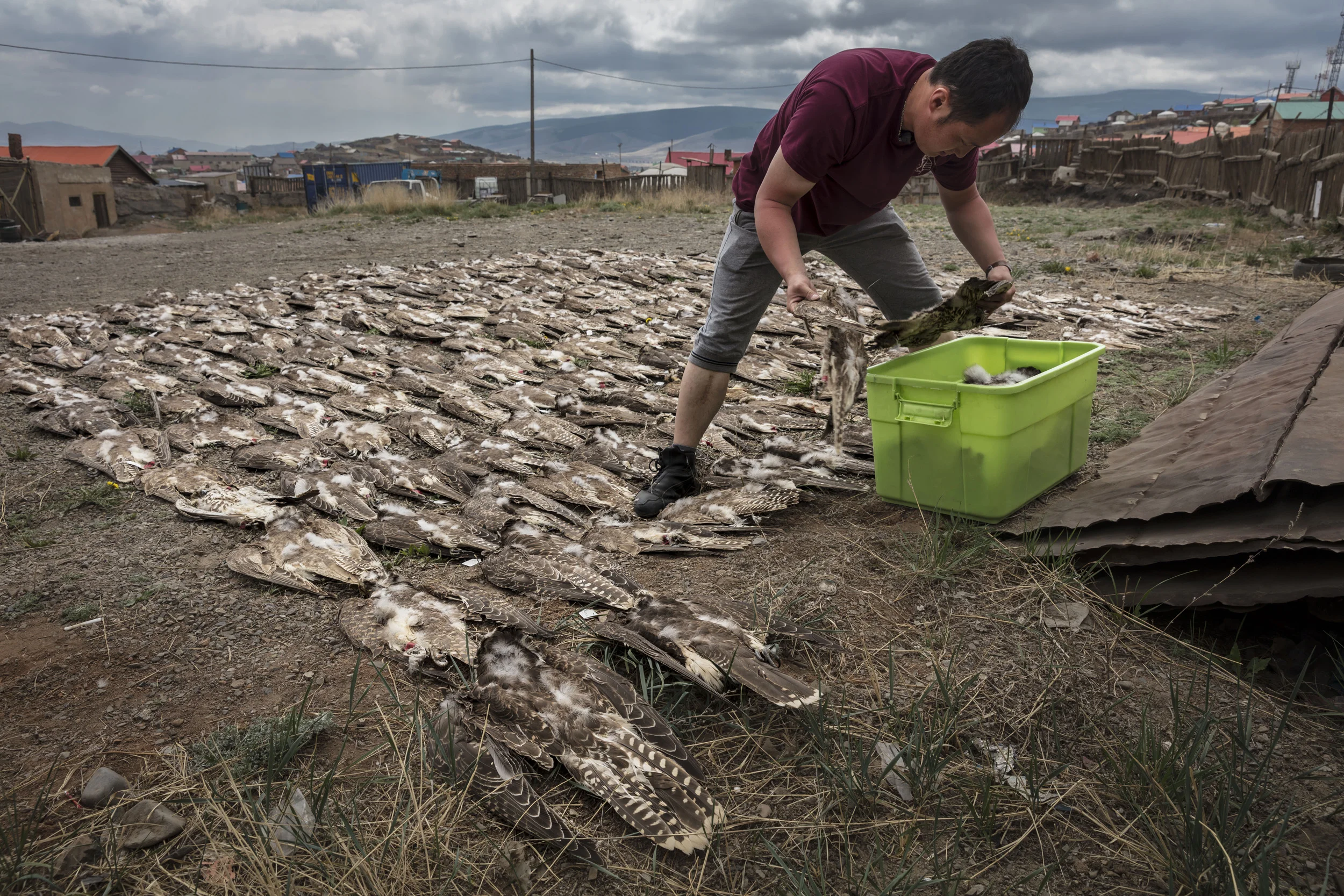
ULAANBAATAR, MONGOLIA, 27 MAY 2017: An image of over 280 Saker falcons electrocuted on powerlines covering only a small 55 kilometer study area. These falcons were collected in a study conducted over one year by Mongolia's Wildlife Science and Conservation Center, Batbayar Bold, one of their biologists is seen laying out the falcons. There are over 4000 kilometers of powerlines in Mongolia, estimated to have killed over 5,000 Saker's alone in the last 5 years. Powerlines globally kill millions of raptors every year, this is due to a design defect which electrocutes birds when they touch the live wires. Mongolia's Wildlife Science and Conservation institute is attempting to convince power companies and government to implement design changes in an effort to curb the killing. Mongolia's government sells falcons to the Arabs of the UAE, long time falconer's for whom falconing is the sport of kings. The UAE helps to fund the research on powerlines and artificial nesting in Mongolia. (Photo by Brent Stirton/Verbatim for National Geographic Magazine.)

DUBAI, UAE, OCTOBER , 2017: Scenes from Dubai Falcon Hospital, the private facility of Sheikh Hamdan bin Rashid Al Maktoum, the deputy ruler of Dubai. This is the oldest falcon hospital in the world and is used by Sheikh Hamdan and his family and associates. The higher echelons of the UAE falconers literally spend millions of dollars on housing, training and caring for their falcons. There are a number of falcon hospitals across the UAE that cater exclusively to the welfare of these birds. Expert international veterinarians staff these hospitals and birds are cared for at the same level as people. These scenes depict falcons being x-rayed, given endoscopies to ensure there are no internal problems and having their throats checked to ensure none of the common diseases may be present. (Photo by Brent Stirton/Verbatim for National Geographic Magazine.)

Democratic Republic of Congo, Bukavu: Virunga National Park pilot Anthony Caere flies two rescued baby chimps to Lwiro Primates Rehabilitation center. These babies are survivors of the illegal bushmeat trade and were rescued by conservation forces. Their mothers were killed and eaten by hunters who tried to sell the babies as pets. Once at the center, the babies will be cared for like human children by keepers in a house, easing their trauma and preparing them to join the other rescued chimps in the santuary. (Photo by Brent Stirton/Getty Images.)

LWIRO, EASTERN DEMOCRATIC REPUBLIC OF CONGO, 22 NOVEMBER 2019: One of the caregivers at Lwiro Chimpanzee rescue center and sanctuary is seen with two recently rescued baby chimps who are recovering after being anesthatized for their comprehensive health check. Both of these young chimps live in the house and are raised like children until they can be released into the large sanctuary cages with the other chimps. These chimps are all rescues and come from the bushmeat trade in DRC after their mothers were killed for bushmeat. The babies are often taken for sale and sometimes for pets. As a result many of these chimps have lived lives of isolation, suffering and cruelty. The sanctuary is a place where they can learn to be chimps for the first time and interact with other chimps. They were brought to the sanctuary after being rescued either by the Congolese Conservation authority or the Lwiro staff. (Photo by Brent Stirton/Getty Images for National Geographic Magazine.)

LWIRO, EASTERN DEMOCRATIC REPUBLIC OF CONGO, 25 NOVEMBER 2019: Itsazo, the director at the Lwiro Chimpanzee rescue and sanctuary center, introduce two new rescued baby chimps into the juvenile enclosure at the center. Itsazo is careful to introduce the new babies slowly, seperating the large juveniles first and slowly allowing the group to meet the two new arrivals. They will be closely monitored by the keepers who live with the juvenile and baby chimps 24/7 in their enclosure and at night in their night dormitory. These chimps are all rescues and come from the bushmeat trade in DRC after their mothers were killed for bushmeat. The babies are often taken for sale and sometimes for pets. As a result many of these chimps have lived lives of isolation, suffering and cruelty. The sanctuary is a place where they can learn to be chimps for the first time and interact with other chimps. They were brought to the sanctuary after being rescued either by the Congolese Conservation authority or the Lwiro staff. (Photo by Brent Stirton/Getty Images for National Geographic Magazine.)
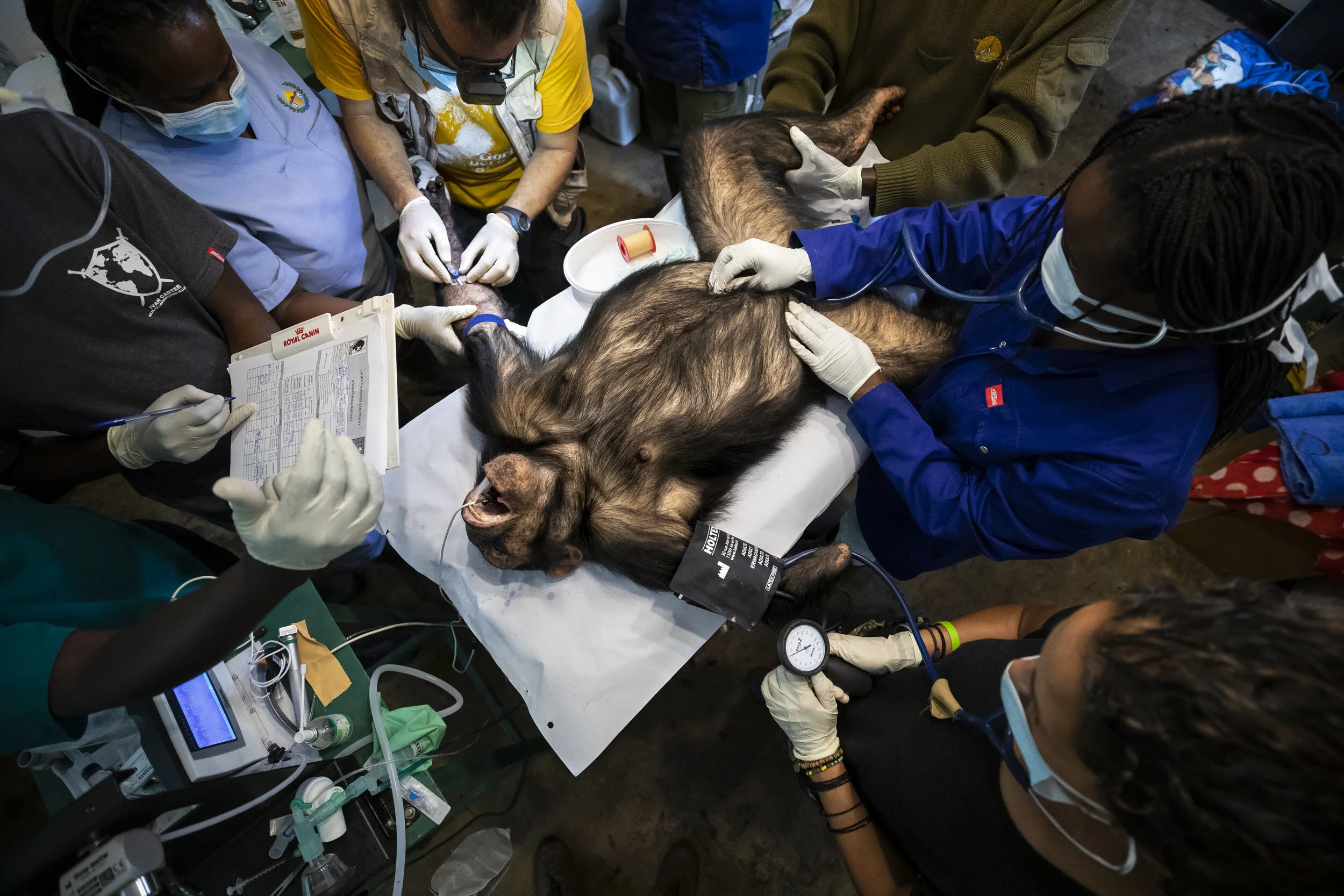
LWIRO, EASTERN DEMOCRATIC REPUBLIC OF CONGO, 22 NOVEMBER 2019: Itsaso Velez Del Burgo is seen with Luis Flores, a veterinarian for Gorilla Doctors and vets rom the Jane Goodall institute who are learning from Luis. They are performing health checks on Chimpanzees that have been rescued and are now in quarantine at Lwiro Chimpanzee rescue center and sanctuary. Itsazo is the director of Lwiro Chimpanzee rescue center and sanctuary. All 93 chimps at Lwiro are rescues and come from the bushmeat trade in DRC after their mothers were killed for bushmeat. The babies are often taken for sale and sometimes for pets. As a result, many of these chimps have lived lives of isolation, suffering and cruelty. The sanctuary is a place where they can learn to be chimps for the first time and interact with other chimps. They were brought to the sanctuary after being rescued either by the Congolese Conservation authority or the Lwiro staff. (Photo by Brent Stirton/Getty Images for National Geographic Magazine.)

LWIRO, EASTERN DEMOCRATIC REPUBLIC OF CONGO, 26 NOVEMBER 2019: Nina Nturubika, 35, in green scrubs, is a Congolese vet working with the Lwiro Chimpanzee rescue center and sanctuary. Flores, in blue, is a recently employed care-giver who is learning to care for traumatized baby chimps that have been rescued. Lina has been with the center since 2014. While not practising her vetenary skills, she is seen looking after recent rescue, Mubaki, who’s name means suffering in Swahili. Mubaki was very close to death when he arrived at the sanctuary, having experienced great trauma and mistreatment at the hand of bushmeat poachers who killed his mother and wanted to sell him. Lina studied in Goma in South Kivu and was wounded in a grenade attack by M23 rebels while she was there. She recovered and is now doing the work she dreamed of. She is very tired however, looking after a baby chimp is a 24 hour experience as they require a similar amount of care to a human baby. (Photo by Brent Stirton/Getty Images for National Geographic Magazine.)

LWIRO, EASTERN DEMOCRATIC REPUBLIC OF CONGO, 25 NOVEMBER 2019: Itsazo, the director at the Lwiro Chimpanzee rescue and sanctuary center, introduce two new rescued baby chimps into the juvenile enclosure at the center. Itsazo is careful to introduce the new babies slowly, seperating the large juveniles first and slowly allowing the group to meet the two new arrivals. They will be closely monitored by the keepers who live with the juvenile and baby chimps 24/7 in their enclosure and at night in their night dormitory. These chimps are all rescues and come from the bushmeat trade in DRC after their mothers were killed for bushmeat. The babies are often taken for sale and sometimes for pets. As a result many of these chimps have lived lives of isolation, suffering and cruelty. The sanctuary is a place where they can learn to be chimps for the first time and interact with other chimps. They were brought to the sanctuary after being rescued either by the Congolese Conservation authority or the Lwiro staff. (Photo by Brent Stirton/Getty Images for National Geographic Magazine.)

CAMEROON, 12 AUGUST 2018: A young woman who works as a street food trader in a small town 60 miles from Yaonde is seen with a juvenile pangolin which she has purchased from a middleman for $14 who got the pangolin from bushmeat hunters. She is seen with the pangolin at her stall shortly after acquiring the live animal. She then took the animal home and slaughtered it, removing the scales and disecting the body. She says she has been selling scaels for about a year but has been selling pangolin meat for at least 10 years. She adds that it is becoming rarer to find and more expensive. At this time, this is still a legal practise in Cameroon. (Photo by Brent Stirton/Getty Images for National Geographic Magazine.)

YAONDE, CAMEROON, 8 AUGUST 2018: Four juvenile pangolins for sale in a bushmeat market in Yaonde, Cameroon. Although officially listed as endangered, pangolins are still heavily traded on the bushmeat market in Cameroon, one of the very few countries in the world where they are still relatively easy to find. The scales, highly prized in Asia for traditional medicine, are often kept after consumption and Cameroonian middlemen purchase those for Chinese clients who most often fly them out of the country via corrupt officials and eco guards. (Photo by Brent Stirton/Getty Images for National Geographic Magazine.)

DOUALA, CAMEROON, 18 AUGUST 2018: Members of the Ministry of Wildlife, undercover Police and undercover members of LAGA, a wildlife law enforcement agency capture a group of 5 men who tried to sell one thousand kilograms of giant pangolin scales to an undercover agent of LAGA. These are some of the most endangered Pangolins in the world. A price of $100,000.00 was negotiated for the scales before the bust. The traffickers include men from both Cameroon and Central African Republic and another Nigerian remains at large. (Photo by Brent Stirton/Getty Images for National Geographic Magazine.)

COTE D’IVOIRE, 28 AUGUST 2018: 3,600kgs of Pangolin scales in the car park of the offices of the Ivorian Unit for Trans National crime. The wildlife NGO Eagle worked in co-operation with this new unit to capture an Ivorian Trafficker and his 3 accomplices in a 3 ton sale of pangolin scales. They recently also arrested a Vietnamese trafficker who was caught with 23 ivory tusks from rare Forest Elephant as well as 600 kgs of Pangolin scales. Together this seizure represents a conservative estimate of over 11,000 pangolins. The Ivorian trafficker received one year of jail time and is out again as of the 1st of August, the Vietnamese man is still inside. He speaks very little French and his phone was full of illegal wildlife trade items. He says he is only in Ivory coast for this trade. Abidjan has a substantial Vietnamese population. The house where he was arrested also contained weapons and drugs belonging to a Chinese man, he was also implicated in human trafficking of Ivorian women to China. (Photo by Brent Stirton/Getty Images for National Geographic Magazine.)

PU MAT NATIONAL PARK, VIETNAM, 11 NOVEMBER 2018: Members of Vietnam’s first Anti-poaching team and NGO Saving Vietnam’s Wildlife walk upriver and release 25 rescued pangolins into this remote National Park. They first feed the pangolin with ant eggs and make sure they are hydrated. They then gently carry the pangolins into a secure zone and release them back into the wild. In 2018 SVW released 417 Pangolins and in 2018 it will be more. (Photo by Brent Stirton/Getty Images for National Geographic magazine.)

LUMAJAN, BORNEO, 31 DECEMBER 2018: Bawr, a hunter from the Sentul Village region, approximately 3 hours east of the city of Surabaya, holds a pangolin he has brought to the city to sell to a middleman. The pangolin will either be cosumed in Surabaya and its scales used for traditional medicine or it will be trafficked into Vietnam, Laos or China where it will be worth far more. Bawr says he will bring in pangolin at least twice a week. This is illegal and pangolins are listed as Appendix 1 endangered by CITES. (Photo by Brent Stirton/Getty Images for National Geographic Magazine.)

GUANGZHOU, CHINA: A Pangolin is slaughtered and prepared for a meal in a restaurant on the outskirts of Guangzhou. The price for the meal was 1200 RMB per pound of the animals weight. This pangolin was 6 pounds and was forcefed liquids before being weighed to drive the price higher. The price of the meal was 8000 RMB in total, around $1142. We were led to this restaurant by the second taxi driver we asked, the first one also said it was no problem but the owner was not able to provide a private room. It appears that it is not difficult to access these animals in this part of china. The taxi driver who broght the photographer to this restaurant says he used to be a truck driver and has brought these animals into Guangzhou from the Vietnam/China border area before. Law enforcement is apparently more lax in border regions. He said he used to buy them for around 1800 RMB and sell them for 2800 to restaurants. The restaurant owner said she only sells them live, people don’t want to buy them frozen.
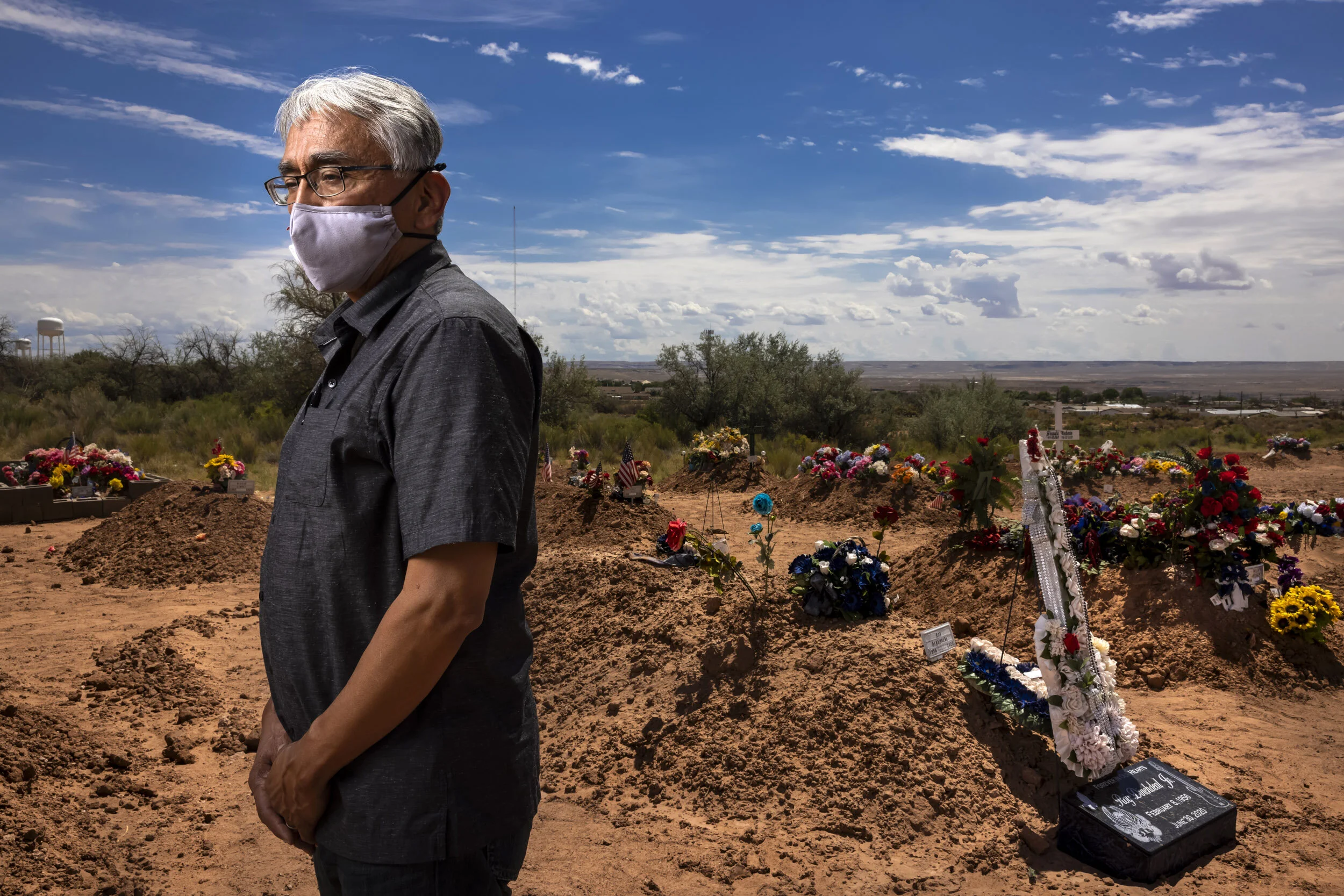
TUBA CITY, ARIZONA: Michael Begay is the director of the Valley Ridge Mortuary in Tuba City on the Navajo Reservation. He Is also the funeral director. Michael says that death toll for the last 4 months is over 370, of which at least 60% are Covid related. The normal death total for the entire year is just over 200. He is seen standing in the Covid-19 section of the Tuba City cemetery, a number of his friends are already buried here. Michael adds that many of the Navajo suffer from conditions such as diabetes which makes them that much more vulnerable. He is fearful that the hard winter will bring more suffering to his people
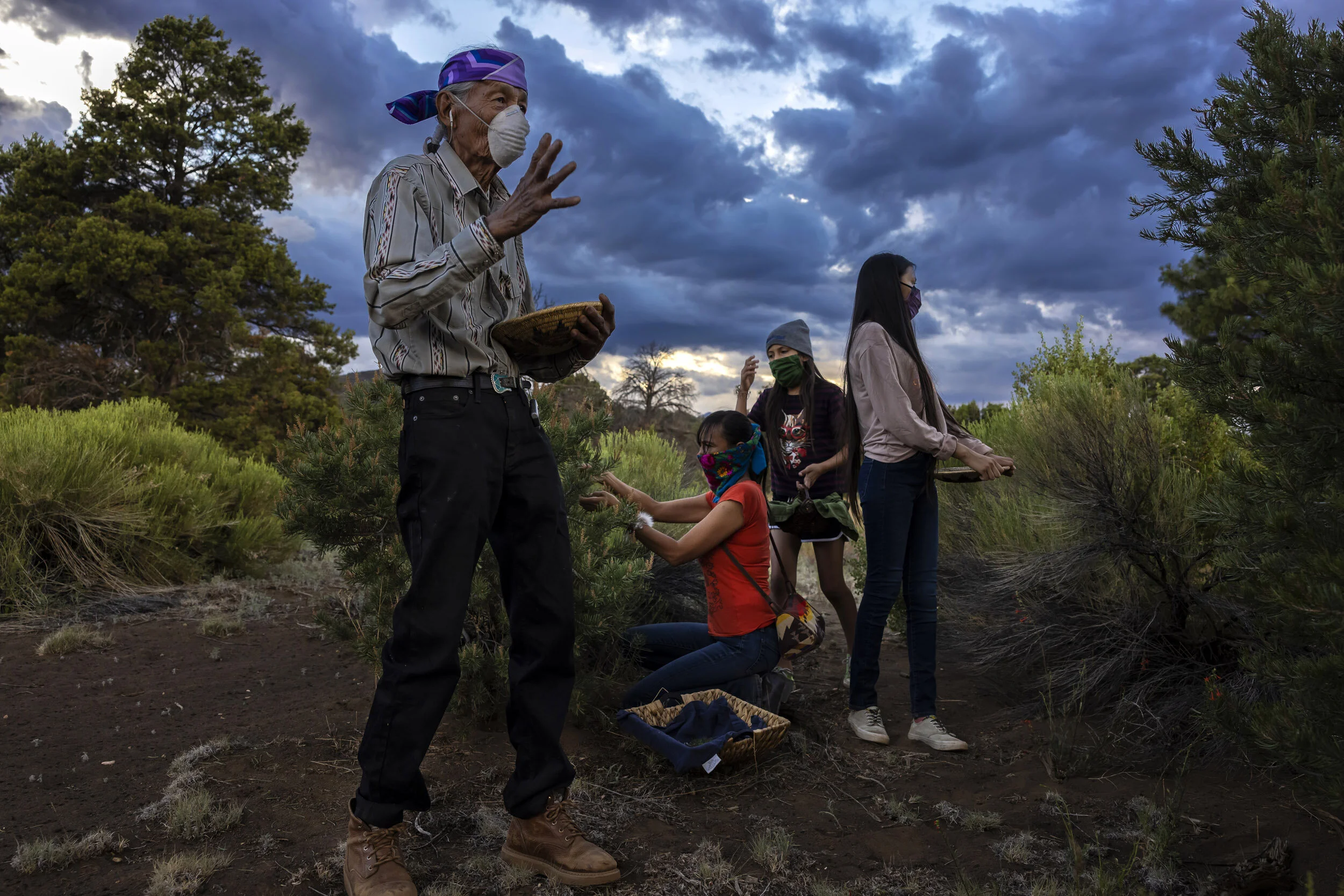
FLAGSTAFF, ARIZONA: The Benally family is well known on the Navajo reservation. The patriarch Jones Benally is a legendary medicine man, his daughter Jeneda and his son Clayson are also practitioners. They have a music band together called Sihasin, which is Navajo for “hope”. Jones and Jeneda regularly collect and prepare traditional medicine for Covid patients, utilizing techniques that derived from the ways the Navajo survived the 1918 Influenza pandemic. Jeneda and Clayson are both teaching their children the traditional life of the Navajo and ensuring their traditions are passed on.

CHINDLE, ARIZONA: Tishawna Spencer, 26 and Kieren Begay, 25, have been working with relief organization Navajo Hopi Solidarity for 4 months. This organization was formed by former attorney general of the Navajo Nation, Ethel Branch. Utilizing volunteers from Charter houses, the organization has serviced over 5000 families across the reservation and is the largest of its kind. They prioritize the elderly and the most vulnerable, utilizing people all over the reservation to delivers food to vulnerable families and has built a relationship with Airserve to get food to remote and difficult to access areas. The teams on the ground deliver food with strict safety protocols and in the last 4 months no member has contracted Covid-19.
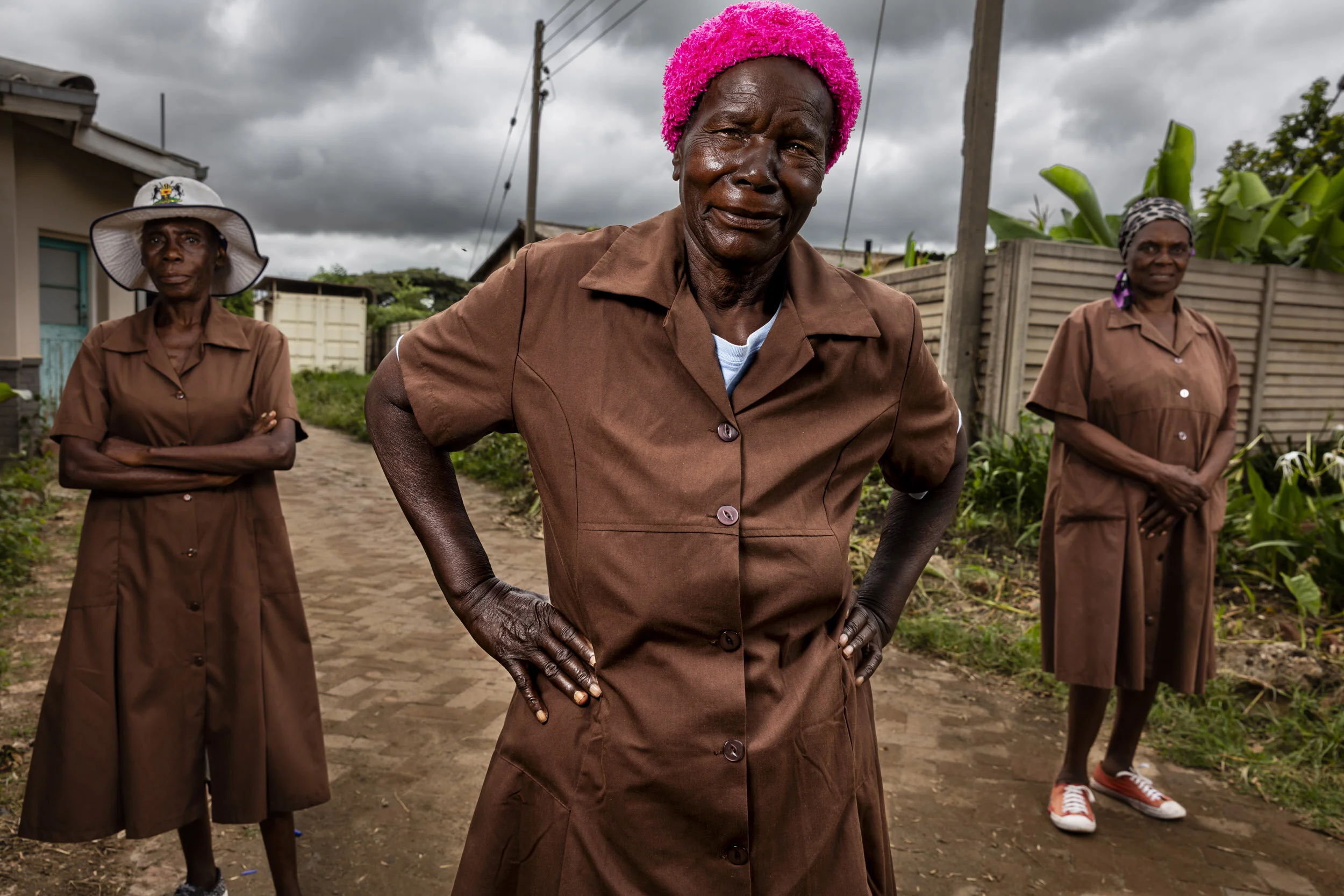
MBARE, HARARE, ZIMBABWE, 21 JANUARY 2020: Dixon Chibanda is a Zimbabwean clinical psychiatrist and the founder of the Friendship Bench program, an evidence based psychological therapy for depression delivered by over 700 trained community grandmothers on wooden park benches in over 100 communities across Zimbabwe. In a country where on average there is 1 psychiatrist for every 1.5 million people this has proven a meaningful solution for many suffering from mental health trauma. The program has now spread to 18 countries and continues to grow. I photographed the program all over Zimbabwe, a failed state with 89% unemployment, mass economic migration and a brutal regime that regulars traumatizes its citizens. Zimbabwe has one of the highest suicide rates in the world. I added previously shot images of trauma in Zimbabwe to add context to the therapy.Volunteer grandmothers for Friendship Benches are seen in at the Mbare Poly Clinic. Shelter Nhengo, 72, in the pink hat, has been working for FB since 2006, part of the original group. The grandmothers work as voluntary counsellors for those who would otherwise have no access to mental health services. The participants are taught a structured approach to identifying problems and to find workable solutions. The grandmothers follow a detailed script contained in a manual to conduct 6 sessions on a bench located in a discreet area outside the clinic. They listen and have the trust of the patients due to the cultural traditions of older woman being beacons of trust and confidentiality. The Grandmothers say that they are also benefitting, their problems gain perspective and they have a better sense of community.
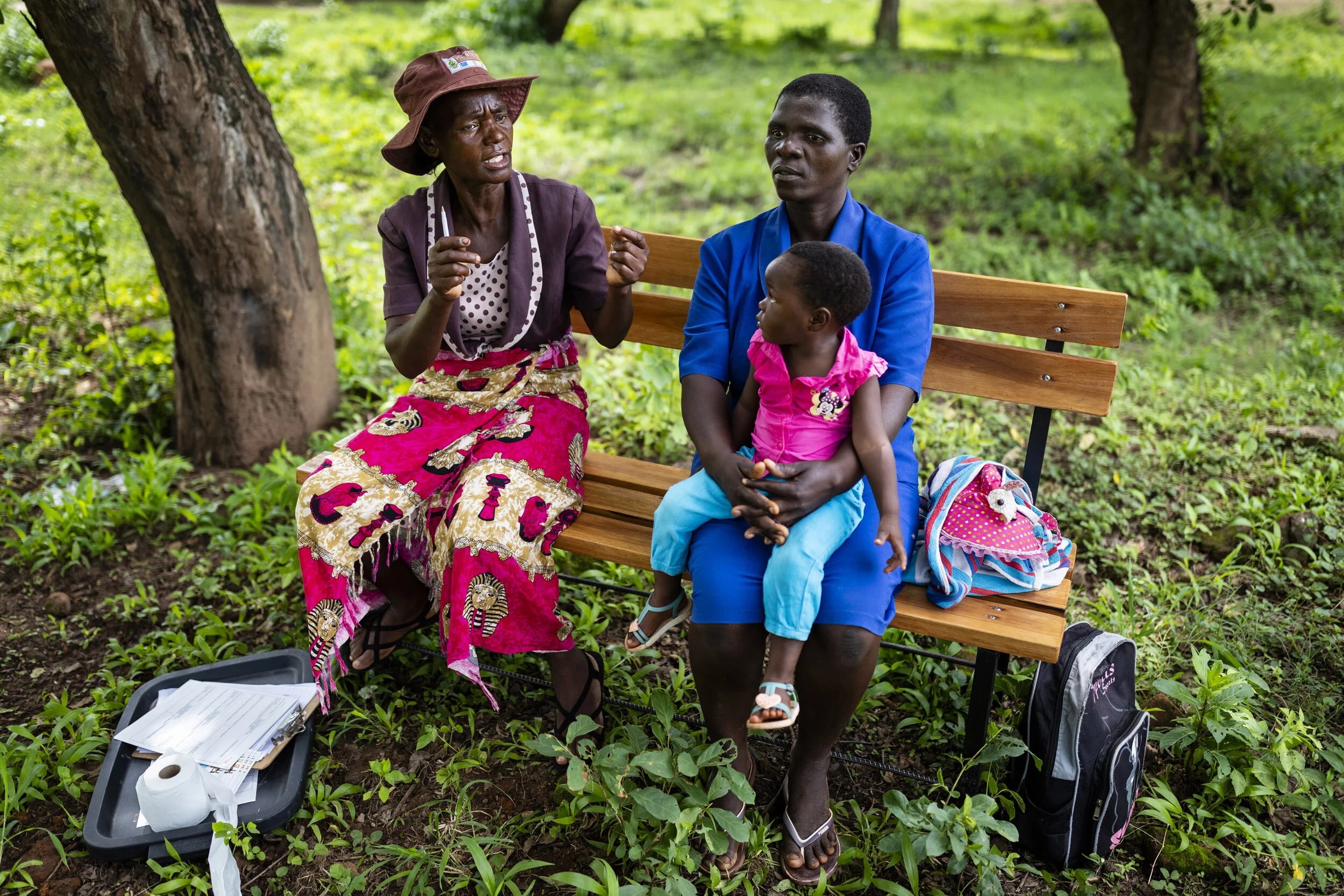
ZAKA, MSVINGO, ZIMBABWE, 24 JANUARY 2020: Elizabeth Mapaire, 56, works as a Friendship Bench counselor in the Zaka area, servicing rural clinics in the area. She is a lay health worker who is paid by the Ministry of Health but her salary is less than 2 dollars. She is seen on the bench with patient Sophia Nyamuwngi, 34, in Sophia’s first of six sessions. Sophia was quickly red flagged in this session as she expressed a desire to kill herself due to her husband’s neglect and abandonment of her and her children. Elizabeth sent her to a more experienced nurse counselor and after that visit, Sophia returned to the bench with Elizabeth. The grandmothers work as voluntary counselors for those who would otherwise have no access to mental health services. The participants are taught a structured approach to identifying problems and to find workable solutions. The grandmothers follow a detailed script contained in a manual to conduct 6 sessions on a bench located in a discreet area outside the clinic. They listen and have the trust of the patients due to the cultural traditions of older woman being beacons of trust and confidentiality. The Grandmothers say that they are also benefitting, their problems gain perspective and they have a better sense of community. This therapy of communal empathy was developed by Dixon Chibanda, Zimbabwe’s leading psychiatrist, and has spread around the world. (Photo by Brent Stirton/Getty Images

ZAKA, MSVINGO, ZIMBABWE, 23 JANUARY 2020: Grandmother and Friendship Bench counsellor Aleta Gukwa, 60, is seen with a new patient Apolonia Mekadha, 58. Friendship Benches is an NGO that offers free mental health counselling through trained grandmothers who work as lay health workers in clinics in Msvingo and Harare areas of Zimbabwe. Aleta initially identified patient Apolonia Mekadha, 58, as being a red flag case. This means a high risk of suicide. She took Apolonia to a more qualified nurse counsellor who calmed her and she returned to speak to Aleta. They live in the same village and Apolonia now has someone she can rely on for empathetic advice and a sympathetic ear. Apolonia is HIV+, unemployed and without support. She lost her home to a violent cyclone last year and her temporary shelter was destroyed by yet more rain. She is now homeless and living with her daugher and her daughter on the street. Aleta says she hears this kind of story regularly, she is paid only 44 Zimbabwe dollars every 3 months by the ministry of health. That is the equivalent of 2 US dollars. She continues her work with Friendship Benches however because she feels it makes a real difference in people’s lives. “Friendship Benches gives you as a counsellor and patient specific instructions, it can be immediately helpful with suicidal people and you can see the person getting better in your sessions with them. When my husband passed in 1990, I was depressed for a long time. Friendship Benches helped me to deal with that. I have the skills I need now. “(Photo by Brent Stirton/Getty Images for GEO magazine.)

MARANHAO, BRAZIL, JUNE 2018: Chief Antonio Wilson Guajajara from the village of Macaranduba in the Karu Indigenous Territory. He is seen being painted in traditional patterns before a patrol and also on the bank of the river flowing through his territory. This village has experienced many problems with illegal loggers and have used their settlement funds from a mining dispute to create an organized patrol of forest guardians. The women of the village have learnt to fly a drone and work together with the men to reinforce these patrols. In 2013 there was much disharmony in the village but this was successfully resolved, largely thanks to pressure from the women in the village. Those who were working with illegal loggers were expelled and from that time there has been solidarity in working towards the preservation of the forest. (Picture by Brent Stirton/Getty Images for Human Rights Watch.)

MARANHAO, BRAZIL, JUNE 2018: Scenes from the village of La Goa Comprida in Arariboia Indigenous territory. In this village illegal loggers attacked locals when the locals confiscated their logging vehicles. One indigenous man, Tomes, was killed defending his wife and a logger was also shot. Tomes is survived by 2 daughters Graca Guajajara and Jaciane Guajajara. They remain in a deeply saddened state about his killing to this day. This village has little real funding but they continue to send out forest patrols they call forest guardians. This consists of motorbike patrols when they have fuel. Arariboia is the ancestral territory of the Guajajara, it encompasses 413,000 hectares of Amazon forest. The Guajajara share this land with the Awá Guajá, who live in voluntary isolation. Arariboia is the most populated territory we visited, with visible signs of deforestation in the areas we visited. The Guajajara have been organised since 2013 to monitor their territory, they call these patrols Indigenous Environmental Inspectors (Agentes Indígenas Ambientais). Arariboia is divided in 8 regions and each region has 15 inspectors, they all answer to one General Coordinator. In turn, the General Coordinator answers to a council of village chiefs. The inspectors received some funding for several years from FUNAI for transport and food expenses, in addition to some basic training. However, the funding stopped in 2015. Guajajara inspectors have engaged in violence against the loggers they apprehend, including beatings and setting on fire their equipment. These acts of violence seem to have taken place under the supervision of Olimpo Guajajara, who was reportedly removed from his position for these incidents. The Guajajara foresee no community enforced sanctions when their own are complicit in environmental crimes. The Guajajara will often acknowledge widespread participation of their own people in environmental crimes, including three village chiefs. Guajajara environmental defe
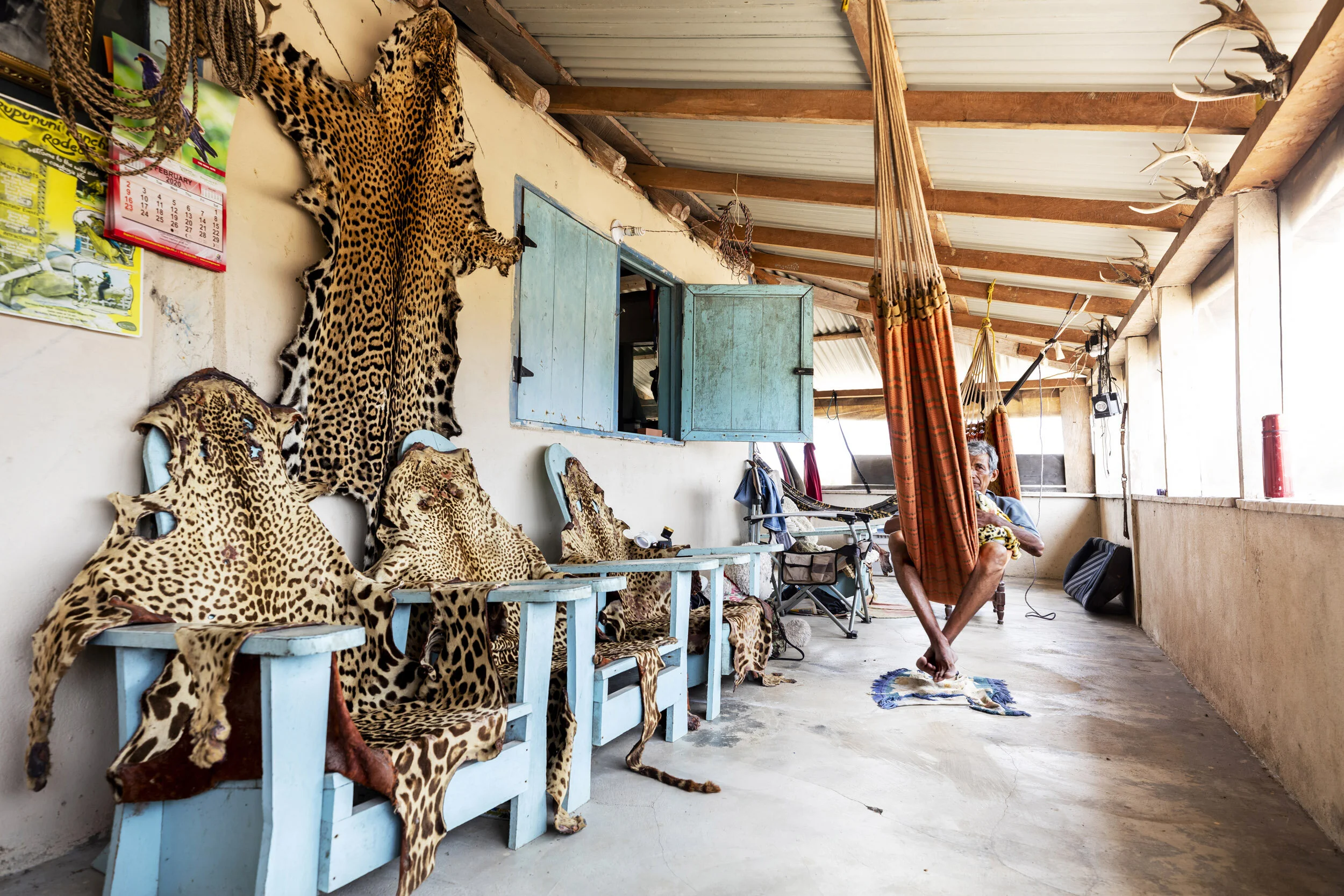
SAND CREEK, SOUTH CENTRAL, RUPUNUNI, GUYANA: Jaguar skins on the walls of a ranch house, these animals allegedly killed cattle and so were shot as problem animals by ranchers trying to protect their assets. The man in the image is a visitor and not the rancher. Ranchers argue that they often cannot get help with problem jaguars, so shooting them is the only solution. Conservationists argue that it should be possible to fence in cattle rather than let them roam wild in the jaguars territory. Fencing is expensive and illegal in indigenous areas however. It can also take time for authorities to come out to these areas and dart and relocate problem jaguars. It is a thought that those who do the shooting could be recruited to show tourists the jaguars instead and off set losses that way.

CAMERON, ARIZONA, 16 APRIL 2014: Jones Benally, a famous medicine man, dances the Navajo Hoop dance in a small canyon in the badlands of Cameron, Arizona. The hoop dance is traditionally performed at the end of a grueling nine day ceremony and is a form of storytelling dance representing various animals, symbols and storytelling elements, all representing the never ending circle of life for the Navajo. (Photo by Brent Stirton/Reportage for Le Figaro Magazine.)

CAMERON, ARIZONA, 16 APRIL 2014: Navajo Punk rock band Sihasin is seen with their horse Moonshadow in a canyon in Cameron, Arizona. Sihasin comes from a long tradition of protest music and expouses traditional Navajo values to their audience. (Photo by Brent Stirton/Reportage for Le Figaro Magazine.)

CAMERON, ARIZONA, 16 APRIL 2014: Claysun Benally with his horse in Cameron, Arizona. Claysun is a strong believer in traditional Navajo values and along with his father keeps several horses on their property in Flagstaff. The Navajo have a long relationship with the wild horse, a relationship characterized by gentleness and agreement rather than breaking the horses spirti to the will of man. (Photo by Brent Stirton/Reportage for Le Figaro Magazine.)

WINDOW ROCK, ARIZONA, 11 APRIL 2014: Senior police officer in the Navajo police Dana Dean Tome arrests a suspect on the streets of WindowRock, Arizona. This man was later found to be innocent. No alcohol is allowed on the reservation and it is one of the many obstacles faced by the understaffed, underfinanced Navajo Police. (Photo by Brent Stirton/Reportage for Le Figaro.)

TAZERZEIT, AIR MOUNTAINS, NORTHERN NIGER, APRIL 2009: Images of M.N.J, The Movement of Justice in Niger, a Tuareg led rebellion against the Niger government for reasons of perceived discrimination, social injustice and resource ownership in Niger's growing Uranium and natural resources, 5 April 2009. The rebels are depicted standing on the grounds of a former school establised for Tuareg Nomad children. It sits on the North-eastern front of the Air mountain range near the rebel main base at Mt Tamgak. The school was attacked by the Niger Army in their search for rebels in August 2007, the teacher was threatened in front of the childten and three elderly men were reportedly executed by a Niger Army captain. Shortly afterwards the rebel counter attack secured 31 Niger Army hostages, one of whom still remains in Rebel hands.

TAZERZEIT, AIR MOUNTAINS, NORTHERN NIGER, APRIL 2009: Images of M.N.J, The Movement of Justice in Niger, a Tuareg led rebellion against the Niger government for reasons of perceived discrimination, social injustice and resource ownership in Niger's growing Uranium and natural resources, 5 April 2009. The rebels are depicted standing on the grounds of a former school establised for Tuareg Nomad children. It sits on the North-eastern front of the Air mountain range near the rebel main base at Mt Tamgak. The school was attacked by the Niger Army in their search for rebels in August 2007, the teacher was threatened in front of the childten and three elderly men were reportedly executed by a Niger Army captain. Shortly afterwards the rebel counter attack secured 31 Niger Army hostages, one of whom still remains in Rebel hands.
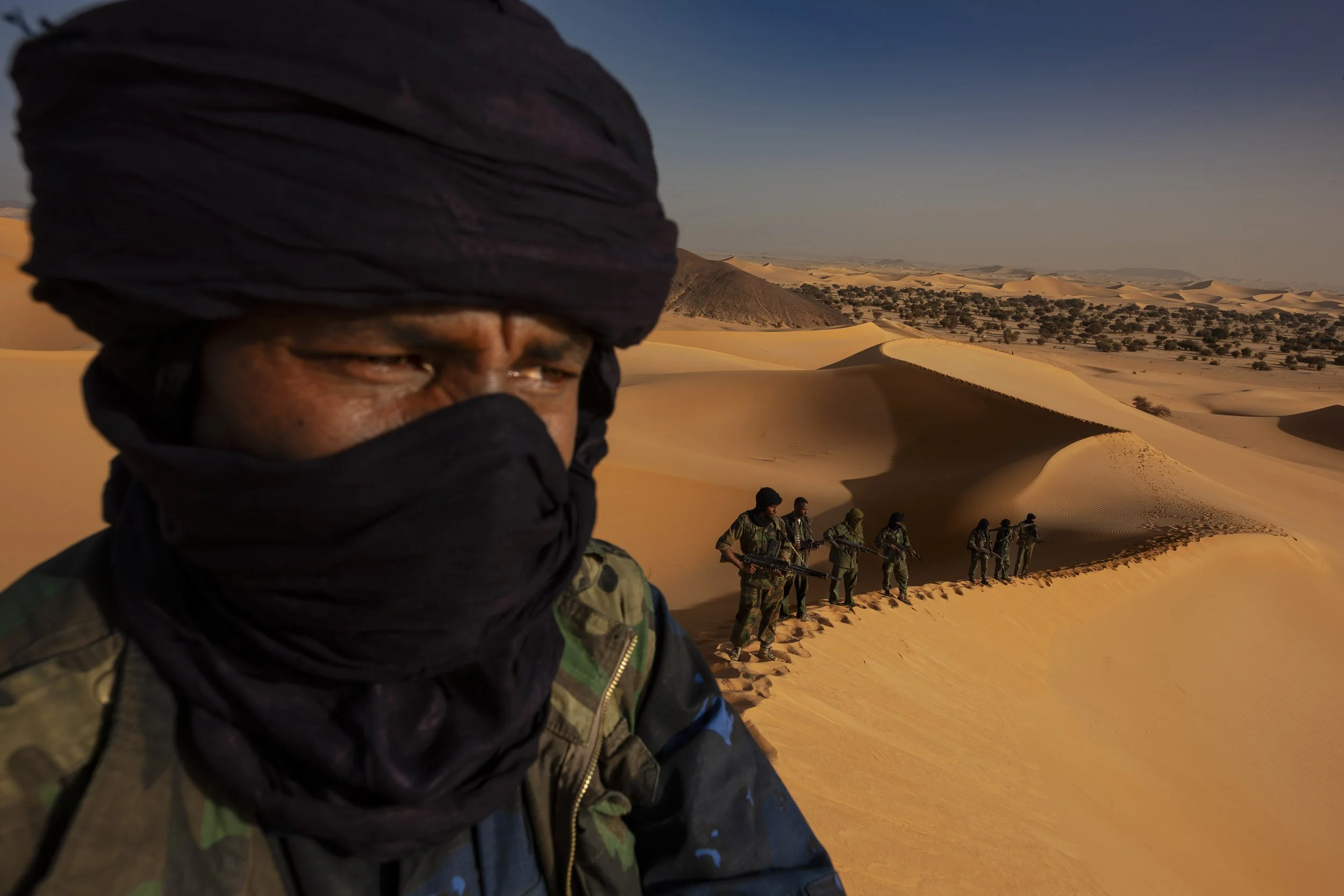
TAZERZEIT, AIR MOUNTAINS, NORTHERN NIGER, APRIL 2009: Images of M.N.J, The Movement of Justice in Niger, a Tuareg led rebellion against the Niger government for reasons of perceived discrimination, social injustice and resource ownership in Niger's growing Uranium and natural resources, 5 April 2009. The rebels are depicted in the desert on a training excercise close to a former school establised for Tuareg Nomad children. It sits on the North-eastern front of the Air mountain range near the rebel main base at Mt Tamgak. The school was attacked by the Niger Army in their search for rebels in August 2007, the teacher was threatened in front of the childten and three elderly men were reportedly executed by a Niger Army captain. Shortly afterwards the rebel counter attack secured 31 Niger Army hostages, one of whom still remains in Rebel hands. (Photo by Brent Stirton/National Geographic)

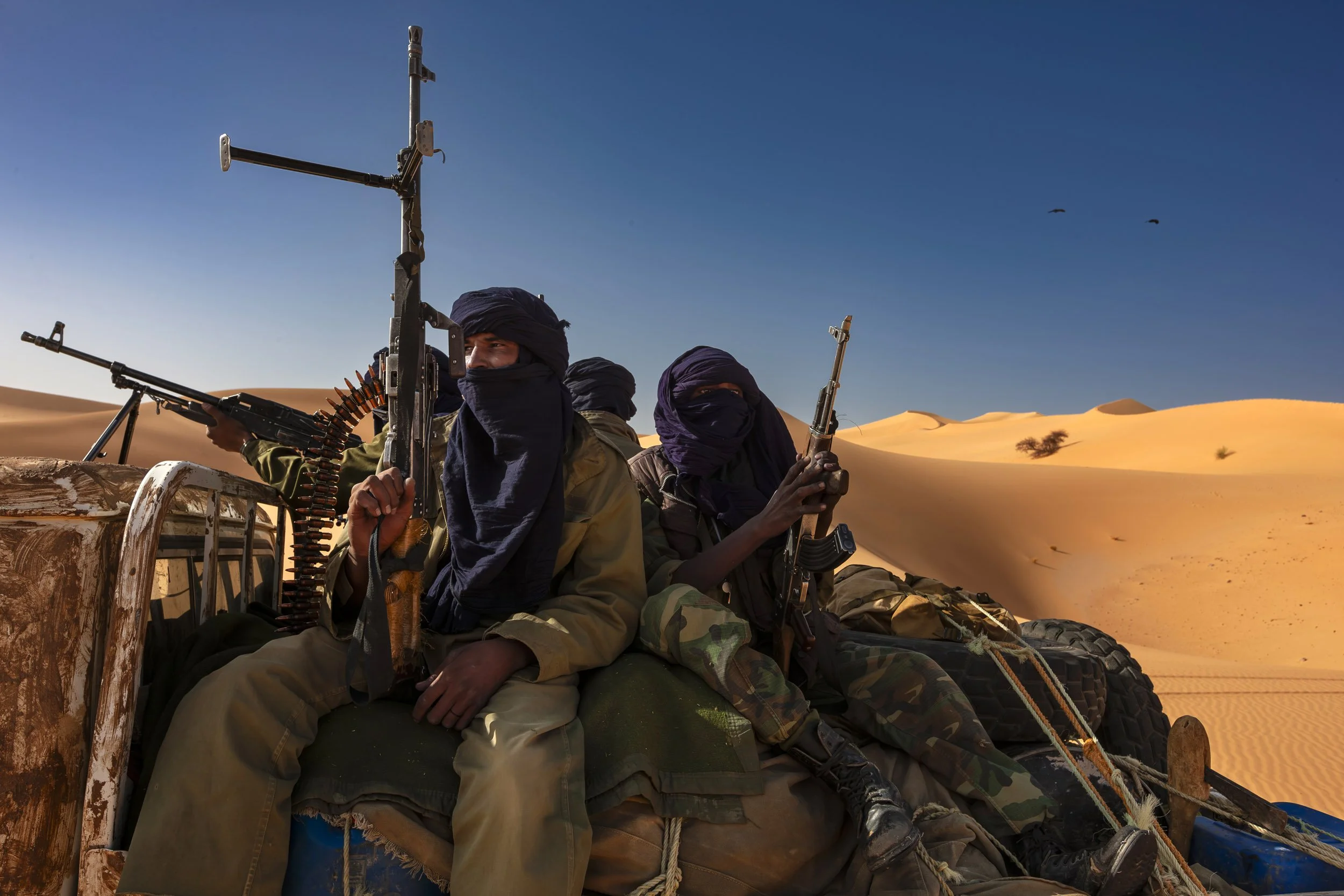
TAZERZEIT, AIR MOUNTAINS, NORTHERN NIGER, APRIL 2009: Images of M.N.J, The Movement of Justice in Niger, a Tuareg led rebellion against the Niger government for reasons of perceived discrimination, social injustice and resource ownership in Niger's growing Uranium and natural resources, 5 April 2009. The rebels are depicted in the desert on a training excercise close to a former school establised for Tuareg Nomad children. It sits on the North-eastern front of the Air mountain range near the rebel main base at Mt Tamgak. The school was attacked by the Niger Army in their search for rebels in August 2007, the teacher was threatened in front of the childten and three elderly men were reportedly executed by a Niger Army captain. Shortly afterwards the rebel counter attack secured 31 Niger Army hostages, one of whom still remains in Rebel hands. (Photo by Brent Stirton/National Geographic)

PETERSBURG, SOUTH AFRICA, 18 NOVEMBER 2016: Barend Pienaar, a self-described patriot of the Afrikaaner nation, stands amongst crosses symbolizing dead farmers killed in farm attacks litter a hillside close to the highway near Petersburg, South Africa. Pienaar is one of the people involved in creating this monument and an ardent self defence advocate for farmers. He has been called a racist for his thinking but he sees his thinking as necessary for white self-preservation. Formerly a member of right wing organizations he now sees the farmers in South Africa as going from attempted self-determination to self-preservation. Pienaar is part of a network of over 1000 community protection participants country wide and is a key figure for farm defence in his region. Official government figures say that close to 4000 white farmers have been killed since 1994 in South Africa. Agricultural and farmer organizations say that number is much higher and believe that the attacks on farmers are not only about criminal opportunism but that there is also a political motive. The number of farmers in South Africa has dwindled steadily from around 105 000 in 1994 to around 35 000 today. Farmers in these isolated areas have received very little support from the police and have formed community protection groups to try to curb these attacks. Many of the attacks are particularly brutal, with rape and torture the norm. There are also many incidents where the murderers take little; killing seems to be the motivation. There has been a steady rise in anti-white sentiment in South Africa since the death of Nelson Mandela. The Economic Freedom Front Party, a right wing black party who’s leader Julius Malema has regularly used hate speech against the white population, is publicly talking about throwing whites off their land and given it back to the blacks. This is historically inaccurate and is an attempt by Malema to mislead a naïve and ignorant black following for personal gain. Malema has on

SUNDRA, SOUTH AFRICA, 23 NOVEMBER 2016: The funeral for Kathleen Van Coppenhagen, shot dead by black attackers on her small holding in the farming town of Sundra. Kathleen was found hiding inside the dog kennel after being shot, her husband managed to escape his attackers after they shot his wife and beat him badly. Kathleen was taken to hospital but died a day later. Another white women was stabbed to death in Sundra 2 nights later. According to government, 3398 farmers have been killed in farm attacks since 1994. Farmers and agricultural organization say that number is far higher. The ANC government instructed the police to stop keeping these records as they say it was bad for investment. Right wing groups all say that officially police in South Africa have a 33/100000 chance of being killed every year. Farmers in South Africa have a 158/100000 chance making them the most vulnerable population group in the world. Since 1994 there have been 328 244 murders in South Africa, with over 80 000 whites killed. Farmers in particular have little recourse to the law and must largely protect themselves. They formed Kommando groups to do this but the ANC government banned these. Since then, farmers remain reliant on themselves and small community protection groups. On average, there is a farm attack in South Africa every second day. The vast majority of these attacks involve significant numbers of attackers and violence, torture and rape are common. These attacks have polarized South Africa further and hate speech by black right wing movements has accelerated this. (Photo by Brent Stirton/Verbatim for Le Figaro.)

ORANIA, NORTH WEST CAPE PROVINCE, SOUTH AFRICA: Niklas Kirsten, an Orania resident and former South African Army Paratrooper, teaches Erik Du Pree hand-gun self-defence in the fields outside Orania, South Africa. Orania is a privately owned South African town located along the Orange River in the Northern Cape Province. Orania is a former government workers village originally bought by a group of Afrikaners in 1991 from the South African government with the intention of creating a pure Afrikaner community which functions as a stronghold for conservative Afrikaner cultural and religious values. Orainia currently has four times more applicants than they can handle, one of the drivers for this is the farm attacks phenomenon which currently see White South African farmers as the most vulnerable population group in the world. Increasing anti-white hate speech from the black right wing is only driving this further. The Orania community sees themselves as independant from the rest of South Africa with a goal of a self-determining Afrikaner homeland. All work in Orania is done by white Afrikaners. They do not see themselves as right wing, but are very concerned with their ultra conservative cultural and religious integrity and independence. They welcome anyone who shares those values and as a result are one hundred percent white in ethnicity. THere has been a steady rise in population numbers for Orania, due to ongoing disenfranchisement of white South Africans as a result of Black Empowerment policies of the ANC government as well as undiminished, traumatically high crime statistics which are driving whites to seek shelter in perceived safer communities such as Orania. There has also been a solid increase in the numbers of professional people moving to Orania in the face of the afore mentioned drivers. Up until now there have been good relations between Orania and the SA government and in June 1998 the then Minister of Constitutional Development in the ANC governement sta
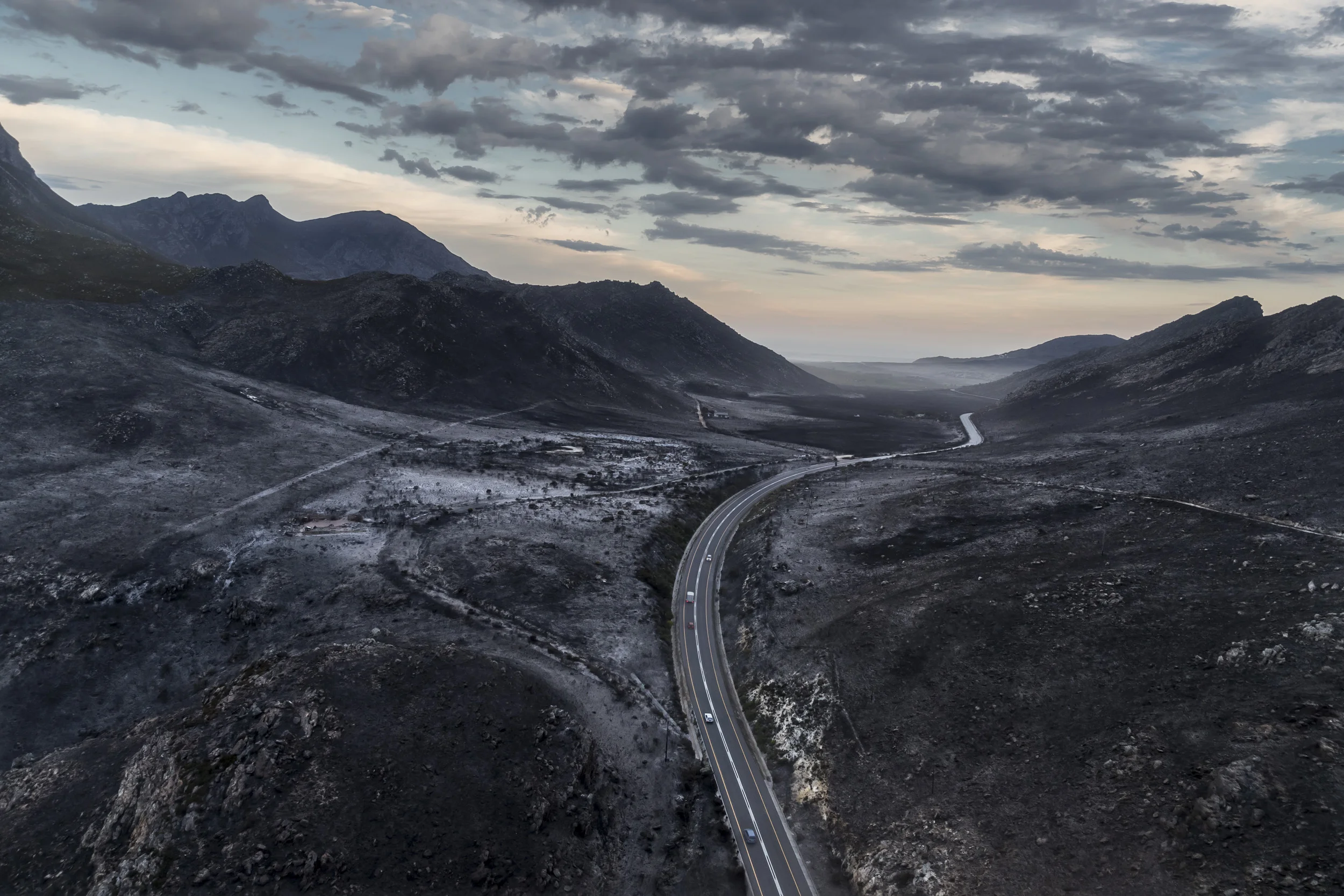
Farmlands in Eastern Cape damaged by suspected arson. Police found candles in jars and flammable material at the source of the fire.

PRETORIA, SOUTH AFRICA, 25 NOVEMBER 2016: A demonstration against farm murders by right wing groups and farmers by the statue of Afrikaner patriarch Paul Kruger. Official government statistics are censored by the ANC government but the highest figures state that 3398 farmers have been killed in farm attacks since 1994. Figures from the NGO Agriforum and the Transvaal Agricultural Unino place the number of murders just under 2000 and the number of attacks as close the 5000 since 1994. Farmers say that the numbers are far higher. The ANC government instructed the police to stop keeping these records, stating it was bad for investment. Right wing groups all say that officially police in South Africa have a 33/100000 chance of being killed every year. Farmers in South Africa have a 158/100000 chance making them the most vulnerable population group in the world. Since 1994 there have been 328 244 murders in South Africa, with over 80 000 whites killed. Farmers in particular have little recourse to the law and must largely protect themselves. They formed Kommando groups to do this but the ANC government banned these. Since then, farmers remain reliant on themselves and small community protection groups. On average, there is a farm attack in South Africa every second day. The vast majority of these attacks involve significant numbers of attackers and violence, torture and rape are common. These attacks have polarized South Africa further and hate speech by black right wing movements like the EFF has accelerated this. (Photo by Brent Stirton/Verbatim for Le Figaro.)
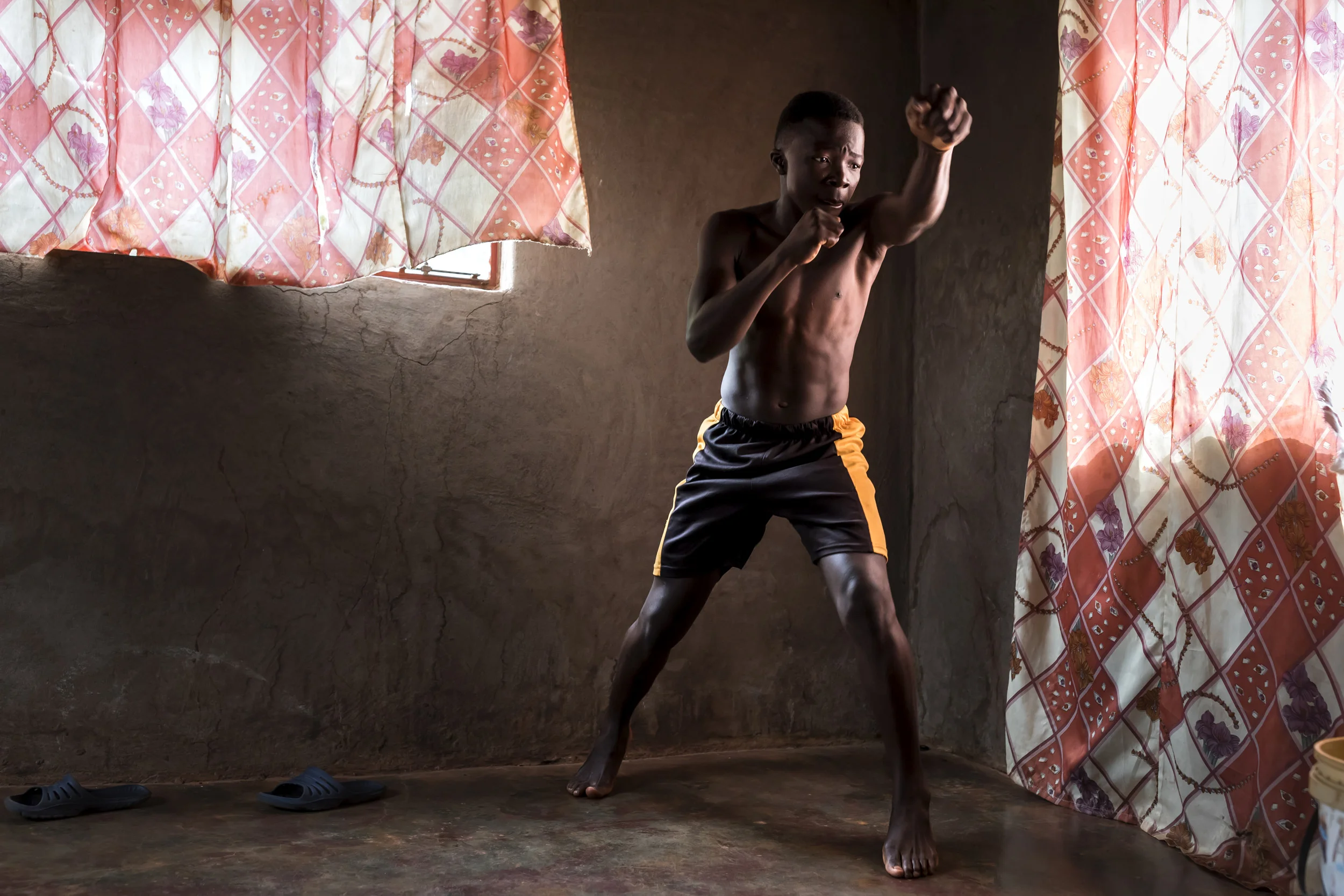
VENDA, SOUTH AFRICA, 11 DECEMBER 2016: Tshumelo “Killer” Makhado, 15, a young up and coming Musangwe fighter. Musangwe is traditional bare knuckle boxing which occurs in Venda every Xmas period. Killer is hoping to become a professional boxer but is busy with school and does not have the funds for a boxing gym in Venda. He has had 40 Musangwe bare knuckle fights and his record stands at 38-2. He is seen by the Musangwe community as a future senior champion and someone who could become a professional boxer one day. Killer is seen with trainer and Musangwe committee president, Poison, who is a teacher at a local school and long time Musangwe participant. Killer hits the punching bag the committee bought him, does shadow boxing and runs for fitness. (Photo by Brent Stirton/Verbatim for Le Figaro.)

VENDA, SOUTH AFRICA, 11 DECEMBER 2016: "Poison" Ndevana, 58, is the president of the Musangwe Comittee in Venda, he is seen training his two eldest boys Mudshidzi, 15, and Nanjana, 13. Poison says his two eldest are still too young to train seriously but he sees them as future champions. The two boys fight at every Musangwe event and are fearless of their opponents. Musangwe is traditional bare knuckle boxing which occurs in Venda every Xmas period. Poison is a former Umkhonto Wi Sizwe ANC military wing fighter but he was already a Musangwe Champion before he joined the Liberation movement. (Photo by Brent Stirton/Verbatim for Le Figaro.)

TSHIFIDI, VENDA, SOUTH AFRICA, 15 DECEMBER 2016: Men and boys of the Venda tribe challenge each other and fight bare knuckle over the festive period in South Africa. This is a tradition that dates back 200 years and began when herd boys tried to get their cattle bulls to fight with each other while they were being dipped for disease. The herd boys soon began to fight with each other and this became a tradition. The fighters may stop at any time and if a fighter starts bleeding the fight is stopped. It is seen a an outlet for the males in the community and nowadays there are champions on three different levels. (Photo by Brent Stirton/Verbatim for Le Figaro.)

SUNDARABANS, WEST BENGAL, INDIA, 8 JANUARY 2016: Mahammad Ali Molla, 60, has been blind for the last 14 years. He goes for tea every day and his grandson accompanies him on the 2 kilometer walk to the local market. He also assists him as he drinks and eats when he is not at school. Mahammad developed a problem with his eyes when tree sap entered in them while working as an agricultural labourer. He could not access eye treatment and as his eyes were neglected he developed corneal ulcers. He sought medical help from local quacks who took his money but destroyed his one eye and damaged the other with their ill-advised treatment techniques. He received further surgery from Kolkata Medical college but they could not save his remaining vision. He spent 30 000 rupees on that trip to Kolkata and it is likely most of that money went to living away from his home while undergoing treatment as well as paying unscrupulous middle men. Mahammad is supported by his wife Samiran Molla, 55, who has had to shoulder the financial burden of raising their 5 children. They survive today with meagre fishing income and by her eating with one son and Mahammad eating with the other. It is likely Mahammad's blindness could have been prevented by access to qualified eye care but his remote location and lack of local facilities as well as his state of poverty prevented access to correct treatment. This story is not uncommon in the more remote parts of India where remote communities are encumbered by a lack of quality eye care at hand and poverty makes travel and care inaccesable. (Photo by Brent Stirton/Reportage for National Geographic Magazine.)

OMARURU, NAMIBIA, 5 November 2015: Gerd Gamanab, 67, is a completely sightless man hoping for a miracle at a blindness camp in Omaruru District hospital in Namibia. He lost his sight to 50 years of farm labour in the Namibian sun and dust, which destroyed both of his corneas. This kind of blindness is the result of living in remote locations with prolonged exposure to fierce elements and no eye care anywhere nearby. A lack of education as to what was happening to his eyes also allowed this to occur. These camps are held all over Namibia and cater to sections of the population that do not receive regular eye care, mostly as a result of poverty. The applicant are screened and if the diagnosis is a mature cataract, they are selected as candidates for a simple operation which in fifteen minutes lends signicant sight to their world. The cataract is removed by a surgical vacuum and a new lens in inserted. Bandages are removed the next day and in most cases a real improvement in vision is the result. (Photo by Brent Stirton/Reportage for National Geographic Magazine.)
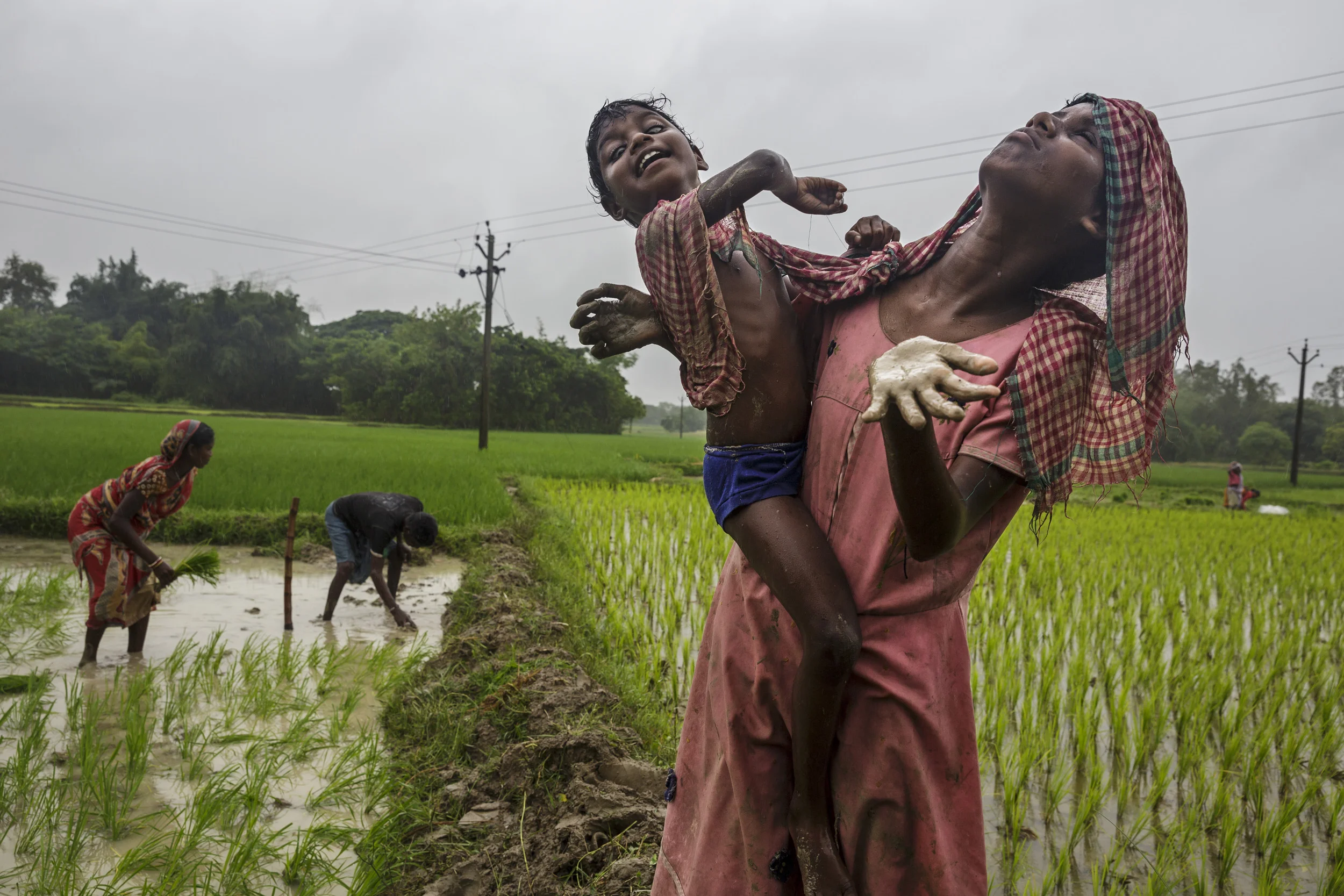
WEST BENGAL, INDIA 21 OCTOBER 2013: Blind girls Sonia, 12, and Anita Singh, 5, accompany their parents during a rainstorm while they work in the fields of their rural Indian village. Both sisters are born into poverty with congenital cataract blindness. They must accompany their parents everywhere as they cannot be left alone without risk. The surgery to cure this is simple and takes 15 minutes but because of the level of poverty in this family they have been unable to pursue the necessary operation. India has more than 12 million blind, the majority of which suffer from cataract blindness. Poverty is the main reason these millions of people are trapped in this condition. Donor funding has recently enabled both sisters to finally go for this operation. This essay is an attempt to tell the story of their lives before surgery, during the operation to regain their sight and after as they begin to discover light.
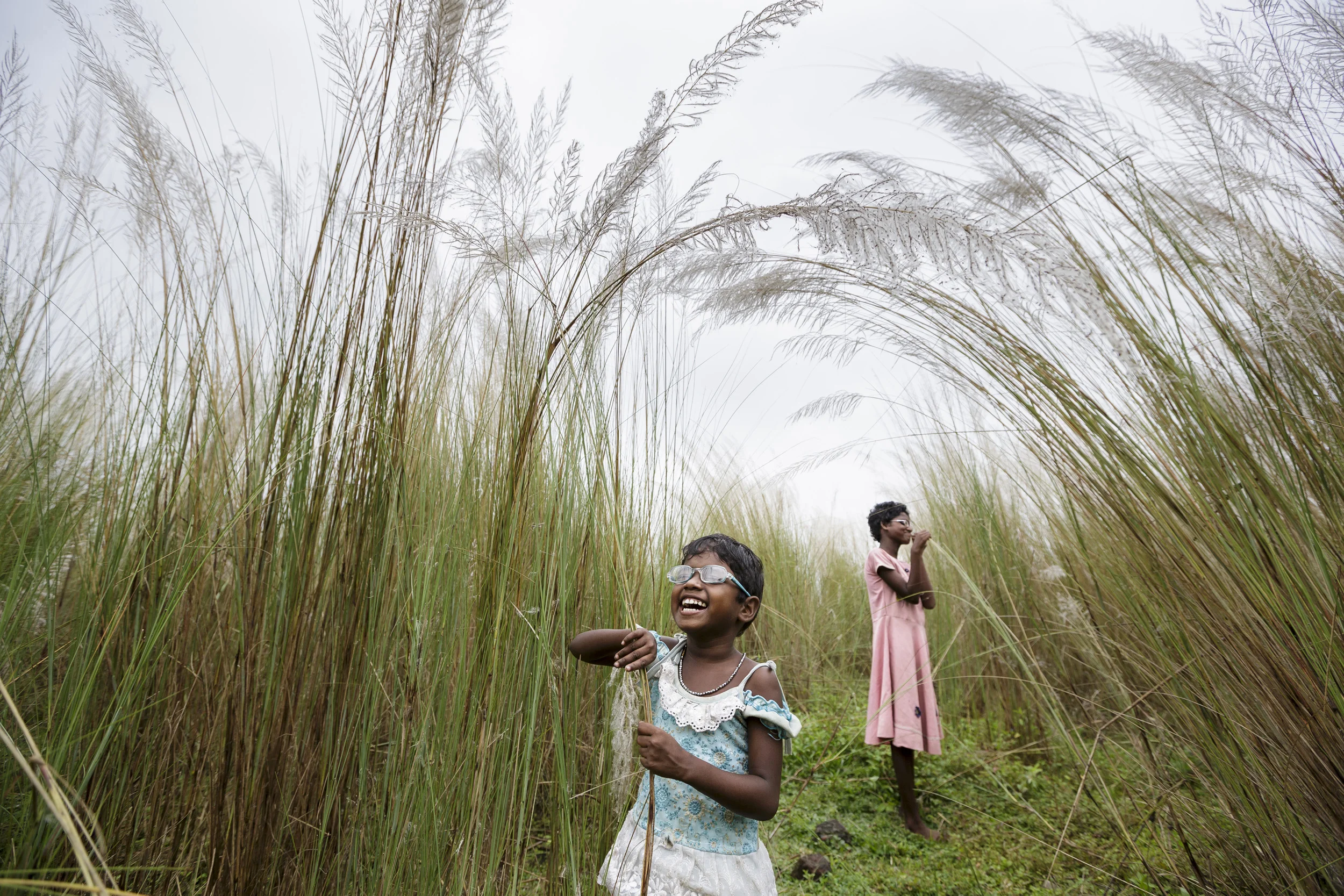
WEST BENGAL, INDIA 28 OCTOBER 2013: Anita and Sonia Singh explore the beginning of sight as they walk through bullrushes close to their village after undergoing eye surgery. Both Anita, 5, and her older sister Sonia, 12, are born into poverty with congenital cataract blindness and they will need to excercise their new eyes for at least six months before their sight approximates normal. The surgery to cure cataract blindness is simple and takes 15 minutes but because of the level of poverty in this family they have been unable to pursue the necessary operation. India has more than 12 million blind, the majority of which suffer from cataract blindness. Poverty is the main reason these millions of people are trapped in this condition. Donor funding has recently enabled both sisters to finally go for this operation. This essay is an attempt to tell the story of their lives before surgery, during the operation to regain their sight and after as they begin to discover light.


Scenes from Nelson Mandela's funeral

SOWETO, SOUTH AFRICA, 10 DECEMBER 2013: Mandela supporters wait for public transport in the rain on their way to FNB stadium for a day of comemoration for Nelson Mandela, the iconic Freedom Fighter of the ANC, Soweto, South Africa, 10 December 2013. Mandela died on the 5th of December 2013. (Photo by Brent Stirton/© 2013 Cable News Network. A Time Warner Company. All Rights Reserved.)

A young women sheds a tear as she watches Nelson Mandela's funeral in her small home in Qunu, the town where he was born and buried.

QUNU, EASTERN CAPE, SOUTH AFRICA, 14 DECEMBER 2013: Xhosa Initiates pass by close to the funeral of Nelson Mandela, Qunu, South Africa, 14 December 2014. These initiates have recently been circumsized traditionally and without anesthetic. They will spend up to two months dressed this way and learning the tradtions of Xhosa culture. Nelson Mandela, an icon of democracy, also went through this tradtional ritual. Mandela was buried at his family home in Qunu after passing away on the 5th December 2013. (Photo by Brent Stirton/Reportage by Getty Images.)


DUS, OMO VALLEY, ETHIOPIA, DECEMBER 2007: Images of the Karo people in the Omo Valley, South West Ethiopia, 14 December 2007. (Photo by Brent Stirton/Getty Images.)



LORYRA, SOUTH OMO, ETHIOPIA, DECEMBER 2007: Images of the Dassanech people in the Lower Omo Valley, South West Ethiopia, 14 December 2007. (Photo by Brent Stirton/Getty Images.)


Dominatrix and lawyer, Stephanie, seen with a man with whom she has a relationship based on his worship of her.

VARANASSI, INDIA, 2 OCTOBER 2013: Kumkum Chowdhary, 12, plays by herself on the roof of a small donor hospital in Varanassi, India. Kumkum is a victim of severe burns from a gas fire. India has one of the highest incidents of severe burns per capita yet has very few proper burns units throughout the country. Kumkum was severely burned when a naive boy in her village asked to hold a candle while he tried to transfer gas from one canister to another. He promised Kumkum a sweet if she would help him. The resultant explosion burnt her over most of her body, the boy was uninjured and ran away. Kumkum has been in this condition for more than three years with only basic medical care. Her parents are poor people and they cannot afford the necessary travel let alone medical care she requires. This hospital in Varanassi is one of the very few the poor can access. It is based on the efforts of a single doctor, a plastic surgeon who has made it his priority to serve the poor who would otherwise never be able to access this kind of surgery. Kumkum will first have her hands repaired to offer some use and then her face and body will be attended to. It will require at least a year of surgeries and recovery before she will be able to lead a normal life. This recovery is not something she would ever be able to access without the help of this unique facility.

MOGADISHU, SOMALIA, 1 AUGUST 2017: A local fisherman delivers a shark to the fish market in Mogadishu. Fishing remains a vital resource for Somalia, complicated by overfishing by illegal foreign fleets and difficult to police without a navy. Notorious Somali piracy originated with this overfishing as locals fisherman caught less and less. New development in Mogadishu and elsewhere has seen a rise in demand for fish and with potential EU aid, the Somali fishing industry could become a real economic force. (Photo by Brent Stirton/Verbatim for Time Magazine.)

KONO, SIERRA LEONE-OCTOBER 2003: A 12 year old former "bush-wife" sex-slave of the rebel group the R.U.F. This girl was taken from her village at 10 years old and forced into sexual servitude by the rebels. When she attempted to escape they used battery acid to burn off her breast as an example to the other slaves. PHOTO BY BRENT STIRTON/GETTY IMAGES.



OSAKA, JAPAN, 19 OCTOBER 2014: Sensei Fumon Tanaka, 73, Samurai master and descendent of a long line of Samurai warriors in Japan. He is seen at a temple complex in Osaka, Japan. Sensei Tanaka is somewhat controversial amongst the pursuants of the Samurai arts in that he embraces the media and has appeared in films, documentaries and commercials all showcasing his Samurai martial arts skills. This is controversial in Samurai culture as many pursuants believe in secrecy and humbleness and not in ostentatious display.

CHINGOLA, NORTHERN ZAMBIA, FEBRUARY 2002: A dying 17 year girl old succumbs to full-blown AIDS as her mother and aunt bathe her for the last time, rural Chingola, North Zambia, 8 February 2002. A lack of access to clean drinking water accelerates the decline of the immune systme for those battling HIV in rural Africa. Their compromised immune sytems are unable to handle the parasites and disease carrried in unclean water. As a result survival rates are far lower and victims die faster in these parts of the world. (Photo by Brent Stirton/Reportage by Getty Images.)

Part of an essay on teenagers dealing with mental illness in America
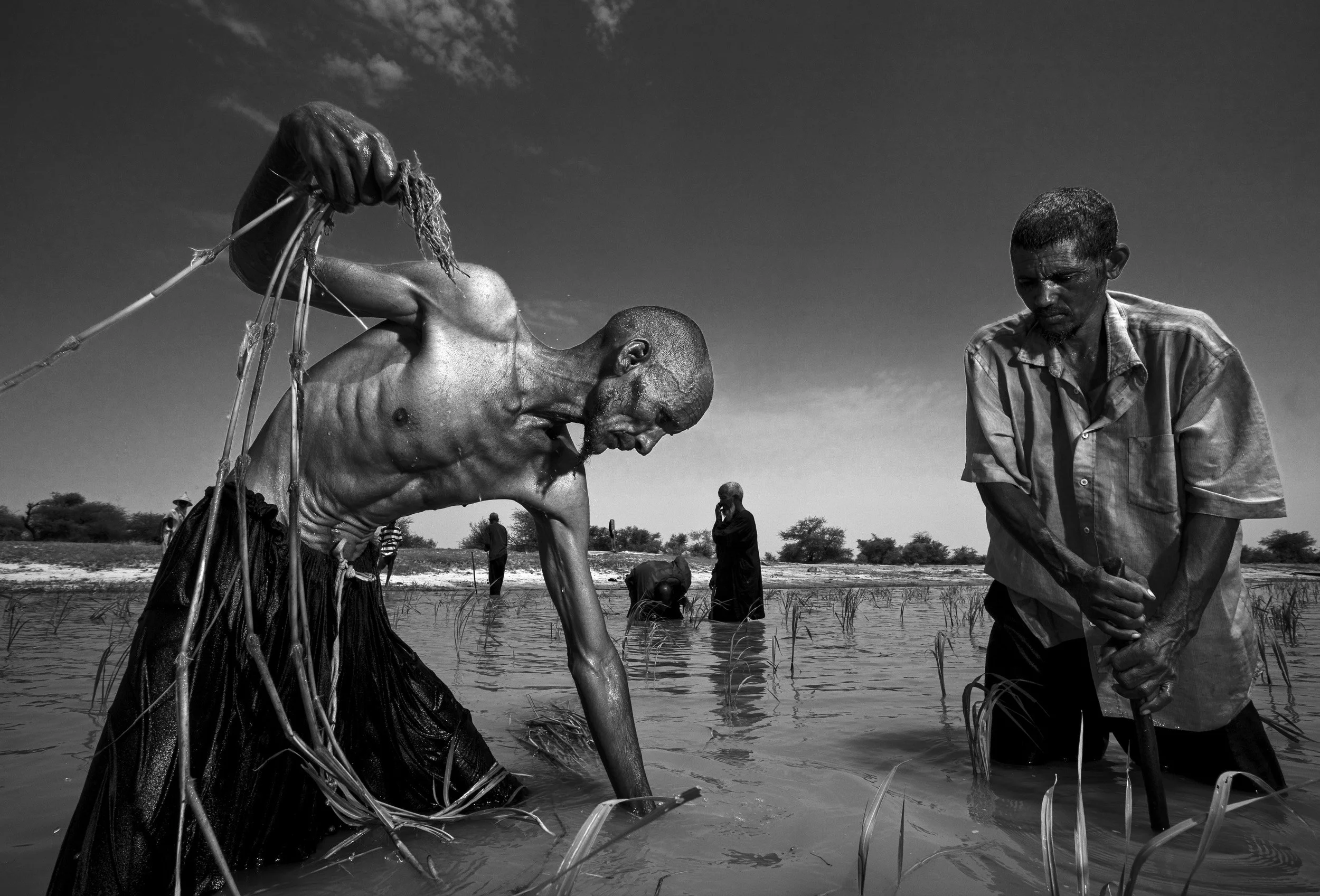
DAG ALLAL, TIMBUKTU, MALI: Tuareg men plant grass in the banks of the Niger River to grow a forage crop for their animals and for sale in the markets in the sedentary Tuareg village of Dag Allal in Mali. Unusual amongst Tuareg for their sedentary, non-nomadic existence, these Tuaregs remain in place all year and care for their animals by utilising agricultural techniques. They have received help from the Millenium Village Project which aims to empower local communities through education. They grow rice and forage grass in the nearby Niger river, using a canal and small pump to divert water into ricepaddies. Their leader, El Hadg Agali Ag Mohammoud, 70, explains that reasons of drought, rebellion and a lack of union amongst the Tuareg caused this group to choose to remain in one place, "We live here all year, we take care of our animals by growing the grass that they wouldn't normally have in the hot summer months, other Tuareg don't always understand this, they think that this grass grows naturally. We sometimes have to prevent them taking it, we have to explain that we grow it for our animals and it is not free. Sometimes there is a confrontation as a result, this is not the traditional Tuareg way so we have to explain it to them. I think in the future there will be more Tuareg living this way."(Photo by Brent Stirton/National Geographic.)

BALEKE VILLAGE, BENGAMISA DISTRICT, DEMOCRATIC REPUBLIC OF CONGO: Pastor Jerome Gendose Kayana, 57, lost his sight to river blindness in 2000. He saw numerous local traditional doctors but ultimately went blind because of a lack of access to western medicine. Jerome says he initially felt suicidal, but his faith helped him to see that this was, “God’s plan for him.” This was a very difficult period, as he had been an avid reader and had only qualified as a priest two months before he lost his sight. Nowadays he actively encourages his congregation to go to Ivermectin distributions, using himself as an example of why this is important. Pastor Jerome condemns other churches who say that this is a western practice and people should only use African medicine. Onchocerciasis, commonly known as river blindness, is a filarial disease caused by the parasitic nematode worm Onchocerca volvulus. People are infected by worms transmitted by the bite of blood-sucking blackflies, which breed in fast-flowing rivers. River blindness is not usually fatal, but it inflicts hardship and misery on millions of people. In the human body, the adult worms produce embryonic larvae (microfilariae) that migrate to the skin, eyes and other organs. The worms can cause severe itching, disfiguring skin conditions, and blindness or impaired vision. There are 217.5 million people at risk in Sub-Saharan Africa with 19 million currently infected and 1.15 million who are blind.

KISANGANI, DEMOCRATIC REPUBLIC OF CONGO: A portrait of a fisherman stretching before he lowers a large wicker fishing net into the rapids outside the city of Kisangani on the Congo River. Fisherman in this region are commonly affected by Onchocerciasis, commonly known as river blindness, is a filarial disease caused by the parasitic nematode worm Onchocerca volvulus. People are infected by worms transmitted by the bite of blood-sucking blackflies, which breed in fast-flowing rivers. River blindness is not usually fatal, but it inflicts hardship and misery on millions of people. In the human body, the adult worms produce embryonic larvae (microfilariae) that migrate to the skin, eyes and other organs. The worms can cause severe itching, disfiguring skin conditions, and blindness or impaired vision. There are 217.5 million people at risk in Sub-Saharan Africa with 19 million currently infected and 1.15 million who are blind.
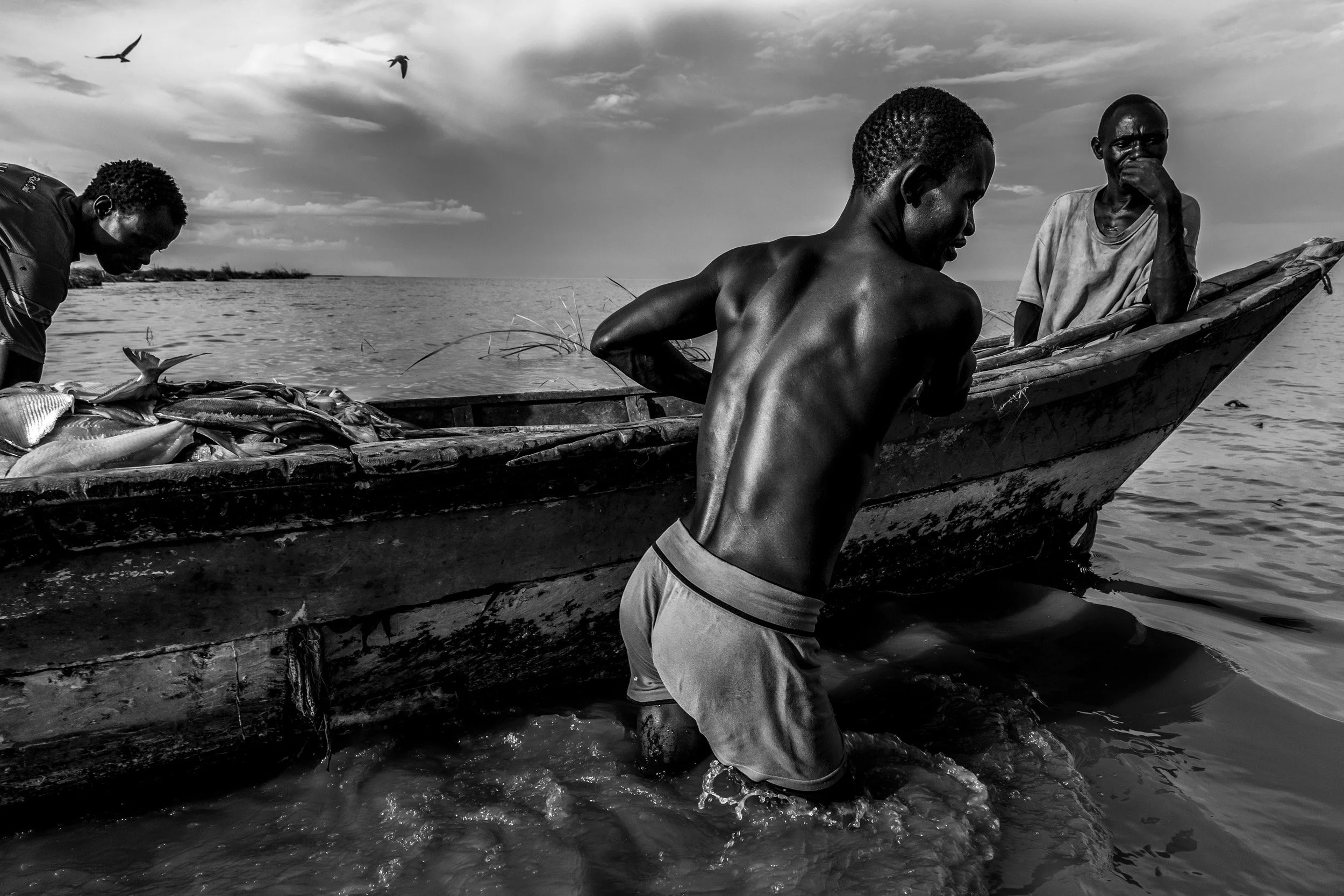
LOWARENGAK, TURKANA, KENYA: Images from an internally displaced Turkana community who have been forced off their land by Dassanech tribesman in a conflict over water and grazing rights, Turkana, Kenya. These Turkana now practise fishing as opposed to their traditional pastoralism as their main means of subsistence. The Dassenech have come illegally over the Ethiopian border into Kenya's Turkana. They were pressured by sugar cane farms on the lower Omo river which is the main tributary for Lake Turkana, the largest desert lake in the world. These sugar cane farms robbed the Dassenech of tradional grazing land and water rights and so they moved over the border into Turkana territory and ongoing conflict is the result. This pattern is increasing as Ethiopia's Gibe 3 dam is in full swing. This has reduced the flow of the Omo river to one fifth of its current size, decimating the fertile flood plain in the region and the tribesmen along the Omo now fight for diminishing resources as a result. This conflict continues in Kenya's Turkana region as all around the lake hundreds of thousands of tribespeople will find themselves competing for less and grazing, fishing and clean water sources. A series of droughts have reduced most of these pastoralists to fishing as their chief source of subsistence due to huge cattle and goat deaths. The massively reduced flow of the Omo, source of 90% of Lake Turkana's water, is having a devastating effect on this food and income source. The Ethiopian government has conducted no Environmental Impact Assessment for their dams and has yet to respond to these issues. (Photo by Brent Stirton/Reportage by Getty Images for HRW.)
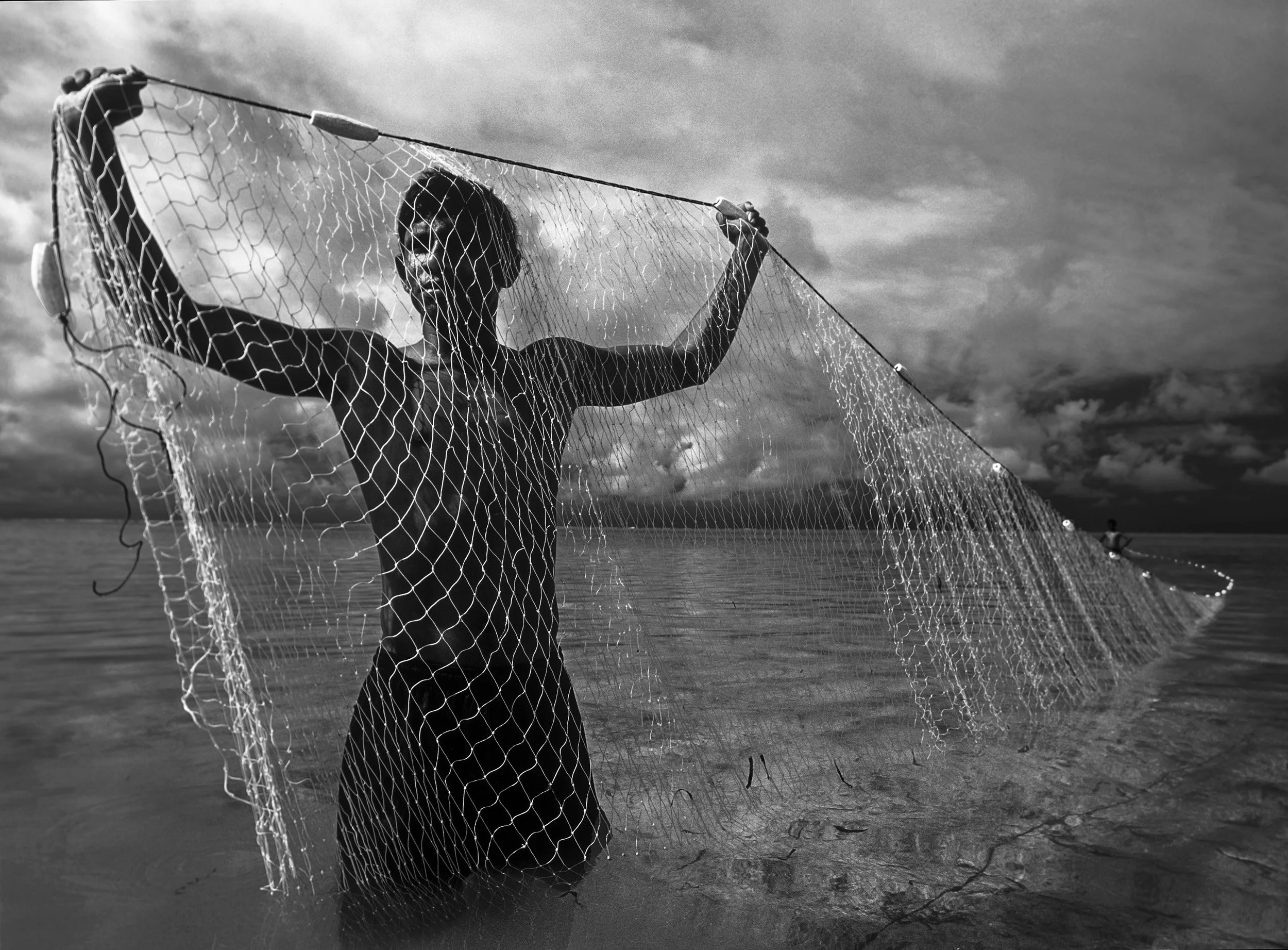
Maldives: Fishermen in the Maldives raises an empty net, they say that this used to be an abundant fishing area but global warming has killed many reefs in the Maldives and the waters now yield very little fish. This forces fisherman to travel much further to fish.

KAHAWA, SRI LANKA : The Venerable Dr. Talawe Sangharatana Thero stands in contemplation outside a train wrecked in the Asian Tsunami disaster, Kahawa, Sri Lanka. Over 800 people died in the wreck, many of whom were children. Dr Thero is one of the senior monks for the Southern district of Sri Lanka. Over 70% of Sri Lankans are active practioners of Buddhism and monks have been active in the devastated communites after the impact of the Tsunami. Many have sought shelter in their faith and the monks have offered whatever comfort and shelter they can. (Photo by Brent Stirton/Getty Images)

TETE, MOZAMBIQUE, NOVEMBER 2013: Victor Pirez, 28, performs demining operations in the Chinzunga hills close to Cabora Bassa, Mozambique, 18 November 2013. Victor has been a demined for 5 years and says that his grandfather was killed by a landmine in this same region while walking to his farm. Victor's team cleared 15 landmines on this day and detonated them as usual before they left for the day. Victor is also the paramedic for his team and carries a major trauma kit with him. Victor makes $260 a month doing this job, considered a good salary in Mozambique. The HALO deminers in this area are dealing with landmines laid in the 1970's by the Portugese military who were attempting to defend the vital Cabora Bassa Hydro-electric dam, a strategic target for the Frelimo rebels at the time. Today, over 40 years later, these mines still maim and kill the local populace and prevent them utilizing vital agricultural land. This scene was photographed at demining operations close to the HALO Demining camp in the mountains of Chinzunga. Mozambique was one of the most heavily landmined countries in the war, both from its 11 year long War of Libertation as well as its conflicts with both South Africa and Rhodesia for sheltering both the ANC and Mugabe's Zanla freedom fighters. Halo has cleared over 22,700 anti personnel mines and reclaimed of 500, 000 square meters of land for the local populace. HALO runs both mechinical and manual operations. Mozambique is pushing hard to meet its donor obligations to be land-mine free by the end of 2014, under the mandate of the Ottawa convention on the land mine.

BARRIO CHIUIJO, WEST OF CHIMOIO, MOZAMBIQUE/ZIMBABWE BORDER, 19 NOVEMBER 2013: Bonafacio Mazin, 57, works his vegetable field with perfect balance despite losing one of his legs in 1987 to a landmine laid by Rhodesian forces in the seventies, Mozambique/Zimbabwe Border, West Chimoio, 19 November 2013. Bonafacio was walking home from farm work in Zimbabwe when the incident occured. Mozambique had very few jobs at the time and many people were killed in their way in and out of Zimbabwe by these landmines. "As a man, this is very bad, I cannot find a job, I work hard on the farm but I cannot do enough work. This landmine has reduced me to a beggar." This region is one of the most densely landmined in the world, effectively cutting off 50% of all arable land for these villages. The landmines were laid by the Rhodesean Military to protect against ZANLA freedom fighters in Rhodesia's war of liberation. They have been in place since the early 1970's and Norweigan Peoples Agency have been demining the area for some time. They hope to finish by the end of 2014 but that may be optimistic given the recent discovery of new minefields and resurgent violence from opposition party RENAMO. (Photo by Brent Stirton/Reportage for the ICRC.)

MOTOLLA CITY, MAPUTO, MOZAMBIQUE, 25 NOVEMBER 2013: Double amputee Jose Sabonete,54, a former FRELIMO soldier, is seen bathing at his impoverished home in Motolla City, Maputo, Mozambique, 25 November 2013. Jose lost his legs to a fragmentation landmine while serving as a soldier in the war. He and his 5 children exist today on a $100 government pension but he receives no other help for his condition. He is seen bathing in the toilet area of his home. The amputees in this image are all a result of landmine blasts. These veterans receive a $50 pension every month from government but rely on the kindness of their extended families to survive. Most have only brokendown prosthetics in dire need of maintenance as well as crutches that are on their last legs. Most of these men were injured by landmines in their fight against RENAMO, who were eventually defeated by FRELIMO who today makes up the leading party in the Mozambique government.

MOTOLLA CITY, MAPUTO, MOZAMBIQUE, 24 NOVEMBER 2013: Jose Magleso Nalabo, 48, was blinded while soldiering for FRELIMO during Mozambique's brutal civile war, he is seen outside his squatter housing in abandoned accomodation in Motolla City, Maputo, Mozambique, 24 November 2013. Jose was blinded when the soldier in front of him trod on a fragmentation landmine, killing himself and blinding Jose. 25 families live in these accomodations, the majority are former FRELIMO fighters from the Mozambique civil war. Most of those are amputees as a result of landmine blasts. These veterans receive a $50 pension every month from government but rely on the kindness of their extended families to survive. Most have only brokendown prosthetics in dire need of maintenance as well as crutches that are on their last legs. Most of these men were injured by landmines in their fight against RENAMO, who were eventually defeated by FRELIMO who today makes up the leading party in the Mozambique government.
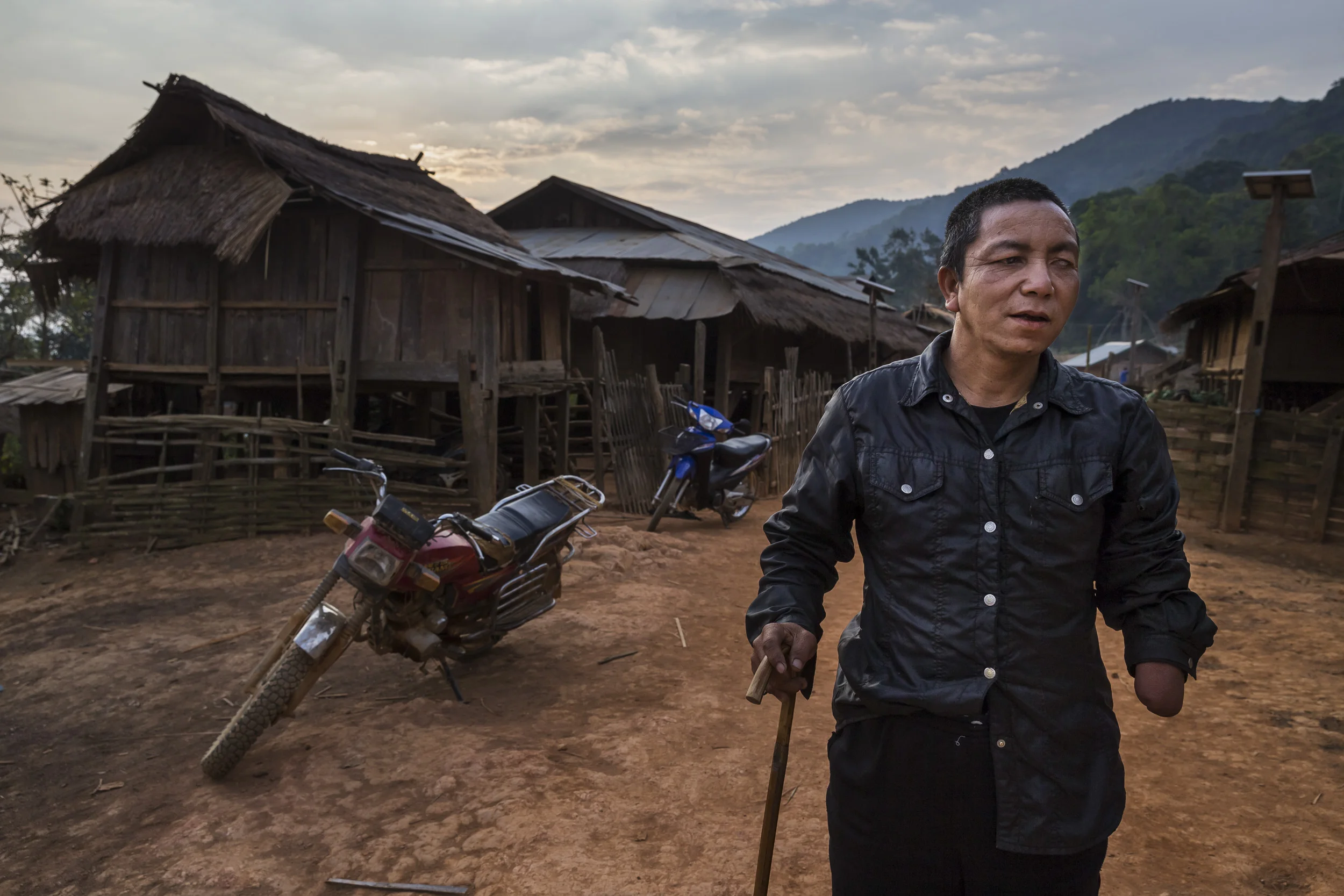

DR Congo: A young victim of a Chimpanzee attack, the chimp also killed a younger child in the attack after being cornered by villagers.

RUMANGABO, VIRUNGA, DEMOCRATIC REPUBLIC OF CONGO, 6 AUGUST 20013: Images from the Senkekwe Orphan Gorilla project as caretakers interact in the early morning with a new orphan mountain gorilla Ihirwe at ICCN headquarters, Rumangabo, DRC, 6 August 2013. It is suspected that this orphan was taken by soldiers who probably killed the mother to get the baby. When they were unable to sell it, the orphan was abandoned and the conservation rangers heard and rescued it. Wounds from a rope were evident on its chest and back, it is slowly recovering now as it lives full time with caretakers who also sleep in the enclosure with the orphan. There are a number of other orphans at the center who will be introduced to the new baby once it has been through quarantine and is accustomed to its new surroundings.
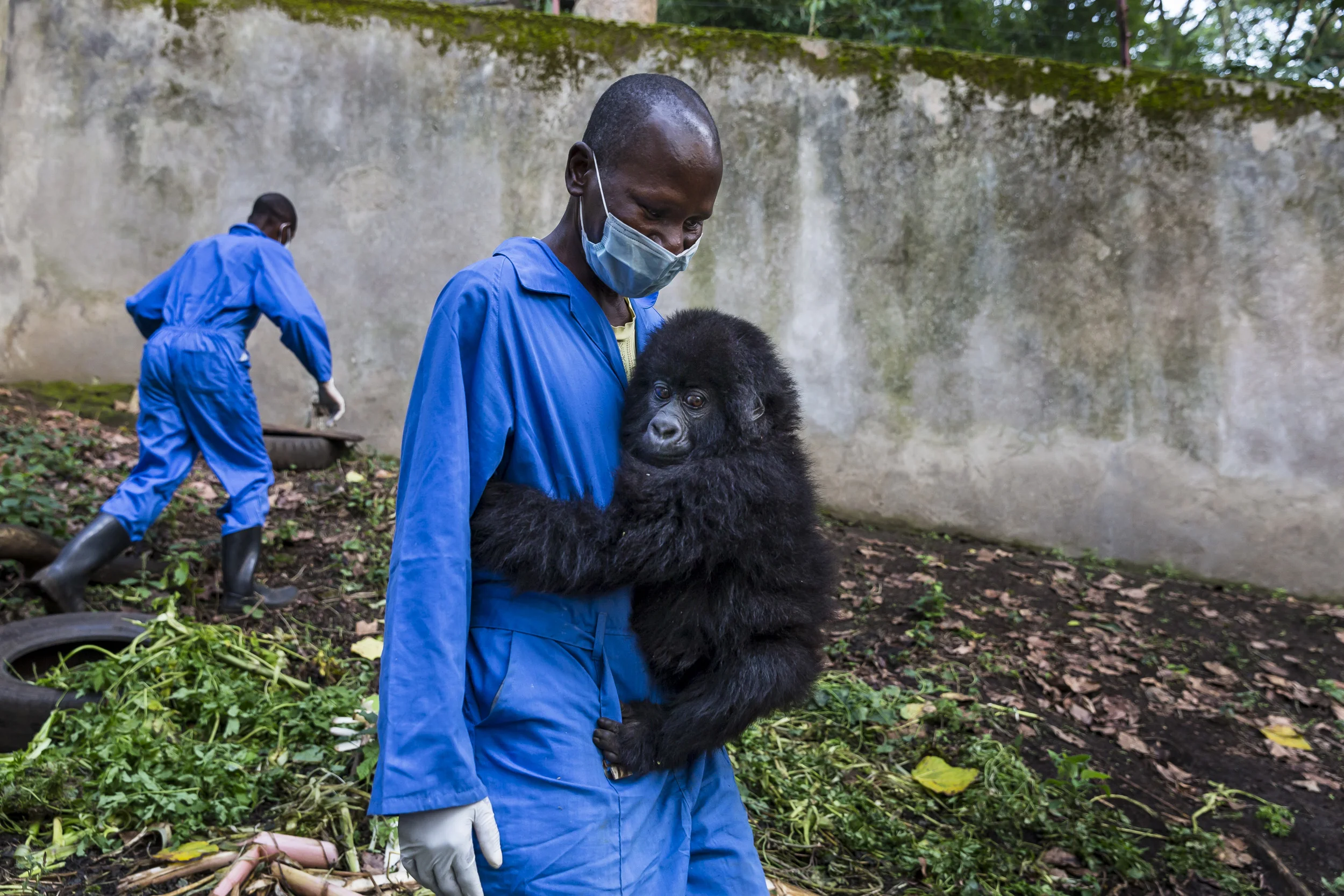
RUMANGABO, VIRUNGA, DEMOCRATIC REPUBLIC OF CONGO, 7 AUGUST 20013: New Mountan gorilla orphan Ihirwe clings to her caretaker at Senkekwe Mountain Gorilla Orphanage at ICCN headquarters, Rumangabo, DRC, 7 August 2013. It is suspected that this orphan was taken by soldiers who probably killed the mother to get the baby. When they were unable to sell it, the orphan was abandoned and the conservation rangers heard and rescued it. Wounds from a rope were evident on its chest and back, it is slowly recovering now as it lives full time with caretakers who also sleep in the enclosure with the orphan. There are a number of other orphans at the center who will be introduced to the new baby once it has been through quarantine and is accustomed to its new surroundings. (Photo by Brent Stirton/Reportage for Getty Images.)

ZAKA, ZIMBABWE, JUNE 2009: A young MDC Zimbabwe oppostion party burn victim, name withheld, sits alone in his room in a rural area of Zaka, Zimbabwe, 24 June 2009. At the conclusion of 2008's March elections in Zimbabwe where the MDC emerged the winner, two Zanu PF sponsored Zimbabwean Army soldiers appeared at the MDC offices in Zaka. The soldiers shot one MDC worker in cold blood outside the office, shot another inside the office and then locked 3 more MDC officials inside and proceeded to pour 20 litres of petrol over the building, set it alight and fled. In the resultant blaze all three men suffered third degree burns before they were able to break down the door and escape. They suffered for three days without any treatment before they could reach a facility which could treat them. Once there, doctors were forced to hide the three men as Zanu PF supporters came looking for them with the intention of finishing the job the soldiers had started. The young man in the picture, a former MDC defence and security activist, now has limited use of his hands and is blind in one eye. In a country currently at 85% unemployment he can no longer even provide manual labour in his village's rural fields. (Photo by Brent Stirton/Reportage by Getty Images.)

JOHANNESBURG, SOUTH AFRICA, JUNE 2009: Noel Mguti, 33, is a recently arrived Zimbabwean refugee living in dire poverty in Johannesburg, South Africa, 3 June 2009. He is the former organising secretary for the opposition MDC party in Midlands, Zimbabwe. Mguti was abducted and tortured by Zanu PF party youth, who broke most of his ribs and destroyed his homestead with fire on the 26 April 2008. Mguti was forced to abandon his family and flee illegally into South Africa, pursued across Zimbabwe by Zanu PF youth who were intent on killing him. Mguti, along with thousands of other Zimbabwean refugees, is entirely reliant on the very few church groups and NGO's who are trying to aid in the Zimbabwean crisis. He works unpaid as a security guard at the Central Methodist Church in Johannesburg where he sleeps. Mguti is asmathic and diabetic and must often beg for food to survive. His injuries as a result of torture combined with his health problems make it impossible for him to find work in physical labor and his illegal status means he cannot be employed in the white collar work sector. At the time of this photograph Mguti had just heard that one of his children had died of a fractured skull in Zimbabwe. Despite tremendous personal risk, Mguti was trying to raise the funds to go back and bury that child in his home district of Zimbabwe. (Photo by Brent Stirton/Reportage by Getty Images.)
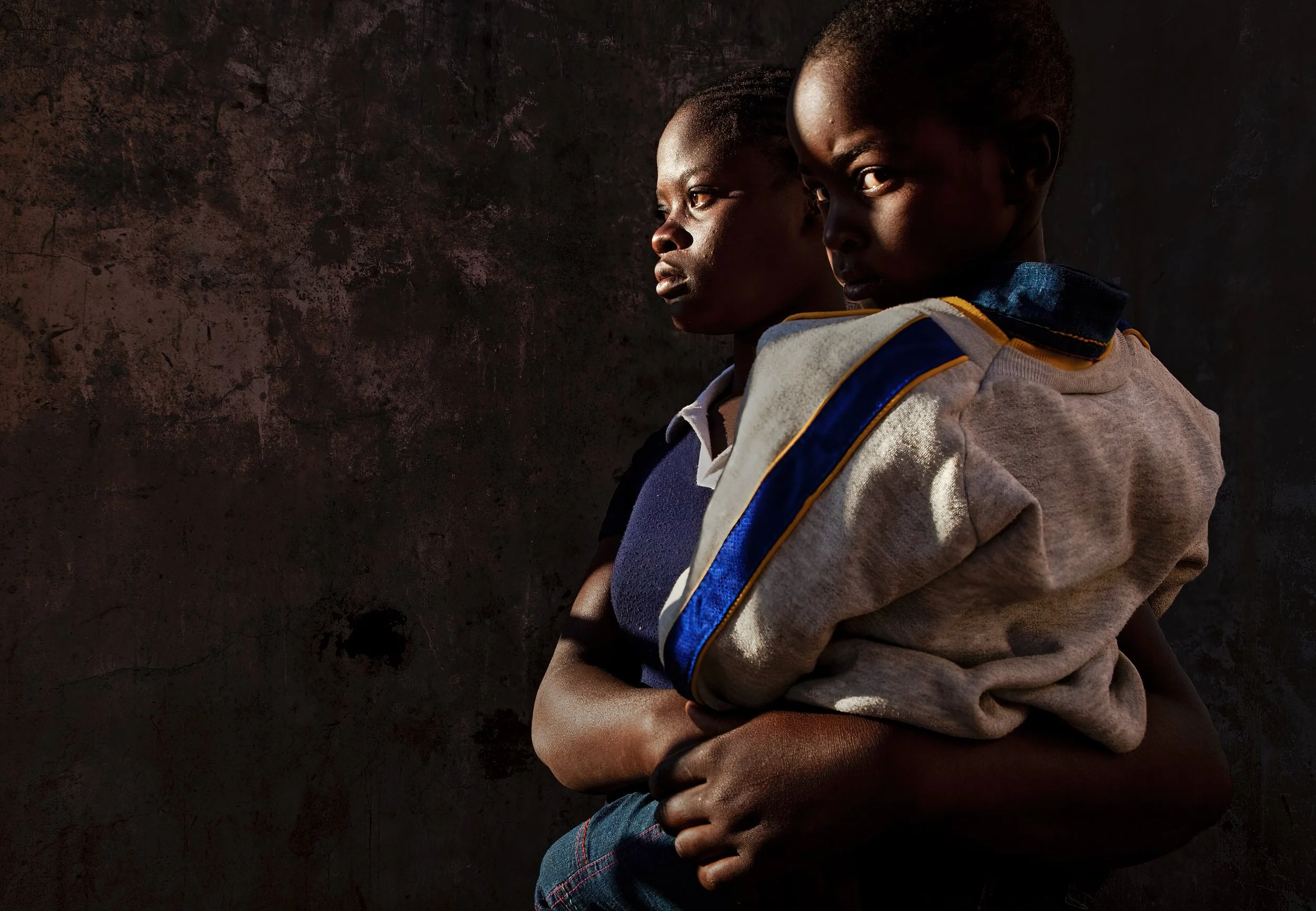
ZAKA, ZIMBABWE, JUNE 2009: A young widow holds her child in a house destroyed by Zanu PF in a rural area of Zaka, Zimbabwe, 24 June 2009. She lost her husband at the conclusion of 2008's March elections in Zimbabwe where the MDC emerged the winner. Two Zanu PF sponsored Zimbabwean Army soldiers appeared at the MDC offices in Zaka. The soldiers shot one MDC worker in cold blood outside the office, shot another inside the office and then locked 3 more MDC officials inside and proceeded to pour 20 litres of petrol over the building, set it alight and fled. In the resultant blaze all three men suffered third degree burns before they were able to break down the door and escape. They suffered for three days without any treatment before they could reach a facility which could treat them. Once there, doctors were forced to hide the three men as Zanu PF supporters came looking for them with the intention of finishing the job the soldiers had started. This young widow is now dependant on the kindness of those around her for the liveliehoods of herself and her two orphaned children. (Photo by Brent Stirton/Reportage by Getty Images.)

JOHANNESBURG, SOUTH AFRICA, JUNE 2009: Adrian Chirabe, 45, the National Co-ordinator for the Veteran Activists Association of the Zimbabean opposition party, the MDC, photographed in his single room dwelling in Johannesburg, 3 June 2009. Chirabe was a one time successful, apolitical businessman in Harare, the capital of Zimbabwe, he owned 3 major businesses and was a millionaire enterpreneur. Robert Mugabe's Zanu PF party approached him and said he needed to give them a share of his business for "his own protection." Chirabe refused, and within 6 months began to be harrased by Zanu PF thugs. His businesses were vandalised and he was arrested and beaten for 4 days. At the time Chirabe was leasing office space to oppostion party the MDC. In 2003 there was a major crackdown by the Zimbabwean police against the poor and against all likely MDC support. As a patriotic Zimbabwean Chirabe felt he had to become involved and when an MDC plot failed due to a fear-driven lack of support, Chirabe became exposed as an MDC supporter. Police arrested him and took Chirabe to jail where he was tortured for 3 days by suffocation, beatings and torture. When he was released, the CIO, Mugabe's secret police were waiting for him outside the policestation. They took him, blindfolded him, drove him to another base and interrogated him through torture for another 4 days. He was then driven home by members of the CIO to attend his brothers funeral with CIO officers in tow, forced to lie to his family about who they were. Chirabe ran away the next day and was recaptured trying to get to South Africa. This time the CIO took him to a government base where he was held for 10 days. During that time Chirabe was tortured in every conceivable way and gang-raped repeatedly by 20 men. Upon release a shattered Chirabe fled to South Africa with his family as soon as he could walk, 3 years and 4 months later. His torture has left him with multiple long term complications, including permanent rectal damag

JOHANNESBURG, SOUTH AFRICA, JUNE 2009: Susan Matsunga, 30, is a former MDC Zimbabwean opposition party Secretary for Gender on a National level, she is photographed in her half of a one bedroom shack in Lenasia, Johannesburg, South Africa, 3 June 2009. Susan was a very active organiser for the MDC, her primary role was to identify and build the future female MP's of Zimbabwe. In the run-up to the 2008 election in Zimbabwe Susan and her MDC youth compatriots attempted to hold prayer meetings and galvanise the youth. Police attacked their gathering and beat people until they dragged off to the police station where despite their wounds they were made to keep silent and denied food and water. All MDC supporters were made to lie flat and the police walked amongst them, beating them for over an hour. When Morgan Tsangarai, the leader of the MDC arrived and asked what the police were doing, they said they were waiting for him. The police then beat him to a pulp along with the others. In this beating Susan's right arm and leg were fractured but still she was forced to climb into a cattle truck along with the others where they were driven to Central Police Station in Harare. Here Susan was tortured for a further 4 days, her torture included the use of electric shock devices on her genitals. She was taken to a room with blood sprayed across the walls. The CIO officers holding her said that she must also leave her blood in this room. At this time Susan's mother, 67, was also arrested and badly beaten. After a number of days Susan was told she must drink 5 litres of contaminated water and then she could go. The CIO visited her in hospital where they told her that if she did not campaign for Mugabe they would kill her. They held syringes in their hands while they were saying this. After her ordeal Susan's husband left her as a result of her affiliation with the MDC. Susan fled to South Africa where she had no papers, passport or ID documents. Sympathetic border guards let he
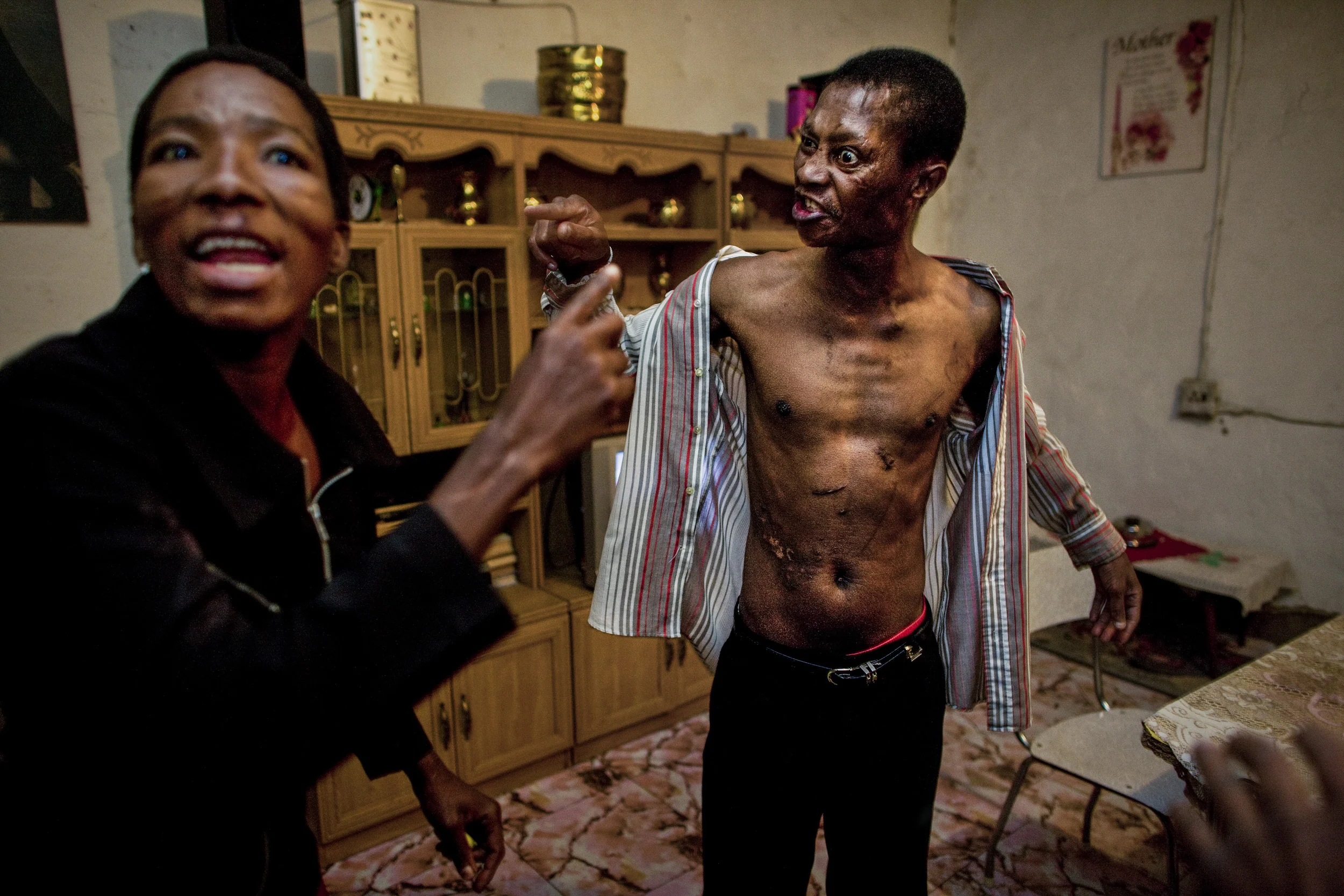
ALEXANDRA TOWNSHIP, JOHANNESBURG, SOUTH AFRICA - JUNE 7: The Alexandra township Crime Prevention Forum member's patrol confront scenes of domestic violence, June 7, 2008 in Alexandra township, South Africa. The patrol does not receive the backing they deserve from the local police, and often complain of police in-action in cases they initiate. Members of the C.P.F regularly risk their lives to protect the Alexandra community from crime and violence. They have confiscated 611 illegal guns in their history. Three were shot and killed last year alone in Alexandra. The Crime Prevention Forum is an idea that has been around since 1994, and is based on the fact that township people can expect little help from the police who cannot even come into some of these township communities without being attacked. As a result these CPF's conduct weekend patrols and act against rapists, burglars and other criminals. They do this with no financial assistance and very few weapons other than a whip "sjambok" with which to subdue the criminals and one handgun amongst 15 people on foot patrol. Once captured, the criminals are handed over to the police. Controversially, it has emerged that a key member of the Alexandra C.P.F is one of the individuals who, in a meeting in May 2008, called for the attacks on immigrants that have recently raged across South Africa. Alexandra was the genesis point for that most recent violence and it is disturbing that a member of the community anti-crime force should be involved in such a bloody affair. The most recent spate of xenophobic violence has left more than 70 people dead and over 30 000 displaced across South Africa. (photo by Brent Stirton/Getty Images.)
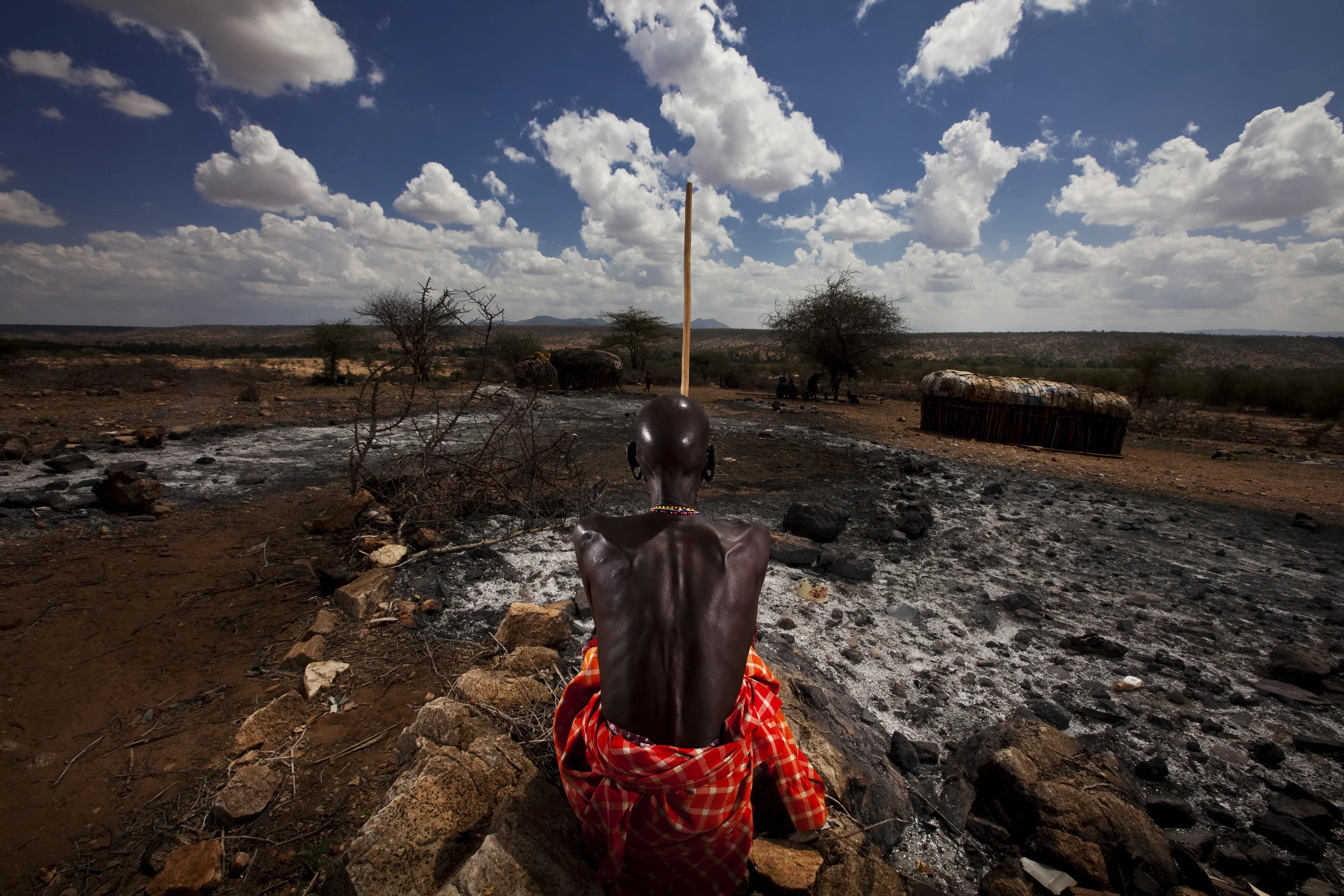
RIFT VALLEY PROVINCE, KENYA, NOVEMBER 2009: An emaciated Samburu Elder pastoralist stands in his burnt-out cattle boma at at time of the worst drought in Kenya for the last 100 years, 20 November 2009. It is traditional for the Samburu and other pastoralist groups to burn their bomas if they lose their cattle to disease or drought, it is done as a cathartic excercise to remove the bad luck of the old and hopefully bring about better luck for the future. Many Samburu have lost up to 95% of their herds, making starvation a real threat over the coming months. The drought has brought about increasingly deadly conflict between pastoralists as well as conservationists all competing for grazing land. (Photo by Brent Stirton/Reportage by Getty Images.)

RIFT VALLEY PROVINCE, KENYA, NOVEMBER 2009: Images of a massacre site where the Pokot tribesman came out of the Rift Valley, their traditional area, and attacked a Samburu village over cattle grazing rights in the north of Kenya at a time of the worst drought in the region for the last 100 years, 20 November 2009. 25 Samburu men, women and children were killed in the attack, over 50 cattle were shot and over 300 died later in the week from not being able to access grazing land because of the threat of the Pokot. The drought has brought about increasingly deadly conflict between pastoralists as well as conservationists all competing for grazing land. (Photo by Brent Stirton/Reportage by Getty Images.)
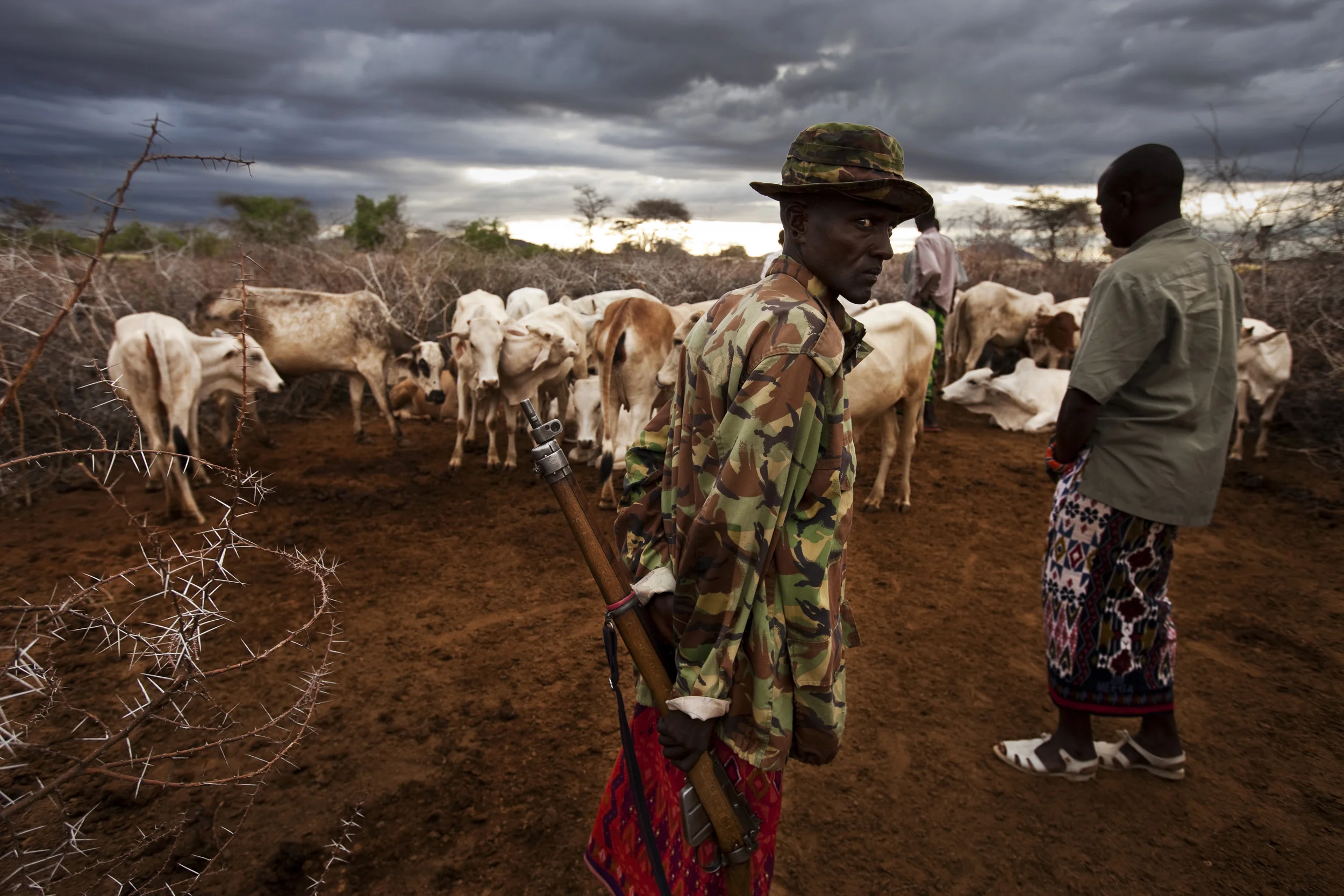
LAISAMIS, MARSABIT SOUTH, NORTH KENYA: A Kenya Police reservist guards Borana cattle which were raided by Rendille Moran tribesman in retaliation for a huge Boran raid in September 2009, North of Kenya, 27 February 2010. The police are being assisted in this matter by the members of the Melako Conservancy who are formed from the local community and are involved in conservancy and other peace-keeping affairs for the region. A cattle exchange is planned between the Rendille and the Borana which will be mediated by the Melako conservancy comittee and the police. North Kenya is currently undergoing an intense disarmament process in which the Kenyan Army and Administrative Police are trying to disarm the local tribes, mainly the Borana, the Samburu, the Rendille and Somalis, amongst others. This process is controversial as the tribes feel they have to have weapons to protect against cattle raids from the other tribes. This is an age old conflict but the Rendille and Samburu feel especially vulnerable as the Borana exist on both sides of the border region with Kenya and can thus access weapons from their fellow tribesmen on the Ethiopian side. This is also true of the Somalis and as such the Rendille and Samburu feel especially vulnerable. Although weapons have been collected there are many stories of violence by the Kenyan authorities against the tribes in this process, especially against the Samburu and the Rendille. This process has not been helped by the fact that many of the biggest cattle raids in history have been made by the Borana against the Rendille and Samburu in the last year. It looks unlikely that of the 23 000 weapons allegedly in the field only a few hundred have thus far been collected. (Photo by Brent Stirton/ Reportage by Getty Images.)

KOYA, MARSABIT SOUTH, NORTH KENYA: Melako Conservancy Scouts patrol around abandoned buildings in Koya, an area which became a vast no mans land after extensive cattle raiding between the Rendille tribe and the Borana tribe, Koya, north Kenya, 28 February 2010. Images of tribal conflict and cattle and wildlife raids adorn the walls of an abandoned clinic illustrating the tensions of the area. The Rendille ended up moving 42 kilometers away and the Borana also pulled back, leaving a viable pastoral and conservation area deserted and contentious. The Melako Conservancy community group with the help of the Northern Rangelands trust are trying to rehabilitate the area for both Pastoralists and for wildlife tourism. The scouts are appointed by the community and with the help of a few Kenya Administrative Police are trying to secure the area and the wildlife so that people may safely return and invest in the area for both their cattle and tourism returns. (Photo by Brent Stirton/ Reportage by Getty Images.)

LAKE MURRAY, WESTERN PROVINCE, PAPUA NEW GUINEA-JANUARY 2008: Scenes of kids enjoying the lake in Kubut Village, Lake Murray, Papua New Guinea, 1 January 2009. Lake Murray is a region where people have lived lives in harmony with nature for centuries. People make their living by hunting, farming, fishing, and growing rubber trees and now also with Eco-forestry. Their life-styles are dependant on the harmony between them and nature and they are trying to ensure a sustainable relationship for future generations. This has been complicated and compromised by the interventions of both international mining and logging groups over the last few decades but local community resistance is growing as rising anger mounts at the environmental damage done to rivers and forests which form the backbone of the village survival system. (Photo by Brent Stirton/Reportage by Getty Images.)


MIDDLE SEPIK, PAPUA NEW GUINEA-DECEMBER 2008: The interior of a family hut in a Karawari village of the middle Sepik river, 15 December 2008. The Karawari are the most remote of the floodplains people, with many vllages along the river barely a generation old. The most recent settlements date only from 1996. (Photo by Brent Stirton/Reportage by Getty Images.)
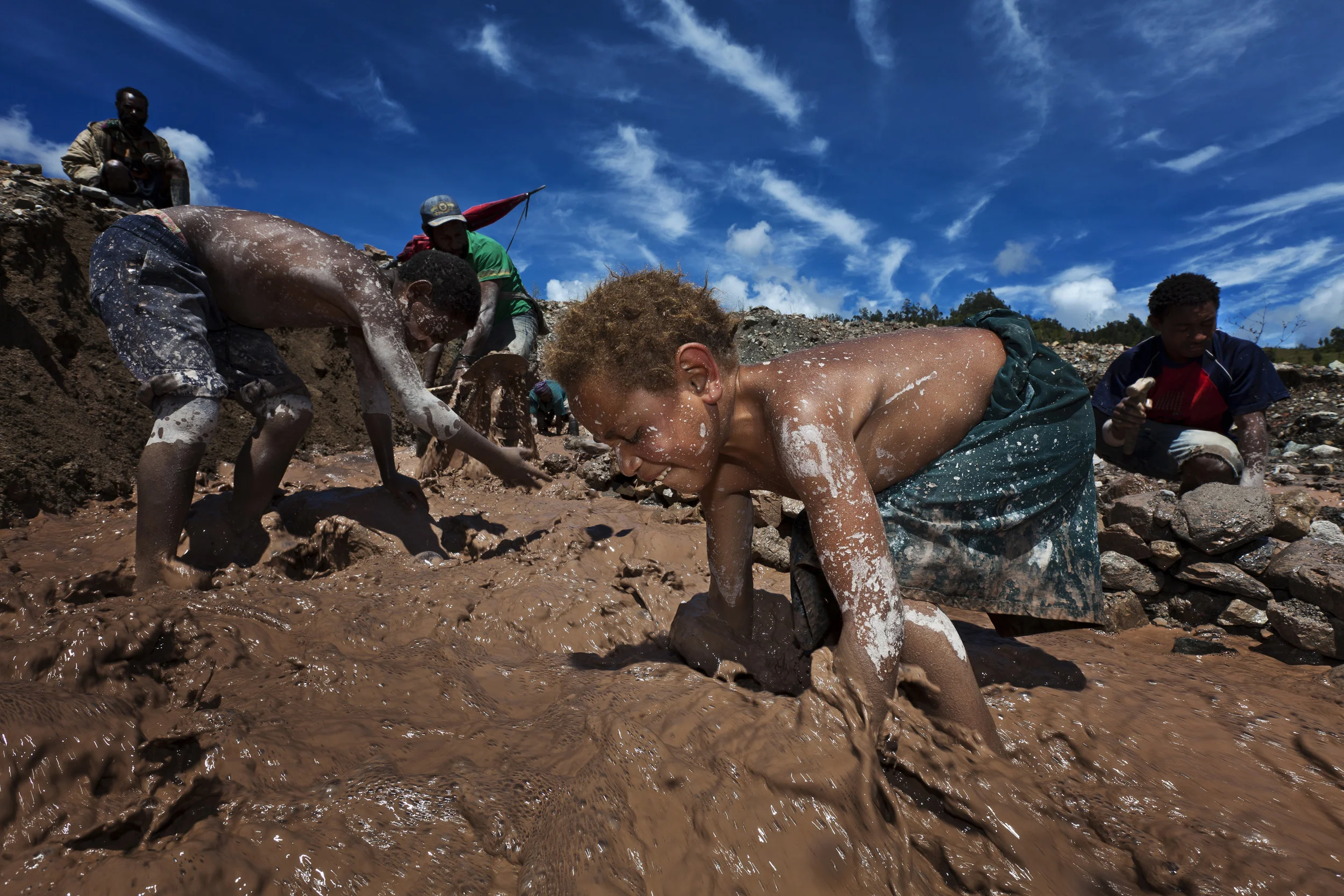
PORGERA, PAPUA NEW GUINEA HIGHLANDS, NOVEMBER 2010: An impoverished Papuan family illegally prospects in a mine tailings river with heavy metal laden waters on the outskirts of the Porgera Joint Venture Mine, Papua New Guinea, Porgera, Papua New Guinea, 21 November 2010. These empoverished people engage in illegal mining on the dumps and tailings outflow areas of the mine in order to survive. They take their five year old daughter and their 7 year old son with them on their daily mining excercises, child workers are a common site on these dumps which are both toxic and a highly dangerous illegal environment. Many of these local people sold their land to the mine for a period of the operational life of the mine. They underestimated how long the mine would keep going and the expansion thereof. The Mine dumps now flow onto the last viable land of these local people and they illegally mine those dumps to eke out a living. The ability to grow vegetable gardens is very limited and there is no hunting anymore. There are regular clashes between these illegal miners and the Porgera Joint Venture mine security force. That security force has regularly beaten, detained and handed these miners over to the police. When the illegal female miners are caught they are often offered a choice of rape or jail. There are a number of reported incidents of gang rape, with the victims too scared to file charges in court. The mine finances both its own security force of ex policeman and military as well as the local PNG government police who they have brought to the area. The environmental damage caused by the Porega Mine is a major threat to this landscape and the wellbeing of the local people who have lived in harmony with their environment for centuries. The Porgera Joint Venture Mine dumps 6.2 million tons of tailings sediment into the local river system every year. Close to the mine the waters are red from these tailings and it is feared that long term damage of the river system is inev

Daily life in Papua New Guinea
PUKAPUKI, PAPUA NEW GUINEA, AUGUST 2004: A local man showers underneath a waterfall in the rainforest close to his village in the mountains of Papua New Guinea. Traditional ways of life are under threat in Papua as villages have very little means of raising money through which to educate their children and pay medical bills. Traditional ways of life are based on sustainable farming and hunting practise. As Papuans move towards a more western lifestyle and the government attempts to raise capital for modernisation, villages are selling their natural resources such as the timber of the rainforest. This is a non-sustainable practise at this point and is having a devastating effect on water supply, traditional river routes and erosion patterns. Education as to these factors is a vital but lacking components in this transition period for Papua New Guinea. PHOTO BY BRENT STIRTON/GETTY IMAGES

KIKA, CAMEROON, JULY 2010: Members of the Baka Pygmy tribe, the original forest dwellers of the Cameroon forests, Kika, Cameroon, June 9, 2010. The Baka have small logging concessions of their own in community forest areas but are plaughed by a lack of education, logging equipment, access to markets and an addiction to alcohol fostered by their Bantu neighbours who ruled them for many years and who often pay the Baka for labor in alcohol. Logging roads and subsequent small towns created by logging concessions are bringing man and infrastructure further into the forest of Cameroon than ever before, Kika, Cameroon, June 5, 2010. This is severely threatening the great forests of the Congo Basin, one of the last great Forest reserves in the world. The Congo Basin forests cover an area the combined size of France and South Africa. The forests of Cameroon form a large part of this basin. Still relatively intact and connected, these forest ecosystems and freshwater systems are home to abundant wildlife and provide food, shelter, clean water and protection against floods to more than 75 million people. The economic value of these systems is enormous. Timber alone is worth several Billion Euros annually to the Forest industry, while minerals are also being heavily exploited. The importance of the Congo Basin as a global, natural reservoir to store Carbon is also massive. CO2 emissions from deforestation of this region could be devastating for agriculture and water resources. The challenges for Cameroon are enormous. If social and economic development needs are to be met, then development will have to be sustainable. As such a number of key threats will have to be addressed: 1. Unsustainable Timber exploitation – as much 50% of all timber from the region is believed to be illegal. This represents 10-15 billion Euros annually. 2. Major Infrastructure Development – this is linked to the increasing exploitation of logging, mining and oil exploration as well as potential dam

Yemen and the Guantanamo connection
SHEBAM-KAWBABAN, YEMEN - 21 NOVEMBER 3 2005: Yemen has the second highest percentage of prisoners housed in Guantanamo Bay. One of the reasons for this this is a long standing warrior culture which has existed since before the time of the Prophet Mohammed. This is depicted in this image of two local men stand on the hillside outside their ancient fortress-like city on top of a mountain in Shebam-Kawbaban. The men are traditionally dressed and are armed with AK-47's. Yemen has a long history of warrior culture which continues today. Owning and carrying a weapon is normal, especially outside of the capital city of Sana'a. The weapon is considered a symbol of male pride and prowess and is considered neccesary in these areas. (Photo by Brent Stirton/Getty Images) *** Local Caption *** Guantanamo Prisoners Families
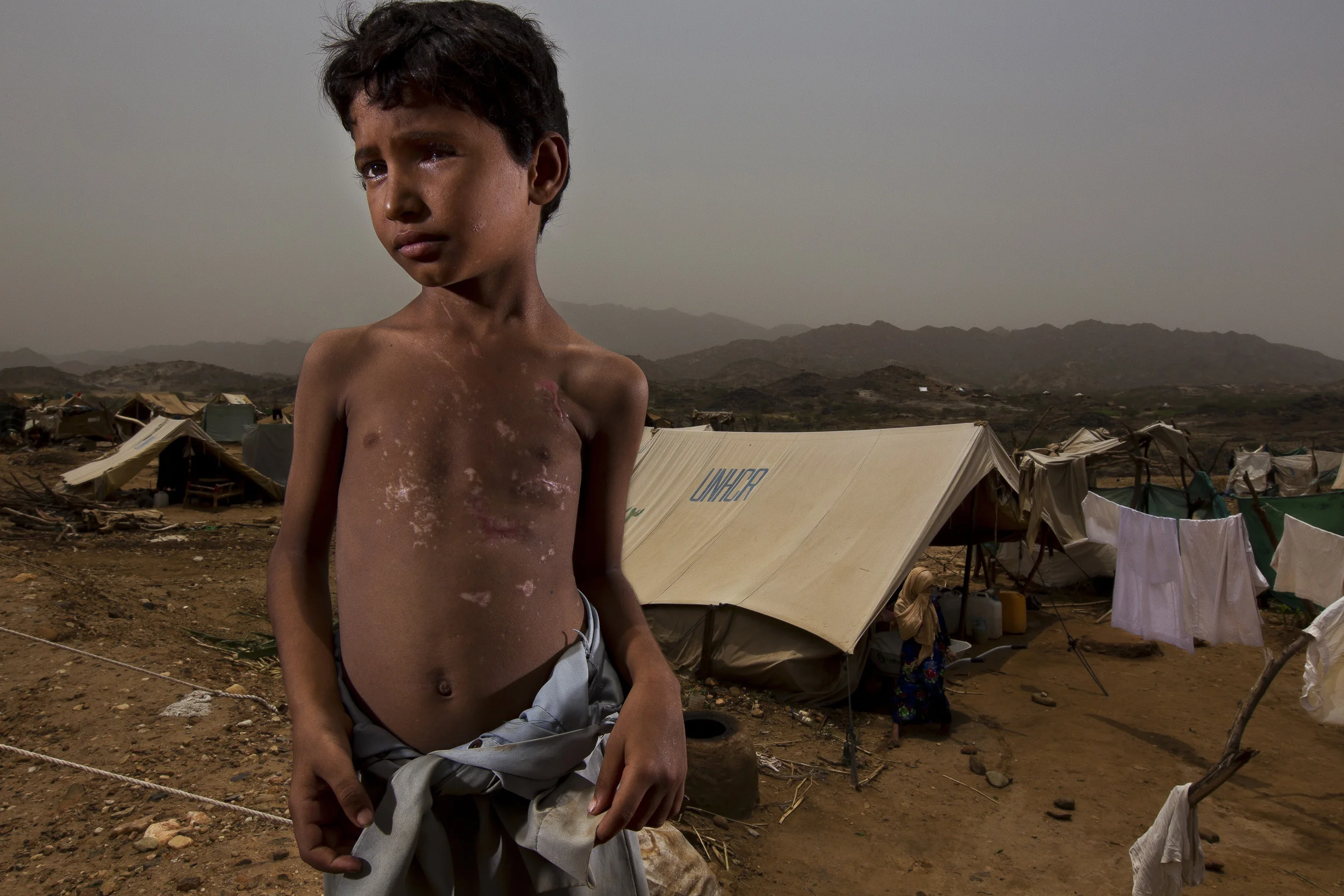
AL-MAZRAQ, YEMEN, AUGUST 2010: War victim eight year old Abbas, is seen at the Al-Mazraq IDP camps, Al-Mazraq, Yemen, August 14, 2010. Abbas was walking with his uncle in the Sa'ada region when his uncle stepped on a landmine and was blown to pieces. Shrapnel from the mine, ordinance from the war between Yemeni Government forces and the Al-Houthi Shiite group, sprayed into Abbas's chest and blinded him in one eye. Abbas's ten year old sister was also injured in the blast. They represent two of thousands of children at dire risk in this conflict. A shaky ceasefire reached in February 2010 brought a halt to the 6th round of conflict between the Government of Yemen and the Shiite Al-Houti group in the Sa'ada Governate. The situation is fragile and sporadic clashes are ongoing. According to UNHCR, around 316 000 Internally Displaced People are scattered throughout the five conflict affected governates of Hajjah, Amran, Sa'ada, Al-Jawf and Sana'a. Over 60% of these people are women and children. Food, water and sanitation needs are extensive and various child protection issues have also emerged, ie landmine and ordinance risk, war trauma and the recruitment of children by armed forces. (Photo by Brent Stirton/Reportage by Getty Images.)

HODEIDAH, YEMEN, AUGUST 2010: An eight year old amputee Nigerian boy locked up in Hodeidah Central Prison, Hodeidah, Yemen, August 12, 2010. He is in prison with a man who claims to be his brother. They were captured by Yemeni authorities while trying to get to Saudi Arabia to seek work or to beg for funds. There is a possibility that this boy is a child trafficking victim who has been deliberately mamed in order to make him a more viable begging prospect in Saudi Arabia. He has subsequently been rescued from this prison by the joint efforts of Unicef and UNHCR, who have removed him to a safer environment while they investigate his case. He has already spent more than 13 months in this prison in the company of adult prisoners. This prison houses a majority of African illegal immigrants who have made their way by perilous land and boat journeys to Yemen from Nigeria, Ethiopia, Eritrea and Somalia. They are in Yemen in order to make their way to Saudi Arabia. Most attempt to walk to Saudi from their beach landing in Hodeidah and cross the Yemen/Saudi Border illegally in order to secure manual labour employment. The majority of the inmates of this prison have been caught and imprisoned in the process of this endevour. (Photo by Brent Stirton/Reportage by Getty Images.)
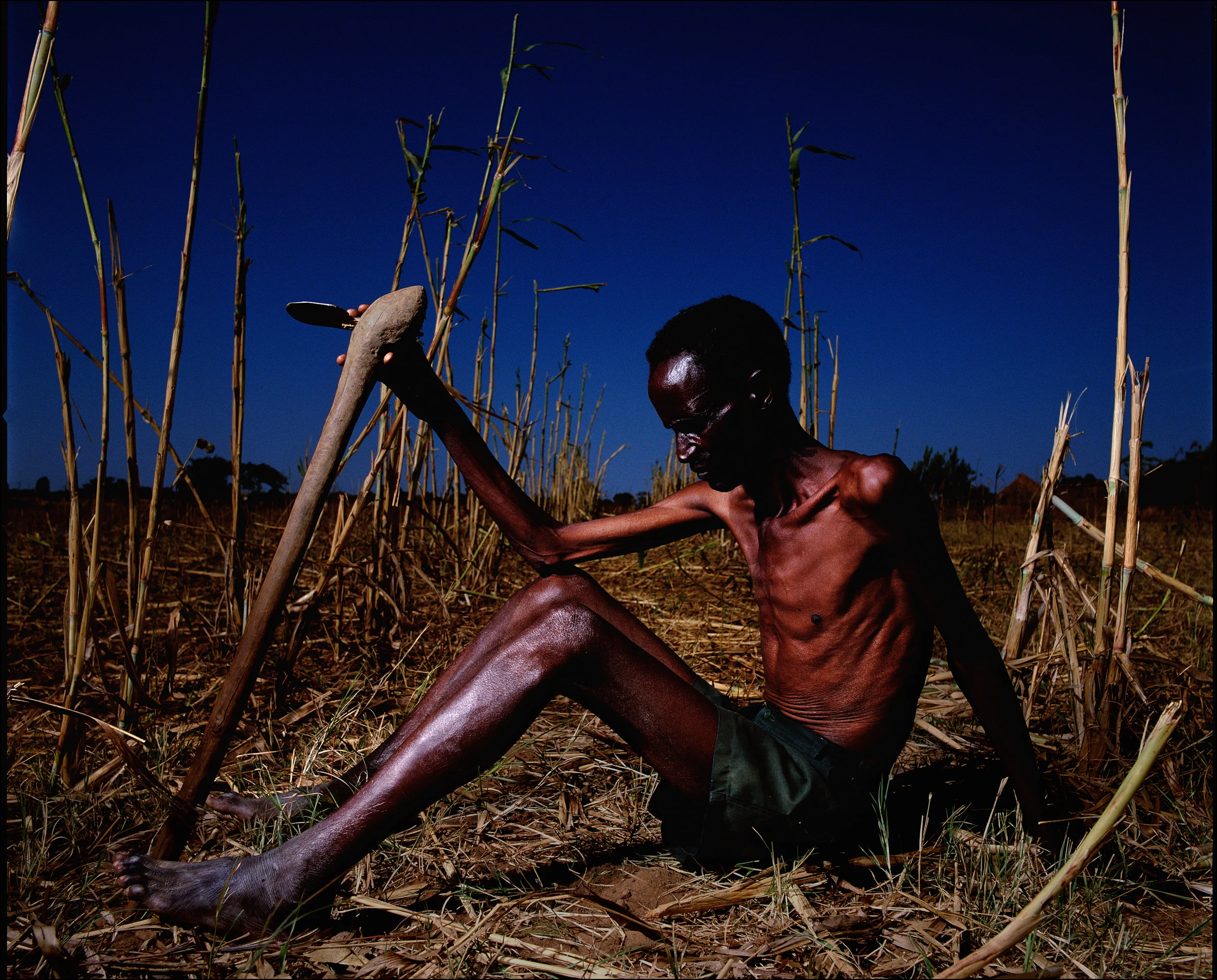
Northern Zambia, August 2003. Zambia enters its 6th year of severe drought. A starving farmers sits amongst the ruins of his failed crop. He is HIV+ and his malnutrition has greatly accelerated the decline of his immune system.

GAIBANDAH, BANGLADESH-AUGUST 2008: Vulnerable farmers on flood damaged islands work to clear rice fields damaged by annual floods which destroy crops and homes amongst the poor on a yearly basis, Gaibandah, Bangladesh, 2 August 2008. Bangladesh is one of the worst affected countries in terms of food security. The price of food staples have doubled in the last 5 months and civil unrest is a possibility in the near future. Rising world energy prices, one of the world's poorest populations, and a loss of government subsidies for food staples combined with the world's highest flood plain has meant that many people are down to one meal a day. (Photo by Brent Stirton/Getty Images.)
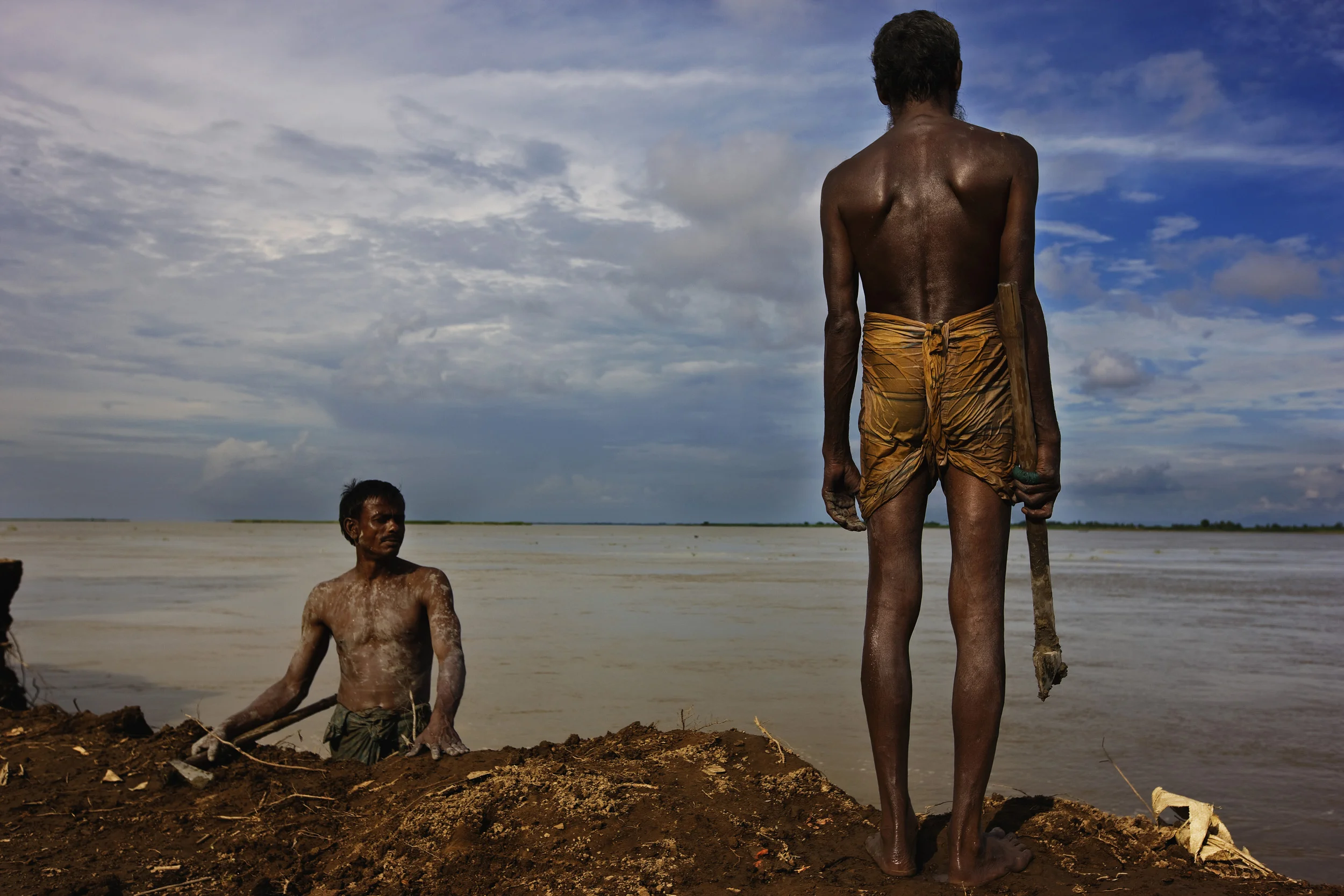
KURIGRAM, BANGLADESH-AUGUST 2008: Flood affected village men hack away the embankment left by the most recent flooding in the area where their village used to be, Kurigram, Northern Bangladesh, 2 August 2008. They are doing this on the orders of the local landowner who is using this earth for contruction in another area. These men are effectively further removing the only barrier between them and further flooding but desperately need the small amount they are paid so do the work anyway. The lack of a serious engineering works aimed at flood prevention in Bangladesh is behind the suffering of millions of impoverished rural people. Annual predicable floods bring misery to millions without any effective counter plan. A fatalistic nations chooses instead to move rather than try to combat the flooding through engineering ingenuity. Flooding, Poverty and lack of protected land ownership amongst the poor is driving a serious food crisis in Bangladesh. A male labourers makes around 90 US cents a day while a women makes around 50 US cents a day working in the fields. Extreme poverty and rising food prices couple with an oversupply of cheap labour has meant that many people can only afford to eat once a day. Many labourers sell their services up to a year ahead and have been caught out by rampant food prices which are beyond the reach of their wages. Bangladesh is one of the worst affected countries in terms of food security. The price of food staples have doubled in the last 5 months and civil unrest is a possibility in the near future. Rising world energy prices, one of the world's poorest populations, and a loss of government subsidies for food staples combined with the world's highest flood plain has meant that many people are down to one meal a day. (Photo by Brent Stirton/Getty Images.)

1234567BS_031.JPG
BAGHDAD, IRAQ - 16 FEBRUARY 2005. First Segeant Troy Hawkins falls wounded to the ground during a firefight in the troubled Haifa street area of Baghdad. Sgt Hawkins was wounded in the leg and shoulder but continued to direct troop movement before walking out of the fire zone.The Iraqi National Guard members he was fighting alongside have been trained by U.S Coalition forces to work in this area which is a flashpoint for clashes. U.S forces are in the process of handing over complete authority to the Iraqi National Guard. Although still currently involved in the patrols, the U.S forces are phasing out their direct involvement in this kind of security operation. (Photo by Brent Stirton/Getty Images for Newsweek) *** Local Caption *** Iraqi post-election discussion, Baghdad.
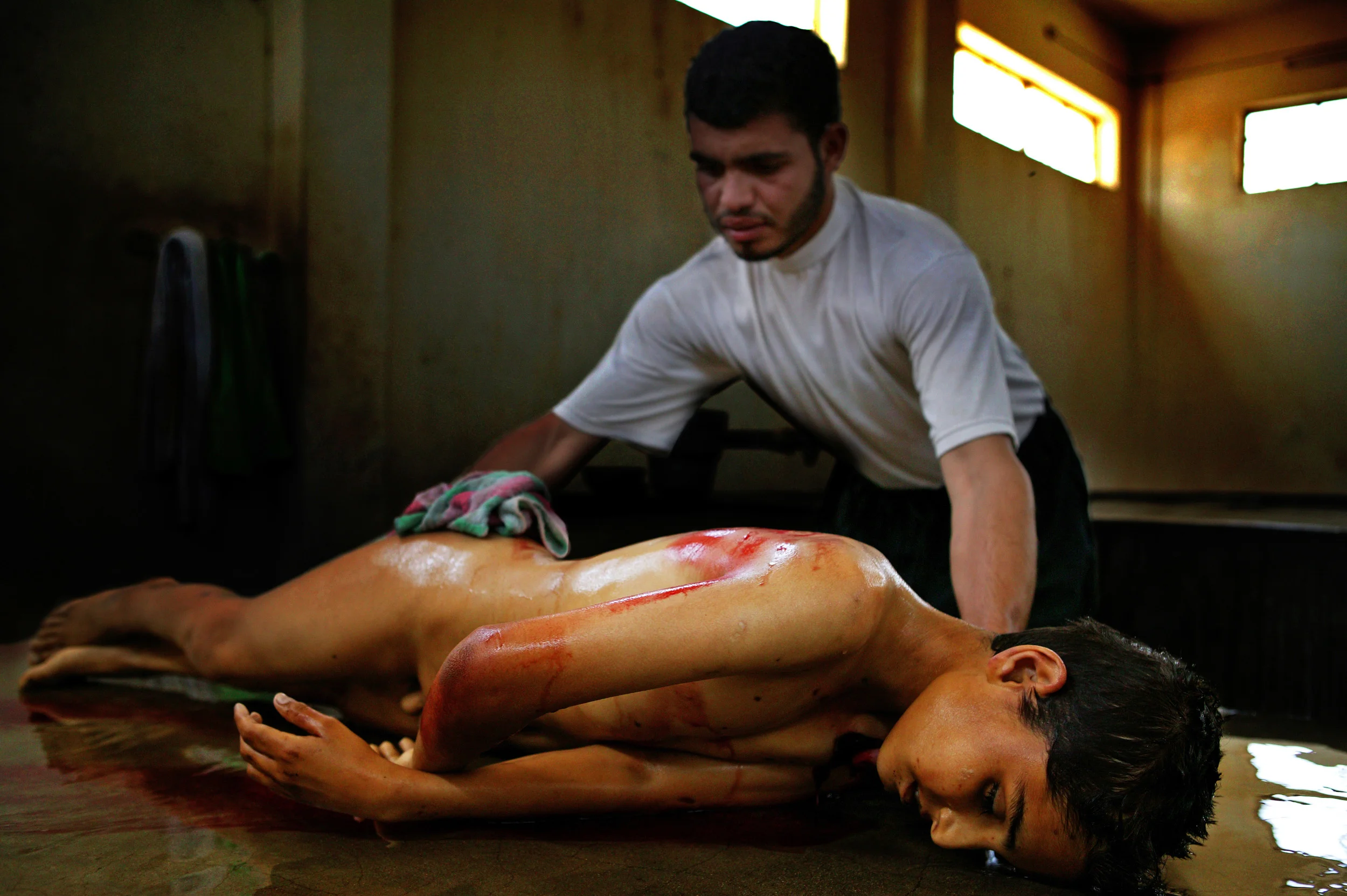
1234567BS_001.jpg
NAJAF, IRAQ-MAY 2005: Hussam Hassan washes the body of 12 year old Ali Basem Karim who was killed in Basra when the wedding he was attending was attacked by extremist militias. The wedding was attacked because they were celebrating and that was not considered apporopriate by the militia group. Another child was wounded in the attack. *** Local Caption *** Assignment Iraq

1234567BS_001.jpg
NAJAF, IRAQ - MAY 2004: Militia supporters of cleric Mugtada Al-Sadder guard the streets in Najaf. This group clashes on a daily basis with the coalition forces and tensions are high in the area. PHOTO BY BRENT STIRTON/GETTY IMAGES

1234567BS_022.JPG
BAGHDAD, IRAQ - 16 FEBRUARY 2005: U.S forces and the Iraqi National Guard fight together during a firefight in the troubled Haifa street area of Baghdad. These National Guard members have been trained by U.S Coalition forces to work in this area which is a flashpoint for clashes between Sunni militants and Shiite residents. U.S forces are in the process of handing over complete authority to the Iraqi National Guard. Although still currently involved in the patrols, the U.S forces are phasing out their direct involvement in this kind of security operation. (Photo by Brent Stirton/Getty Images for Newsweek) *** Local Caption *** Iraqi post-election discussion, Baghdad.
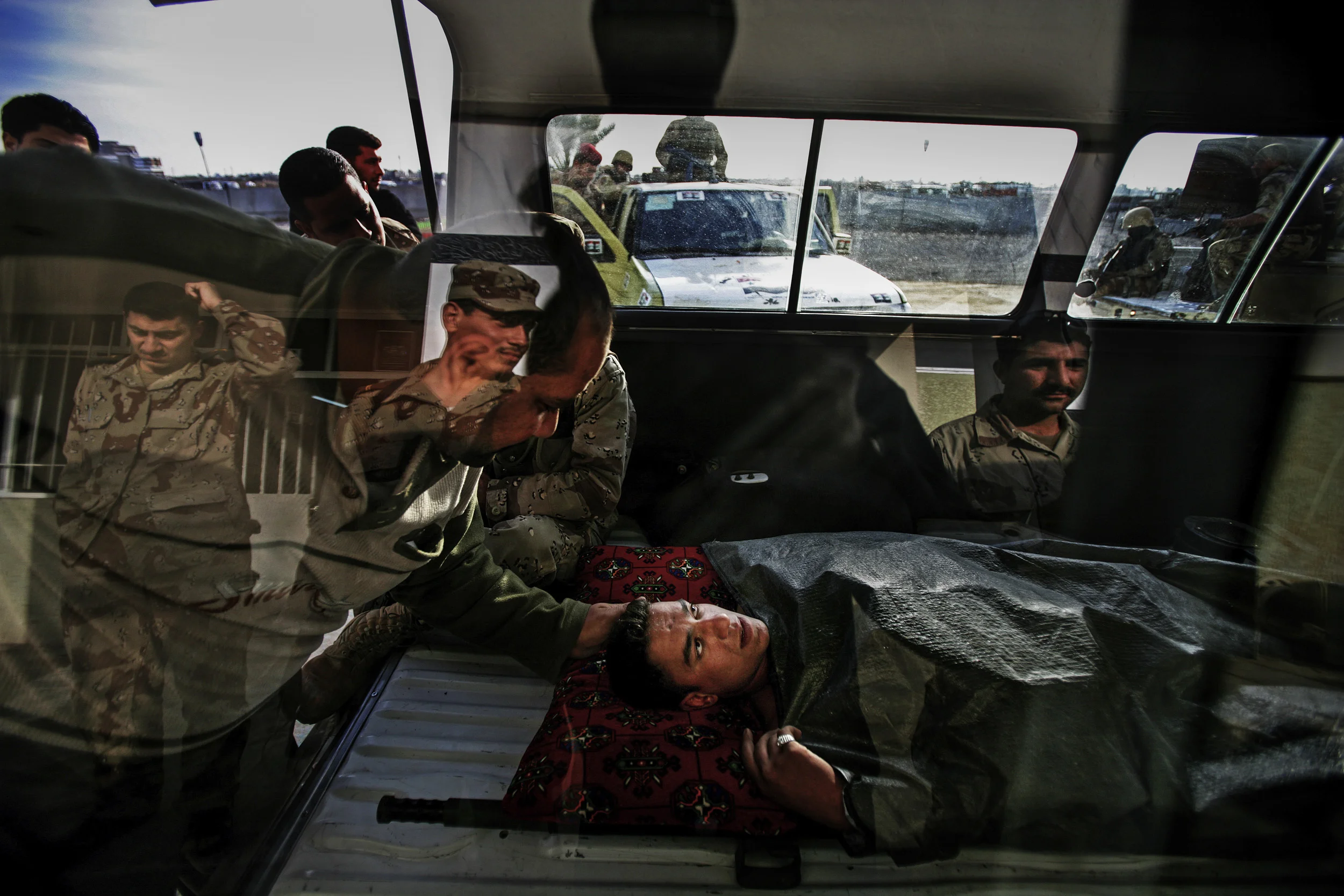
1234567BS_003.JPG
BAGHDAD, IRAQ - 17 FEBRUARY 2005: Iraqi National Guard member Ali Nadim, 20, is rushed to hospital after being wounded by grenade attack during a firefight in the Haifa street area of Baghdad. These Iraqi National Guard members have been trained by U.S Coalition forces to work in this area which is a flashpoint for clashes. U.S forces are in the process of handing over complete authority to the Iraqi National Guard. Although still currently involved in the patrols, the U.S forces are phasing out their direct involvement in this kind of security operation. (Photo by Brent Stirton/Getty Images for Newsweek) *** Local Caption *** Iraqi post-election Iraqi Nationa Army, Baghdad.

KABUL, AFGHANISTAN-APRIL 2007: Scenes from a drugs bust conducted by the Afghan Anti-Narcotics unit assisted by American DEA agents who have been training these men for over 2 years, Kabul, Afghanistan, 18 April 2007. The images show a search scene and arrest with 2 suspects in custody. 6 kilos of processed heroin was confiscated in the raid. Afghanistan currently produces over 90% of the world's illegal opium and the industry accounts for over 45% of the countries annual GDP. A great deal of this production is based on communal poverty and a lack of alternatives for farmers combined with coercion from the opium cartels of Afghanistan and Pakistan. The event is filmed by CNN freelance crew Cameraman Richard Parry and producer Tresha Mabile. (Photo by Brent Stirton/Getty Images.)
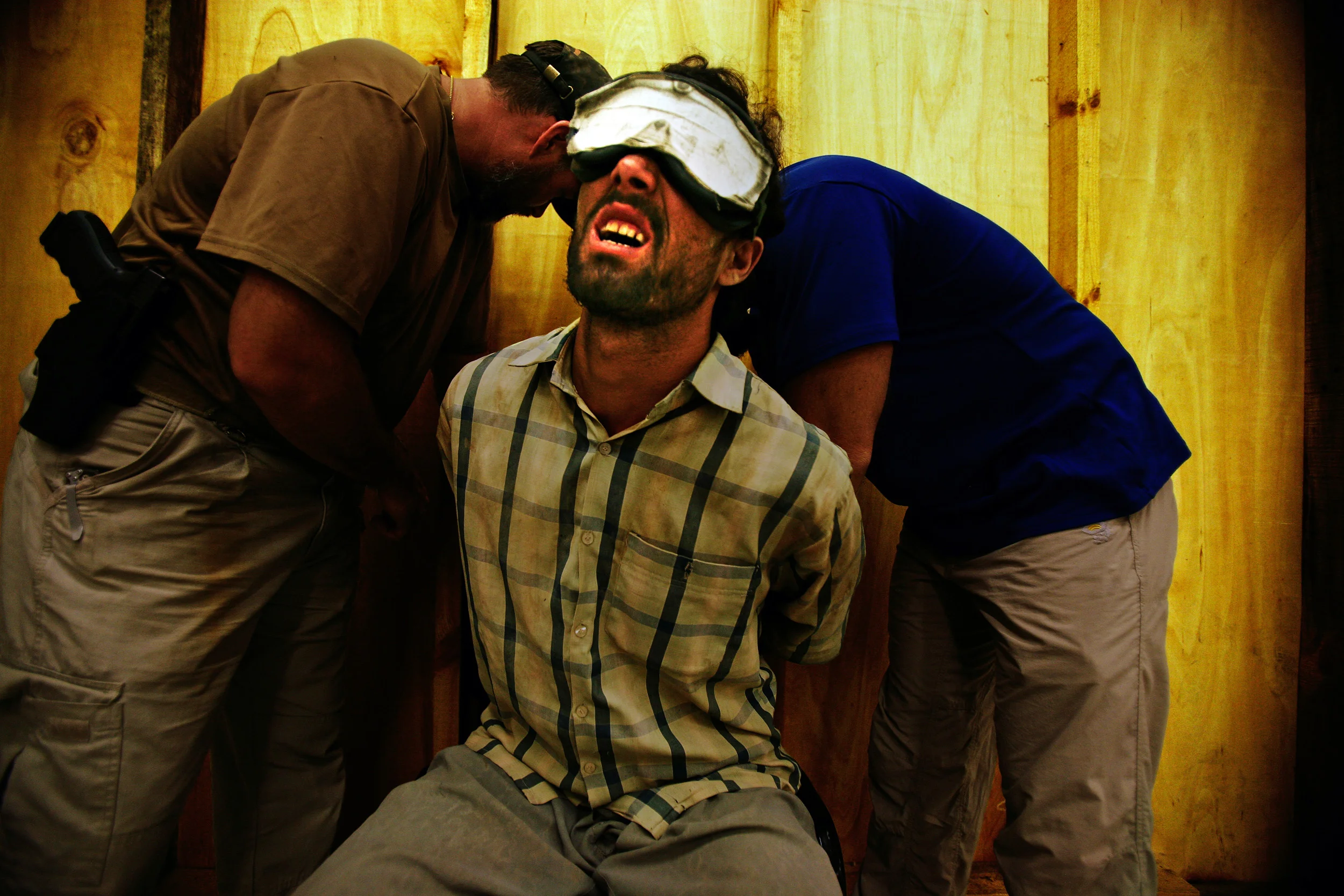
KABUL, AFGHANISTAN-APRIL 2007: Scenes from a drugs bust conducted by the Afghan Anti-Narcotics unit assisted by American DEA agents who have been training these men for over 2 years, Kabul, Afghanistan, 18 April 2007. The images show a search scene and arrest with 2 suspects in custody. 6 kilos of processed heroin was confiscated in the raid. Afghanistan currently produces over 90% of the world's illegal opium and the industry accounts for over 45% of the countries annual GDP. A great deal of this production is based on communal poverty and a lack of alternatives for farmers combined with coercion from the opium cartels of Afghanistan and Pakistan. The event is filmed by CNN freelance crew Cameraman Richard Parry and producer Tresha Mabile. (Photo by Brent Stirton/Getty Images.)

JALALABAD, AFGHANISTAN-APRIL 2007: Images from illegal opium producing poppy farms an hours travel outside of Jalalabad, Afghanistan, 19 April 2007. Afghanistan currently produces over 90% of the world's illegal opium and the industry accounts for over 45% of the countries annual GDP. A great deal of this production is based on communal poverty and a lack of alternatives for farmers combined with coercion from the opium cartels of Afghanistan and Pakistan. The event is filmed by CNN freelance crew Cameraman Richard Parry and producer Tresha Mabile. (Photo by Brent Stirton/Getty Images.)


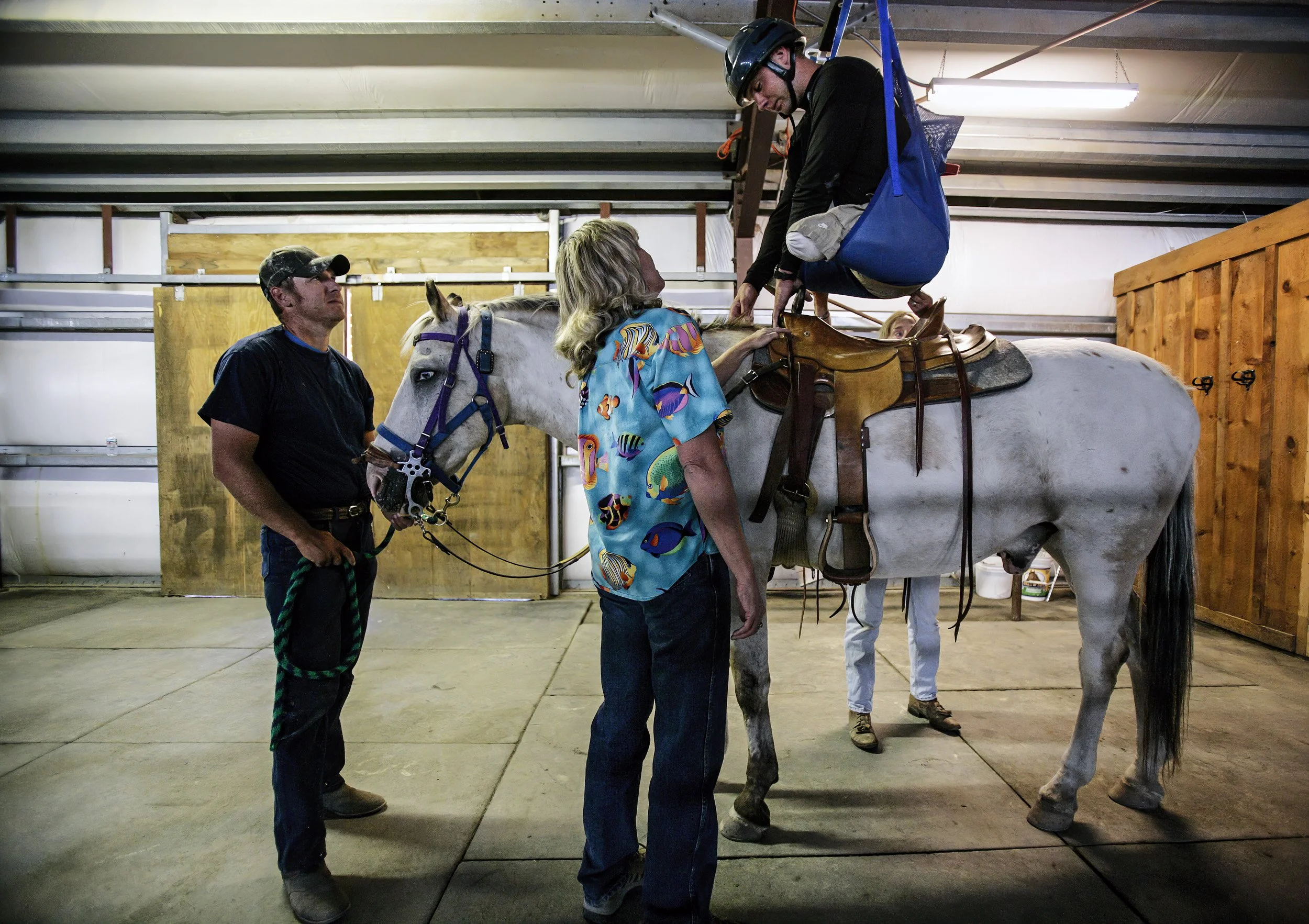
SUN VALLEY, IDAHO - 8/14 AUGUST 2006: Specialist Andy Soule, 25, learns to ride a horse as part of a series of choices he made as to which sports sorts he wanted to pursue as part of a week of outdoor activity. The programm is run by an organisation called Higher Ground and is done in conjunction with the Veterans Administration and is free to these wounded and disabled servicemen and women. These images focus on a week in the life of three disabled war wounded veterans from the Iraq, Afghanistan conflicts. The three men are Major Anthony Smith,39, an African American man who was severely wounded in the hip in Iraq while on deployment. He is missing an arm, is recovering from 4 bullet wounds and has only partial use of his right leg and hip after being struck by an RPG. Damien Jocobs,30, is a Marine Staff Sergeant with a below the knee amputation as a result of an IED explosion in Iraq. Andy Soule, 25, is a specialist who was blown out os his vehicle by an IED in Afghanistan. Andy is a double above the knee amputee. Higher Ground is a program run by Sun Valley Adaptive sports in Kethum Idaho. They are an NGO looking to provide a sports based meaningful rehabiliation experience for disabled veterans. The program involved taking the men, all of whom are amputees of sorts, down the Main Salmon River on a 4 day river rafting trip and then offering them the opportunity afterwards to pursue futher sporting intersts such as climbing, parasailing, kayaking and horse-riding. The program also encourages disabled veterans to bring their wives on the program. It is aimed at a healthier and speedier recovery through outdoor recreation.

SALMON RIVER IDAHO - AUGUST 8/14 2006: Specialist Andy Soule, 25, gets into his inflable kayak at the beginning of the day on a 4 day river rafting trip on the Main Salmon River in Idaho. These images focus on a week outdoors with three disabled war wounded veterans from the Iraq, Afghanistan conflicts. Andy Soule, 25, is a specialist who was blown out os his vehicle by an IED in Afghanistan. Andy is a double above the knee amputee. Higher Ground is a program run by Sun Valley Adaptive sports in Kethum Idaho. They are an NGO looking to provide a sports based meaningful rehabiliation experience for disabled veterans. The program involved taking the men, all of whom are amputees of sorts, down the Main Salmon River on a 4 day river rafting trip and then offering them the opportunity afterwards to pursue futher sporting intersts such as climbing, parasailing, kayaking and horse-riding. The program also encourages disabled veterans to bring their wives on the program. It is aimed at a healthier and speedier recovery through outdoor recreation.

SALMON RIVER IDAHO - AUGUST 8/14 2006: Specialist Andew W. Soule, 25, paddles through rapids as part of a 4 day river rafting trip on the Main Salmon River in Idaho. These images focus on a week outdoors with three disabled war wounded veterans from the Iraq, Afghanistan conflicts. Andy Soule, 25, is a specialist who was blown out os his vehicle by an IED in Afghanistan. Andy is a double above the knee amputee. Higher Ground is a program run by Sun Valley Adaptive sports in Kethum Idaho. They are an NGO looking to provide a sports based meaningful rehabiliation experience for disabled veterans. The program involved taking the men, all of whom are amputees of sorts, down the Main Salmon River on a 4 day river rafting trip and then offering them the opportunity afterwards to pursue futher sporting intersts such as climbing, parasailing, kayaking and horse-riding. The program also encourages disabled veterans to bring their wives on the program. It is aimed at a healthier and speedier recovery through outdoor recreation.

RICHARDS BAY, SOUTH AFRICA-MAY 2004: A young aids orphan stands alone in a field after a church service. PHOTO BY BRENT STIRTON/GETTY IMAGES.

Zimbabe Today: Mugabe's Victims
ZAKA, ZIMBABWE, 14 JUNE 2009: A man and women suffering from advanced Tuberculosis are taken to a clinic via ox-wagon in a rural area of Zaka, Zimbabwe, 24 June 2009. It is likely that both are HIV positive. Transport costs alone to and from the hospital are beyond the means of most Zimbaweans in this failed state. As a result of food scarcity in the failed state, malnutrition plays a large role in the rapid decline of HIV+ Zimbabweans. 25% of Zimbabweans are estimated to be HIV positive but there is only one ARV dispensing facility in the capital Harare. Its costs around $20 for the blood work to get on the program, a sum well beyond the reach of most in a country of over 90% unemployment. (Photo by Brent Stirton/Reportage by Getty Images.)
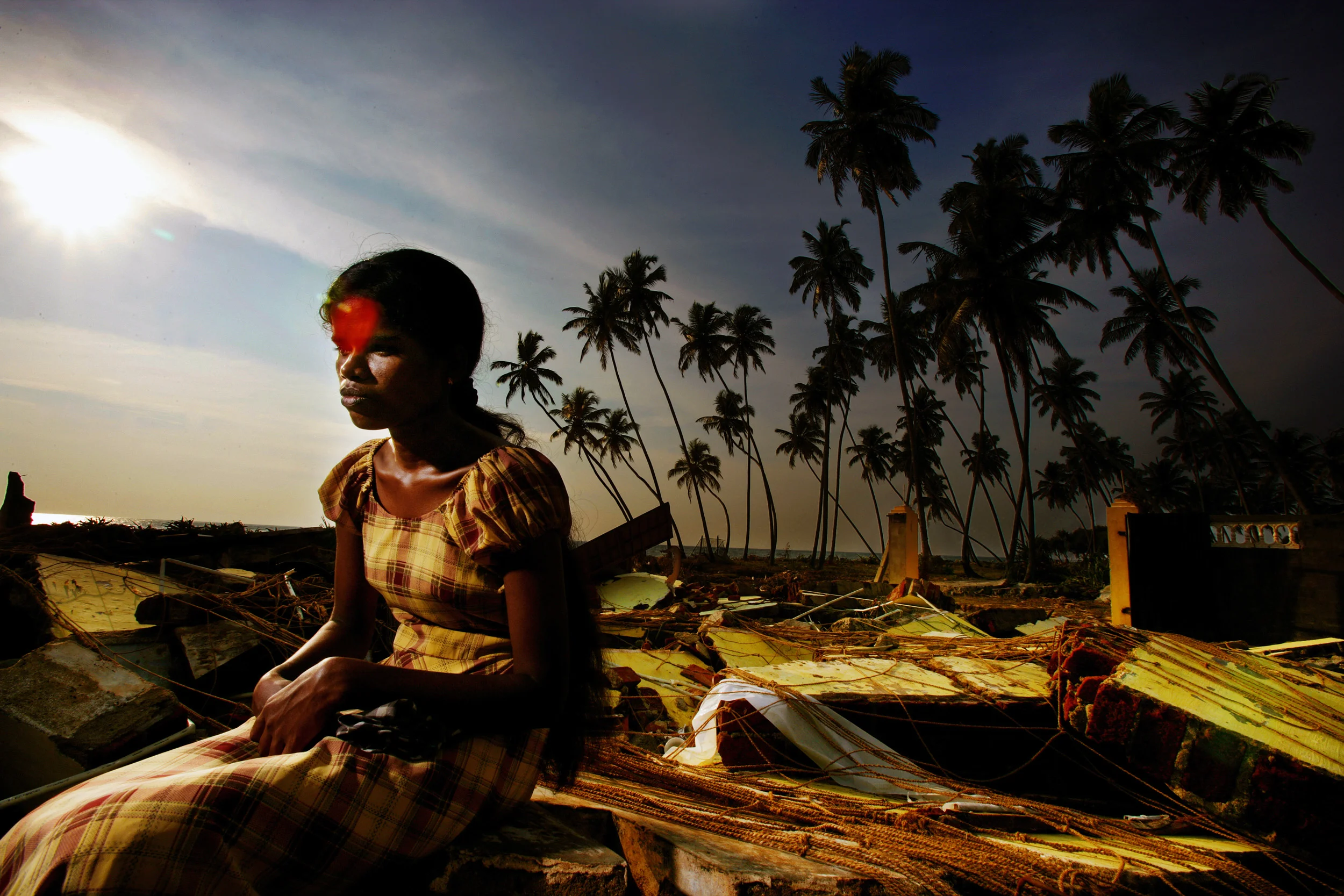
SOUTHERN SRI LANKA-NOVEMBER 2005: A Tsunami survivor sits and cries in the ruins of the house she used to share with her husband and two children. They were lost in the wave and she now lives in the ruins of the house trying to work out how to reclaim some part of her life. Photo by Brent Stirton/Getty Images

RP047cm3.tif

DHARMSALA, INDIA-DECEMBER 2003: Tibet's longest serving political prisoner Palden Gatso demonstrates how he was tortured by the Chinese prison guard using electric cattle prods. Gatso was imprisoned for peaceful protest. PHOTO BY BRENT STIRTON/GETTY IMAGES

BOR, SOUTH SUDAN, FEBRUARY 2013: A young woman recovers after just giving birth to twins in the Bor Hospital maternity ward, Bor, South Sudan, February 9, 2013. Early marriage is common in South Sudan, with girls as young as 12 essentially sold into a life of indentured labour and childbirth. This young woman was married at 12, she had her first child at 15, with a protracted 5 day labor. She is now 20 and the twins are her 4th and 5th child. There are moves to change early marriage in the legal system in South Sudan but this fledgling country is struggling with many issues and the fact that early marriage is a long established part of the culture is making this transition in thinking very difficult. (Photo by Brent Stirton/Reportage for Human Rights Watch.)

JUBA, SOUTH SUDAN, FEBRUARY 2013: A preganant student at Juba Day Secondary School, Juba, South Sudan, February 3, 2013. Girls who fall pregnant while at school in South Sudan are forced to leave school, but a local teachers union voted to allow pregnant girls and recently mothers to attend school in the afternoon and evening session so as to catch up on their education. Early marriage is common South Sudan and girls as young as 14 are often forced into marriages they have no say over, and fall pregant before their bodies are ready to handle the baby. (Photo by Brent Stirton/Reportage for Human Rights Watch.)

TROY, NEW YORK, 5 MAY 2014: Hillary Savoie takes her daughter outside for a bubble blowing session at their home in Troy, New york. Esme' Savoie, 3, suffers from a rare genetic disease know as PCDH19, a genetically mutated orphan disease of the kind which Novartis's N.I.B.R division feels they can learn a great deal, Troy, NY, 5 May 2014. Esme's parents Hillary and Andre Savoie have become experts in Esme's syndrome and are involved in fundraising for continued research and are a study case for Boston Childrens hospital and Novartis. PCDH19 Female Limited Epilepsy has been diagnosed in approximately 200 girls and women worldwide. PCDH19 FLE have been associated with the occurrence of epilepsy, a spectrum of developmental delays, and behavioral issues that occur almost exclusively in girls and women. Novartis is one of the few big pharmaceutical companies which is doing extensive research into diseases of the brain. This is particularly important now as autism numbers are increasing and it is estimated that as many as 1 in 50 children is currently affected by this syndrome in one from or another. Novartis has made remarkable strides in their developments and Ricardo Dolmetsch, head of research, feels confident of major breakthroughs in the next few years. PCDH19 FLE (EFMR) has a spectrum of symptoms. Almost all of the girls affected by PCDH19 mutations exhibit seizures of many types, but the most typical characteristic of PCDH19 FLE (EFMR) is the tendency of the seizures to cluster and interfere with breathing (causing cyanotic spells). Some of the girls affected with PCDH19 FLE (EFMR) have cognitive delays, much of the research indicates that about two-thirds of the girls have Intellectual Delay (ID) ranging from mild to moderate. Additionally, about 40% of the girls with PCDH19 FLE (EFMR) are on the autism spectrum. Many of those with PCDH19 also exhibit behavioral and psychological problems including aggression, obsessive-compulsive disorder, and, in some cases,


The last year South Africa had prisoners on death row.

BOLGATANGA, GHANA-JANUARY 2004: A man blinded by Trachoma, a preventable disease of the eyes conected to poor hygiene and lack of access to clean water. (PHOTO BY BRENT STIRTON/REPORTAGE BY GETTY IMAGES.)
